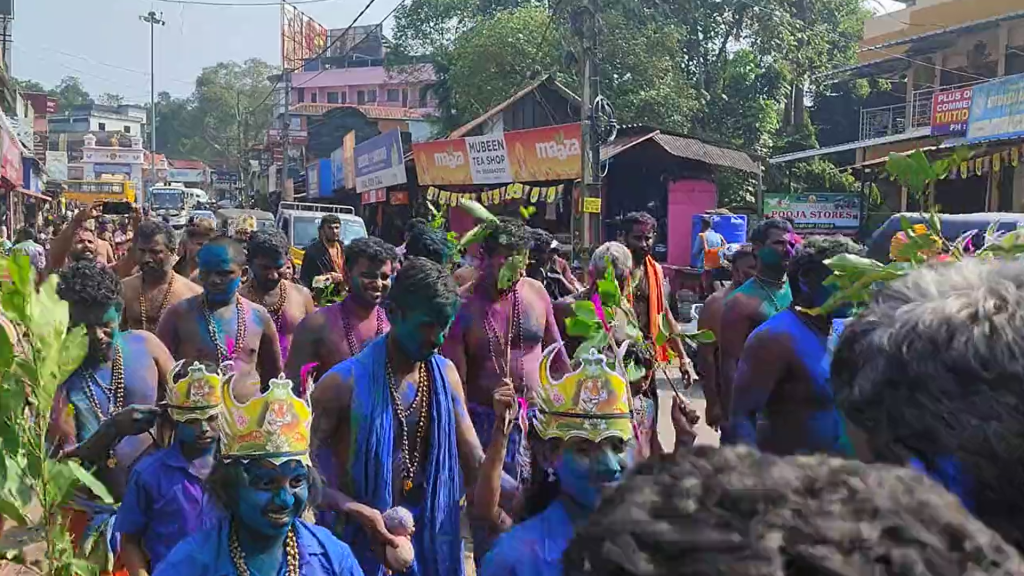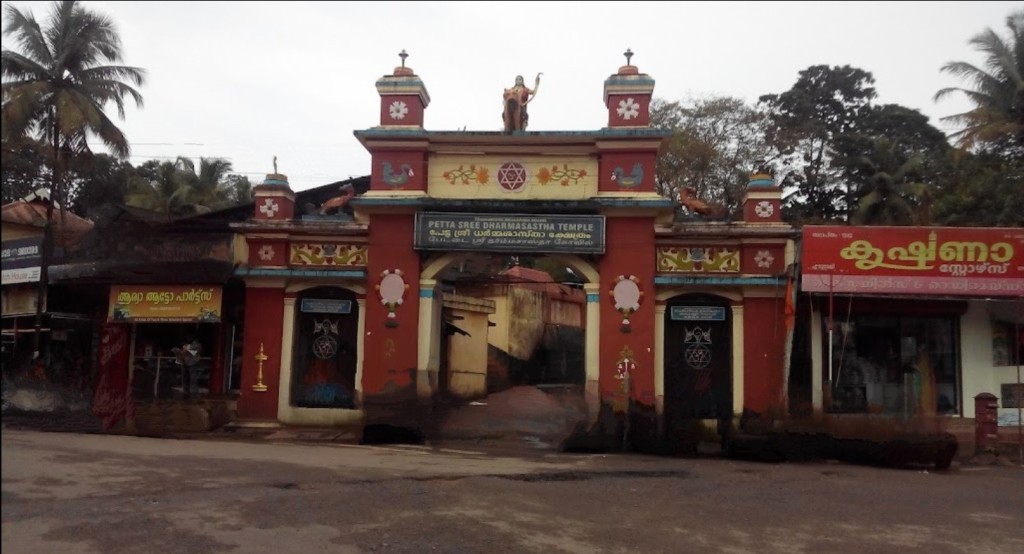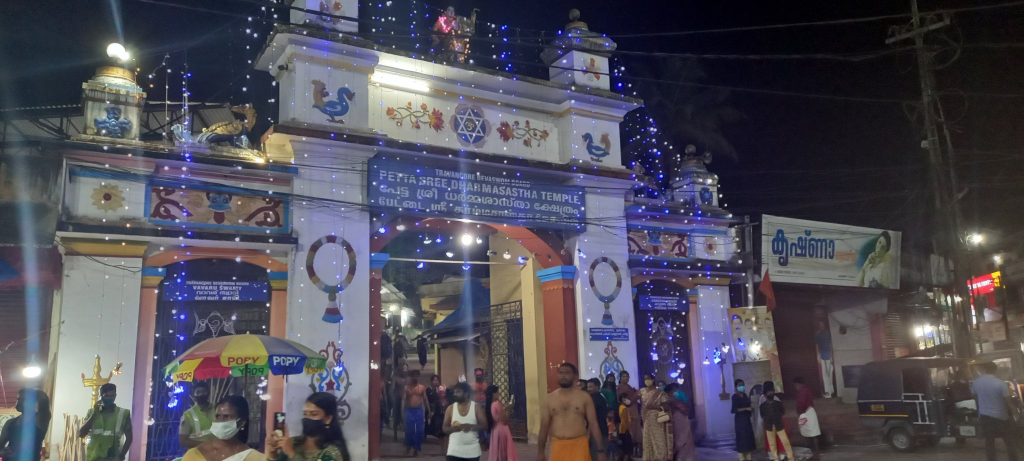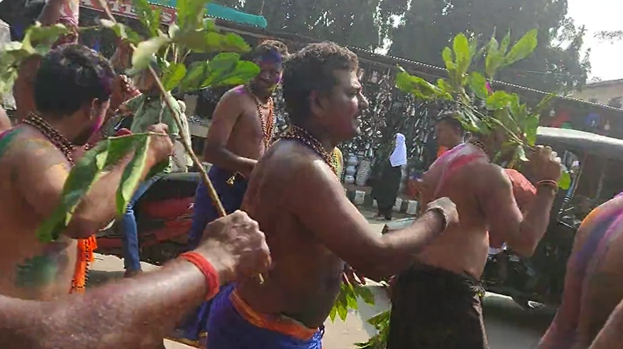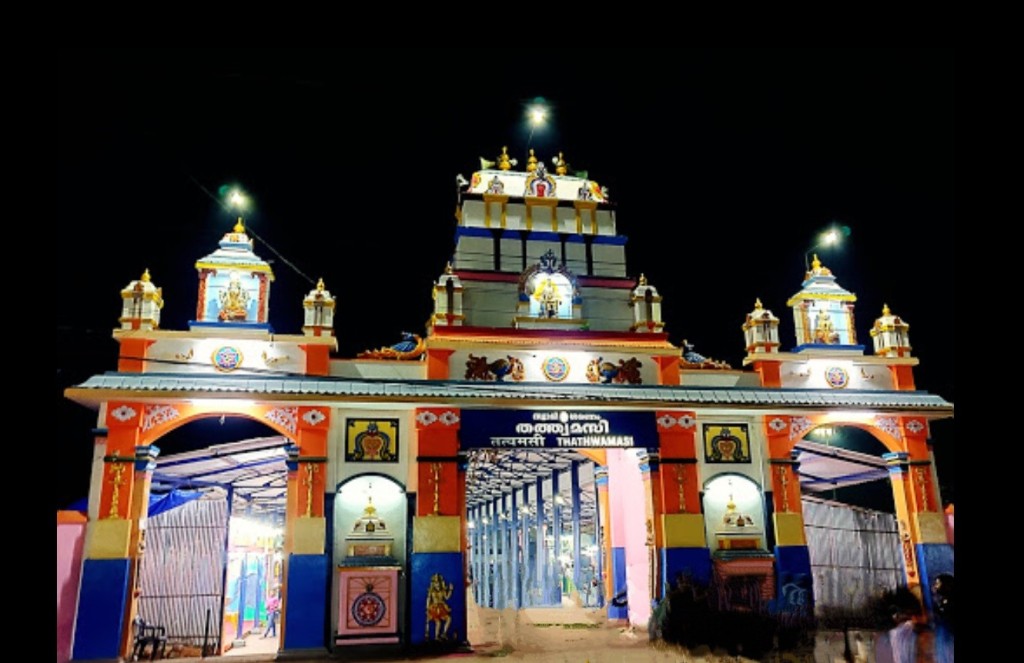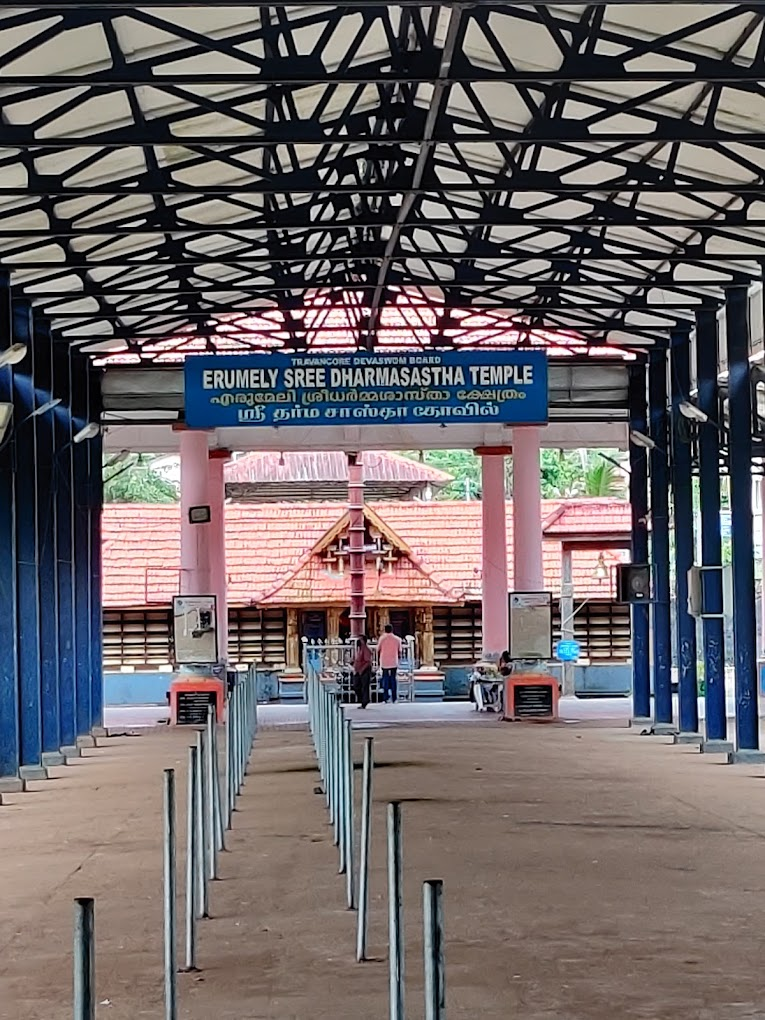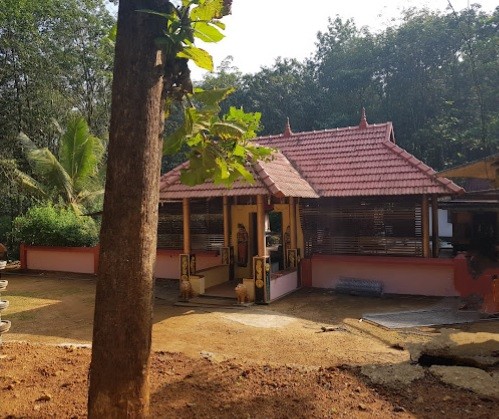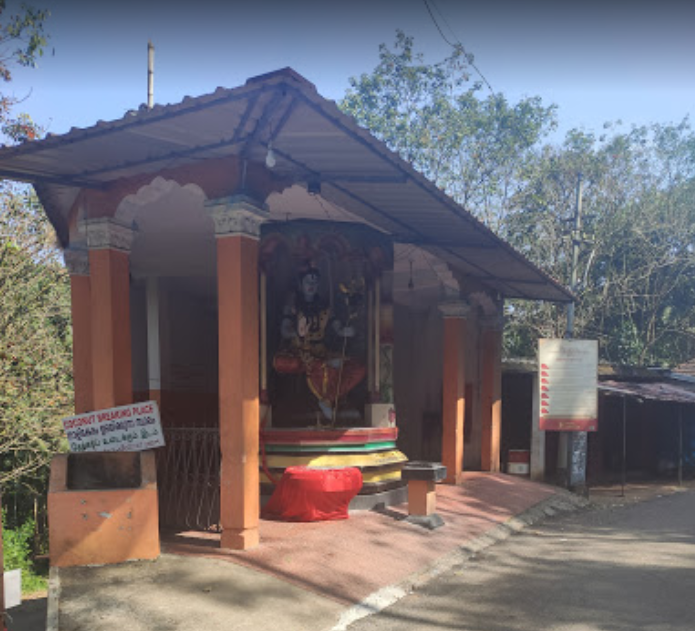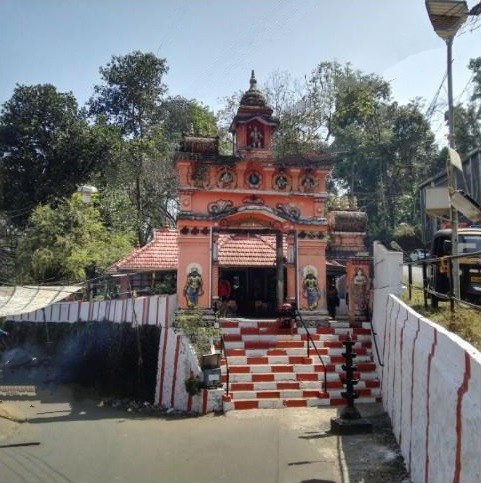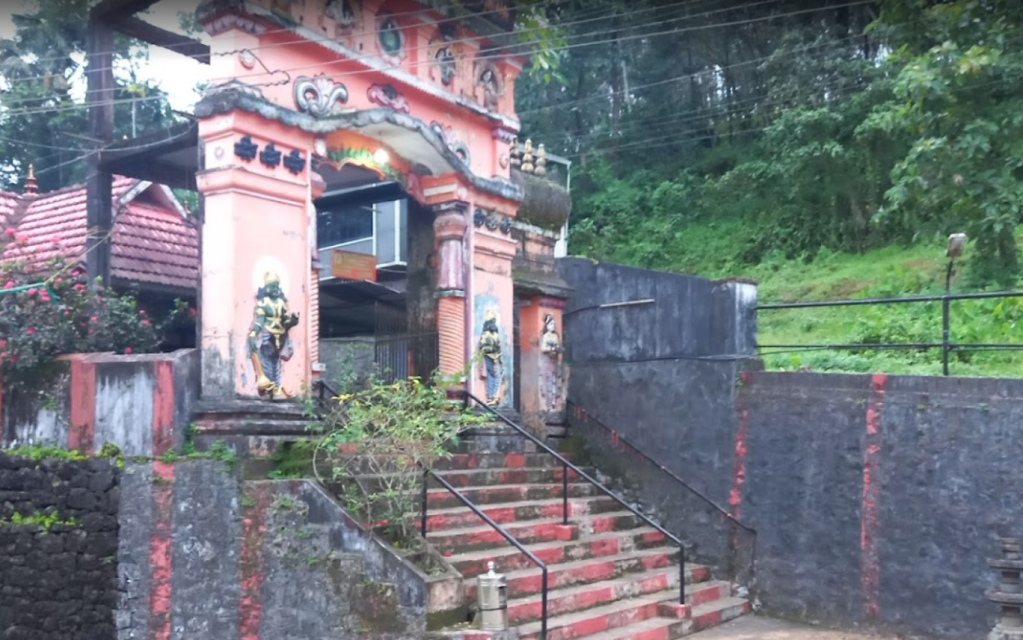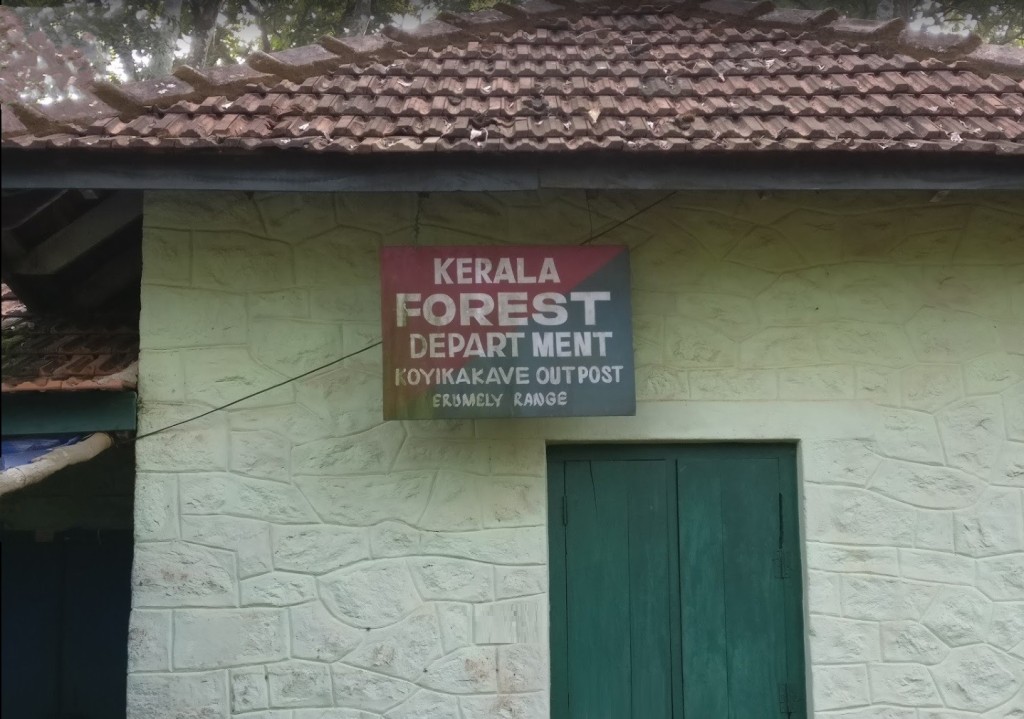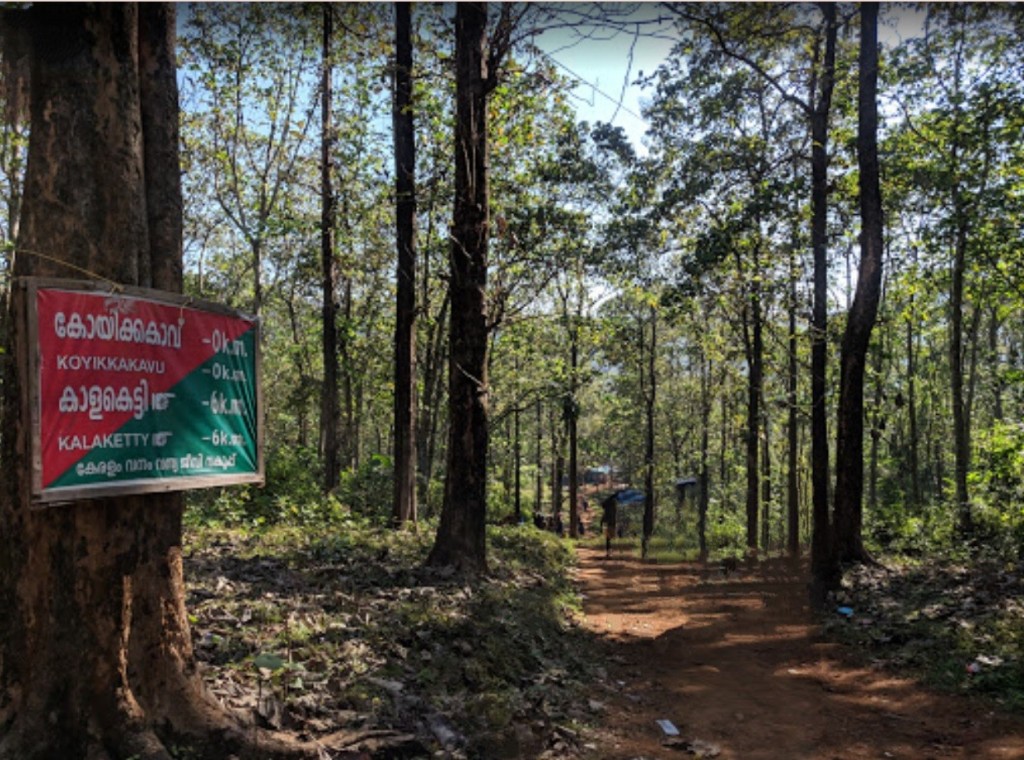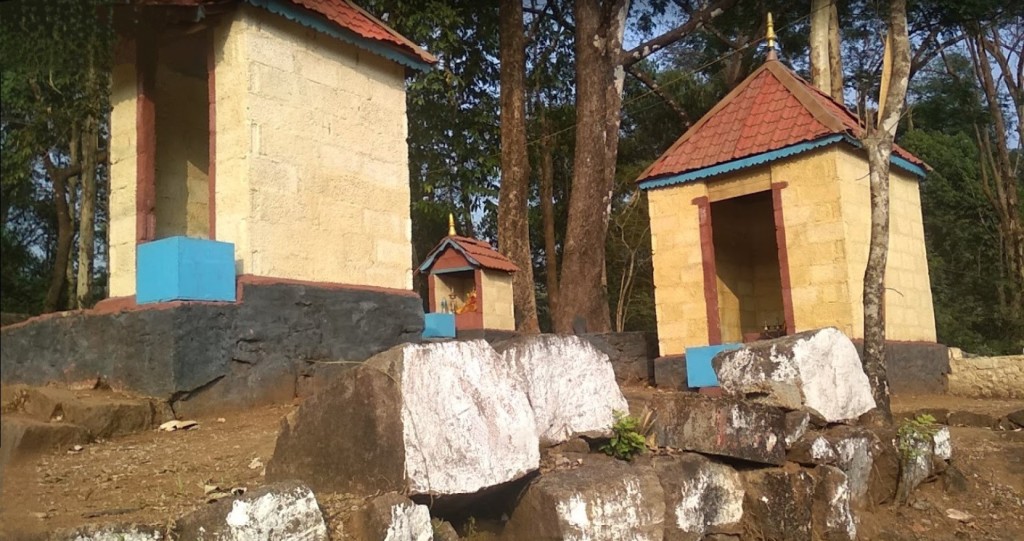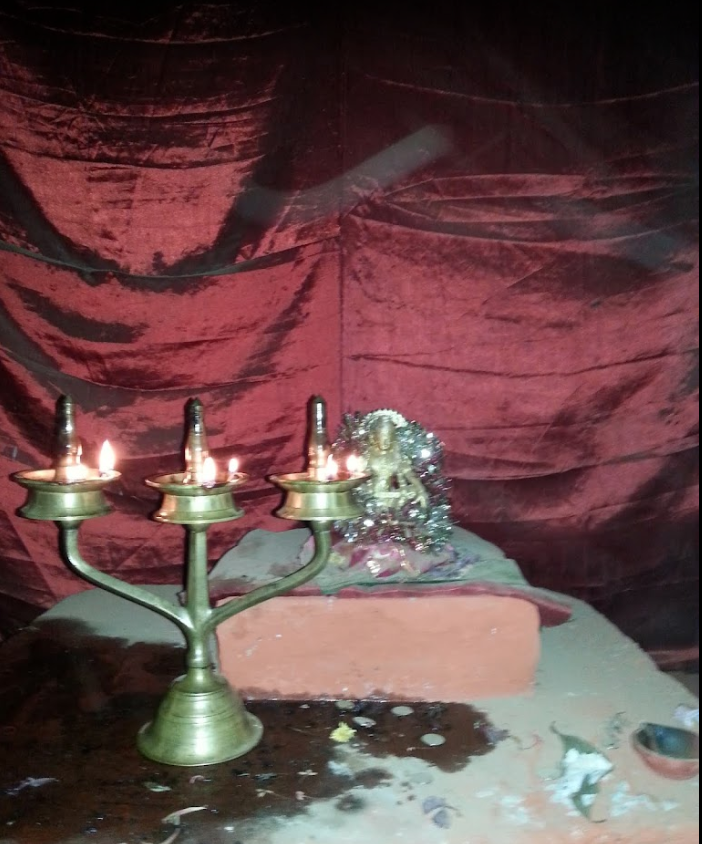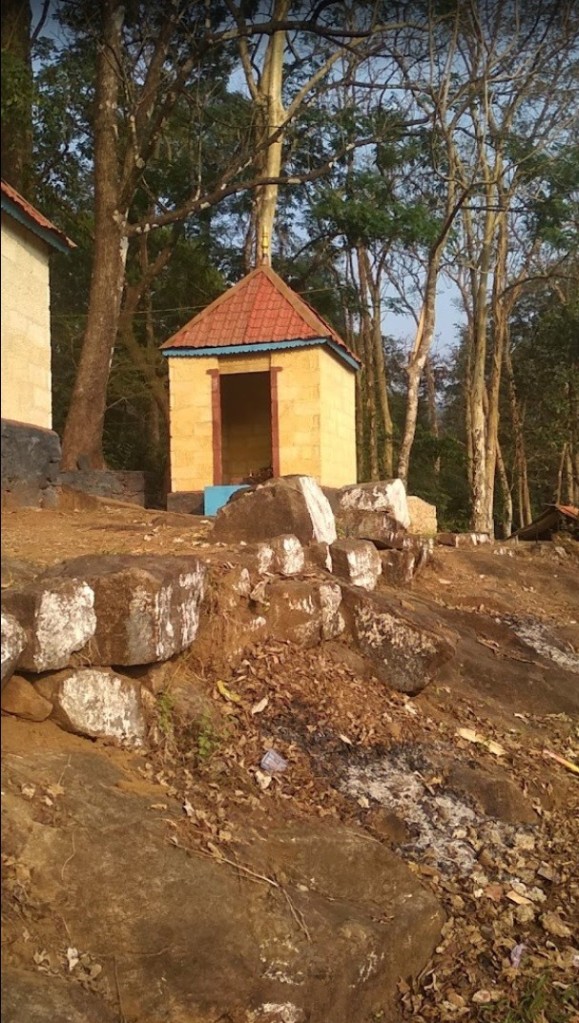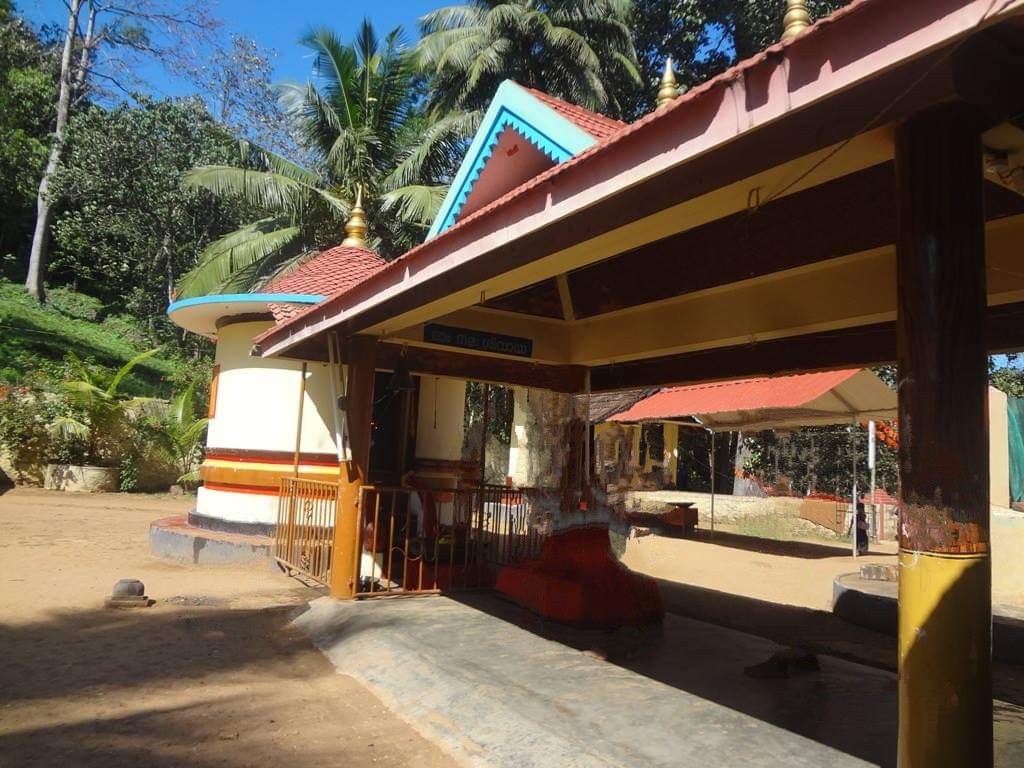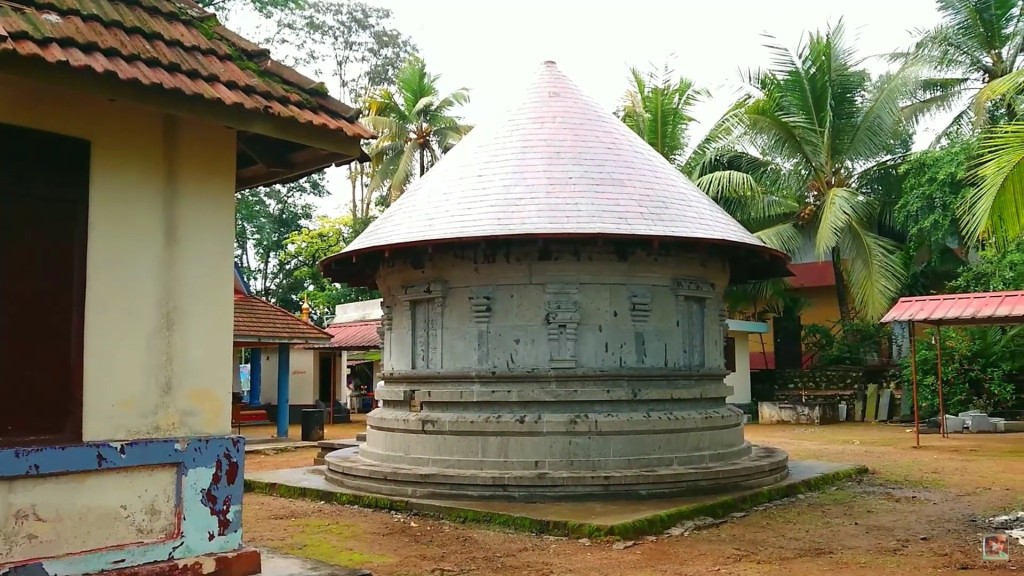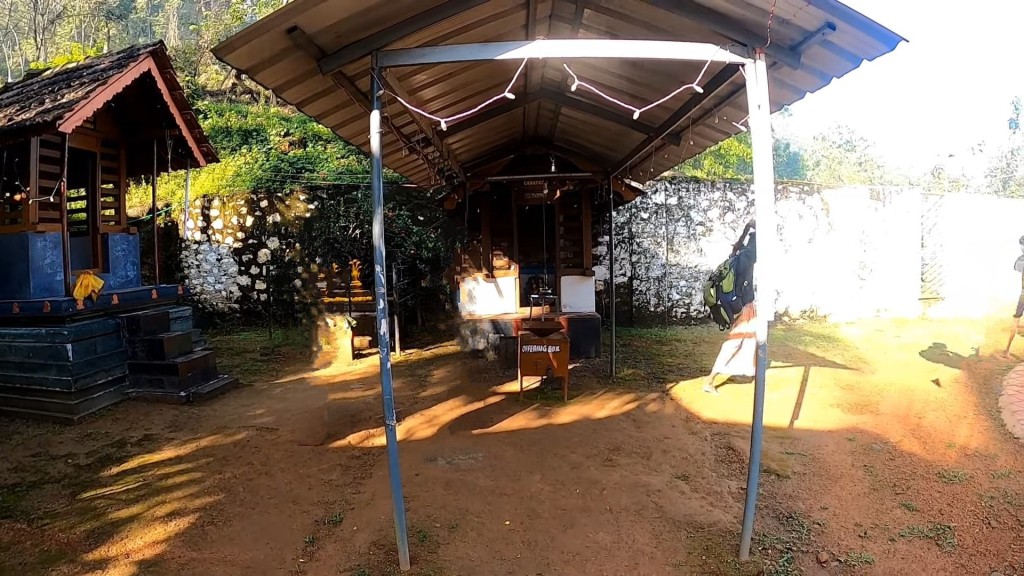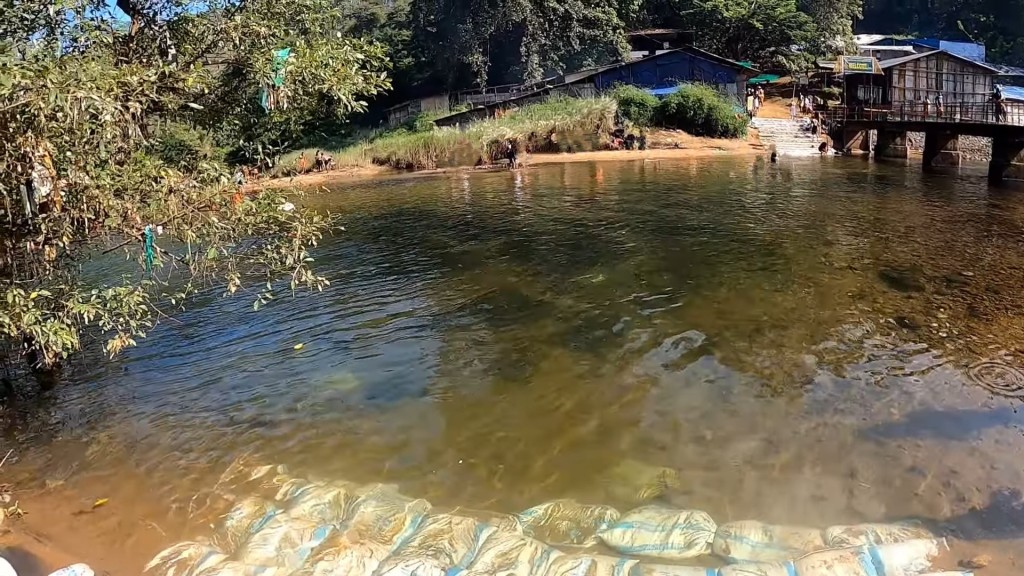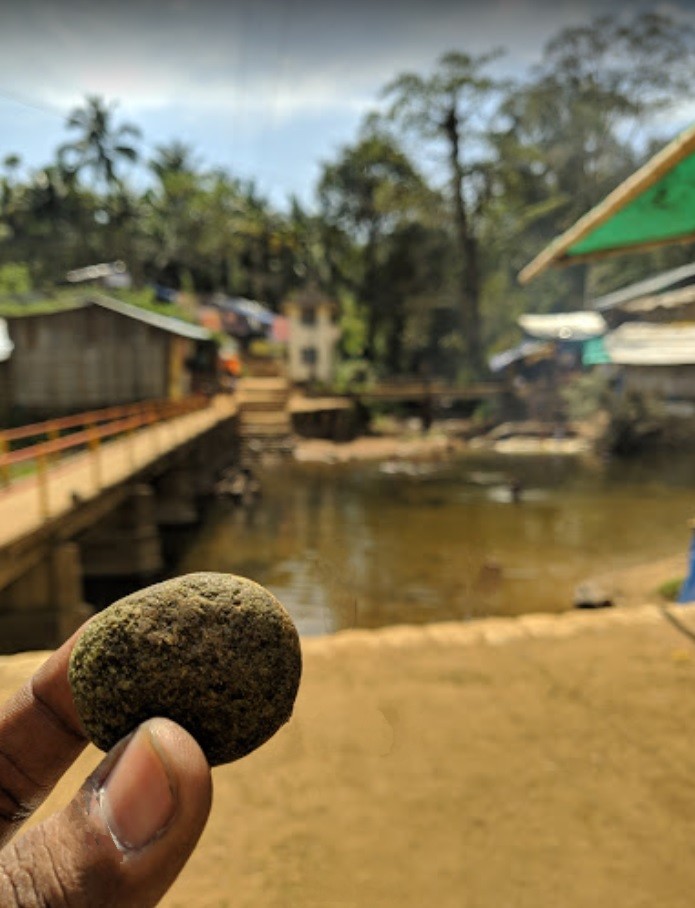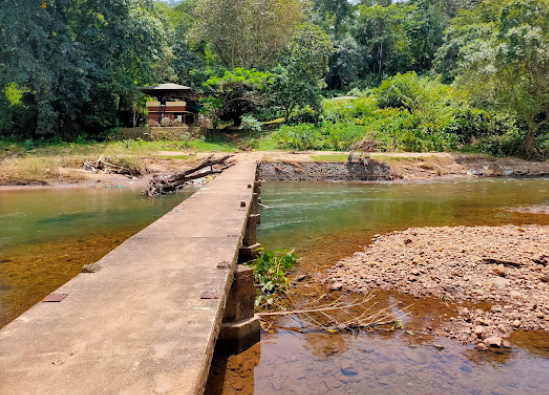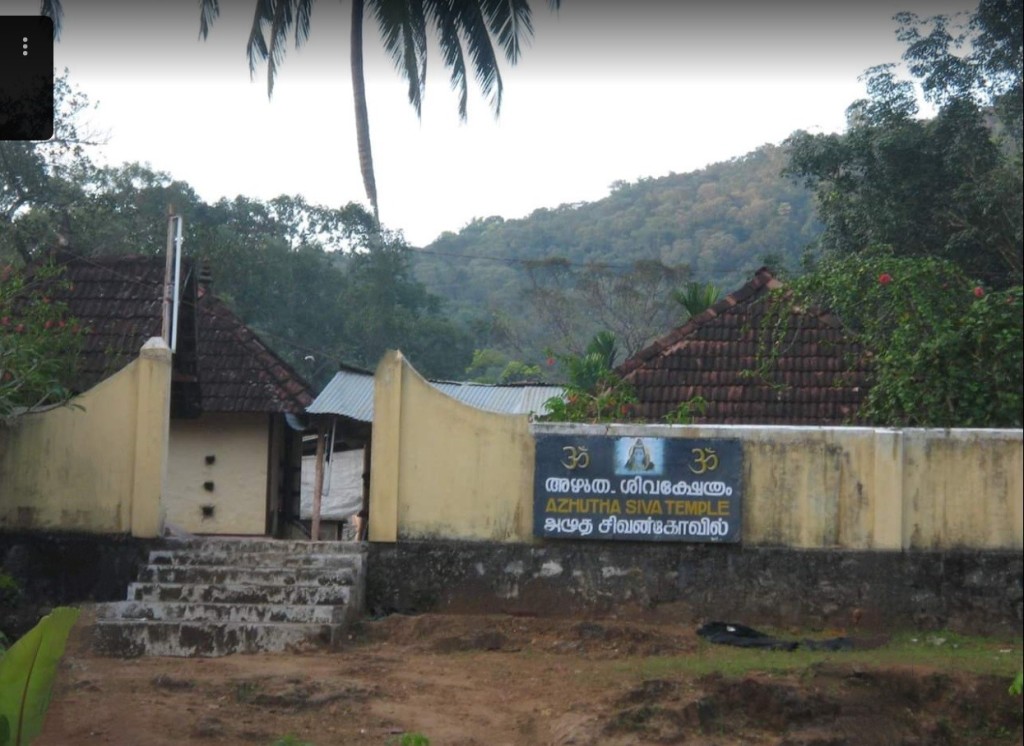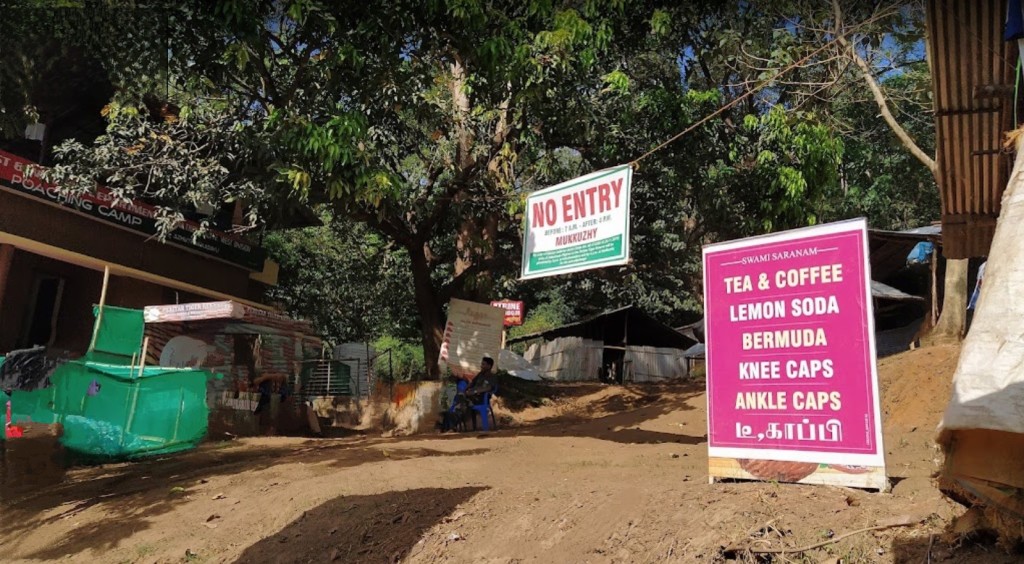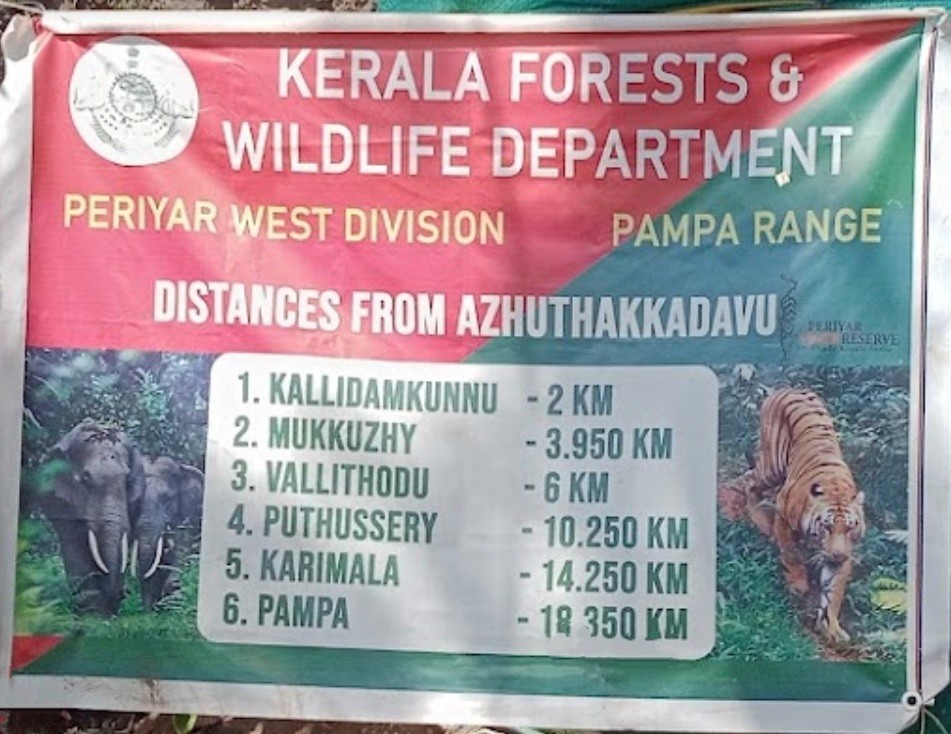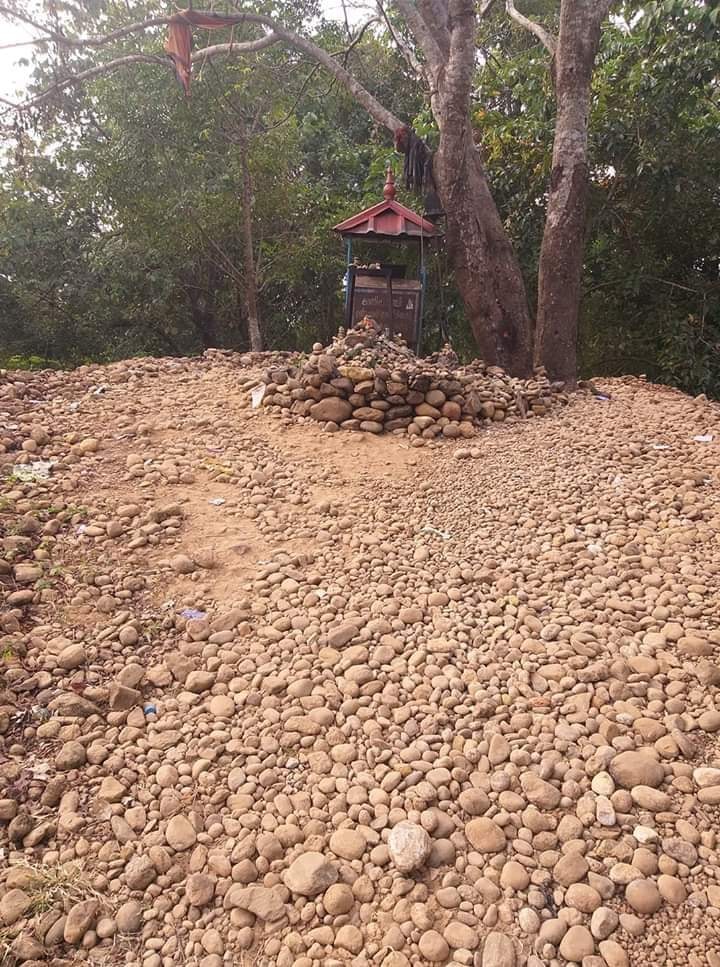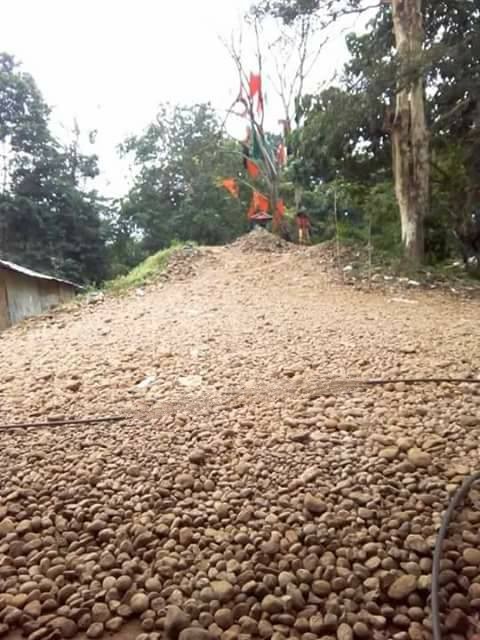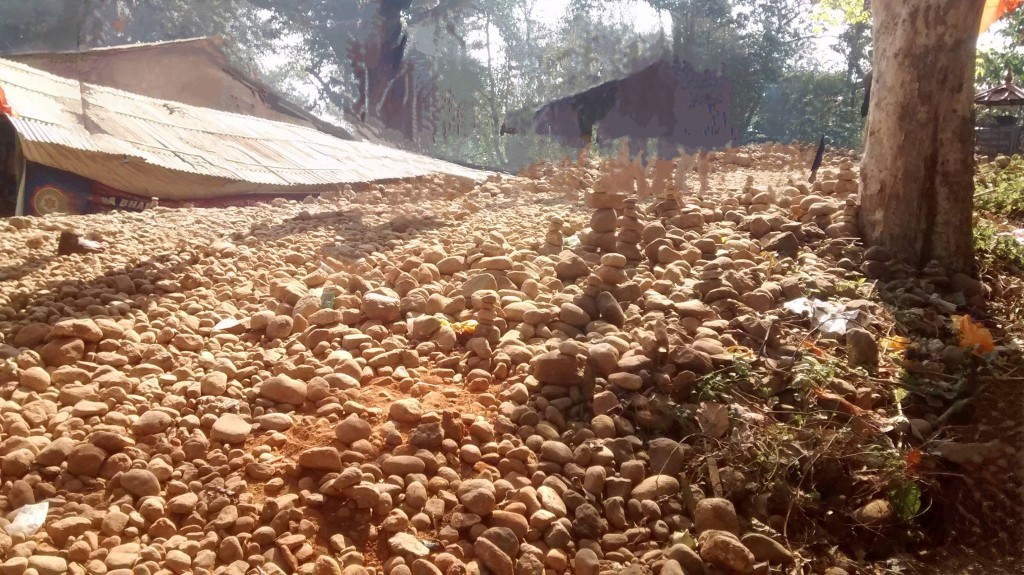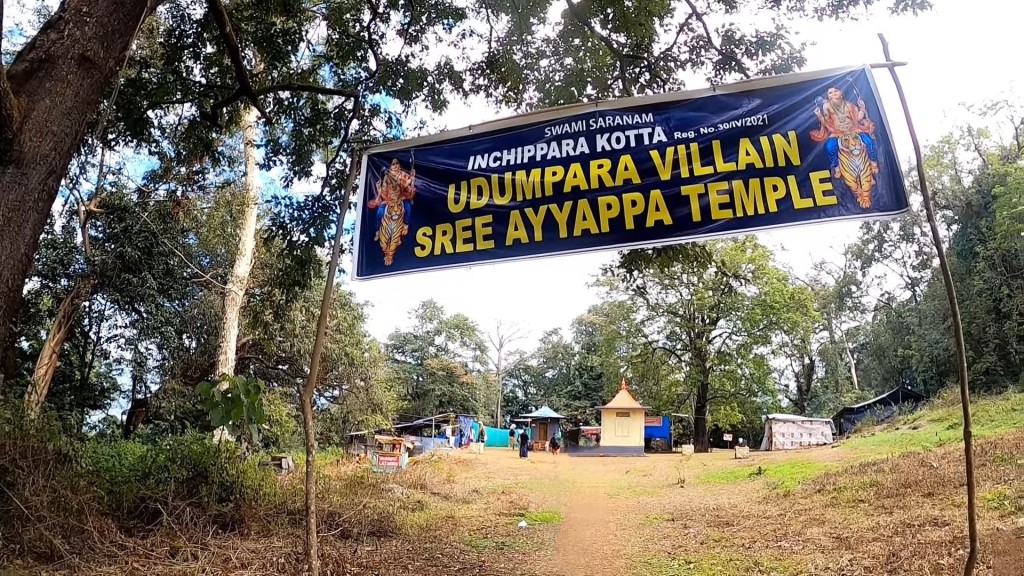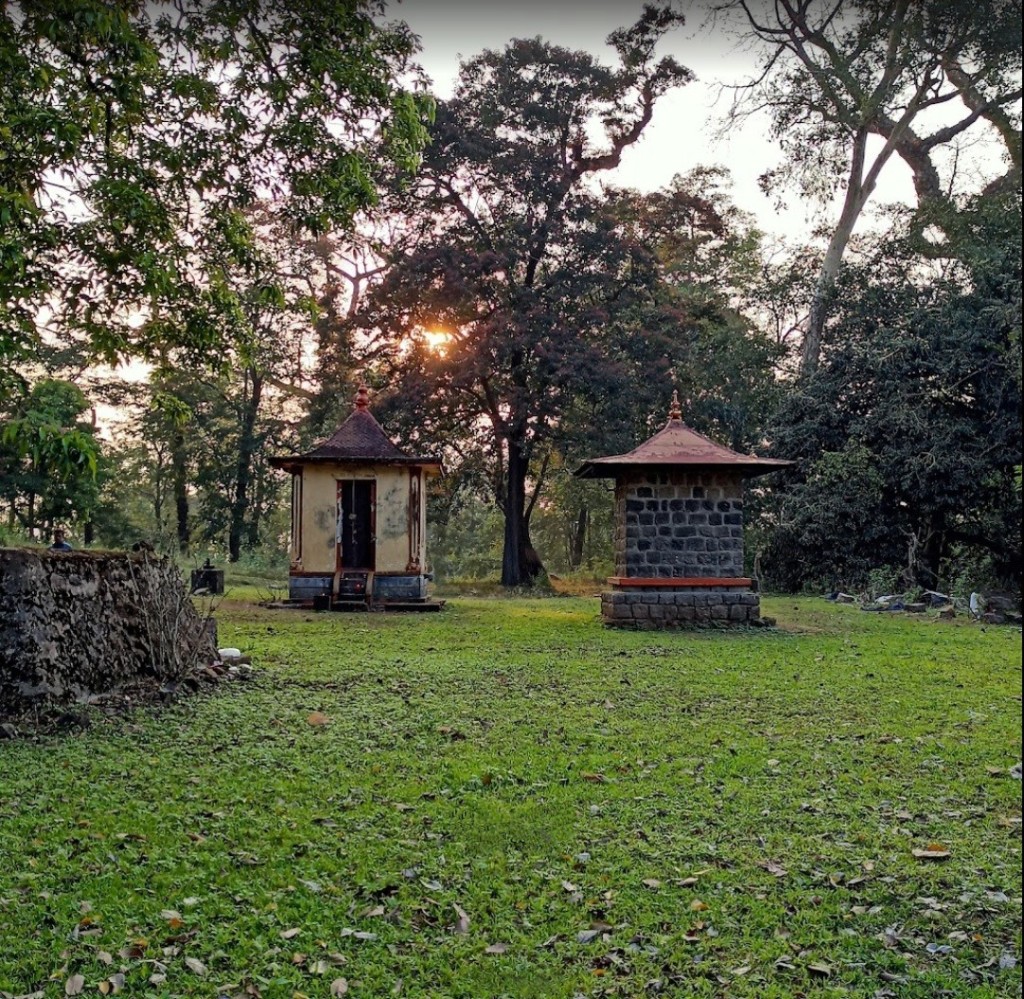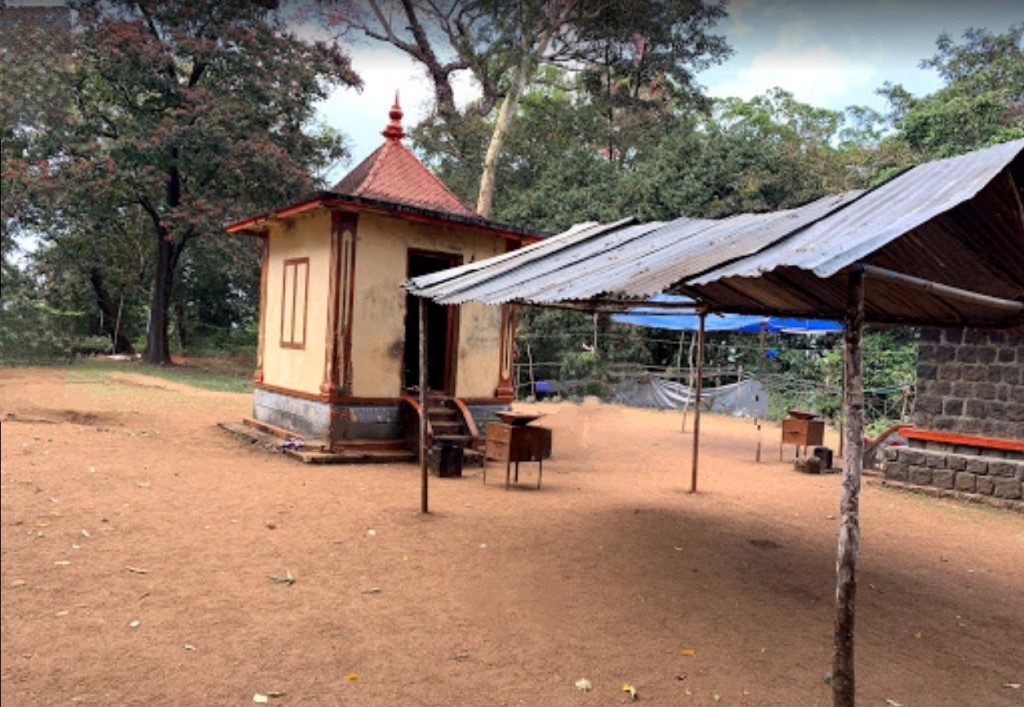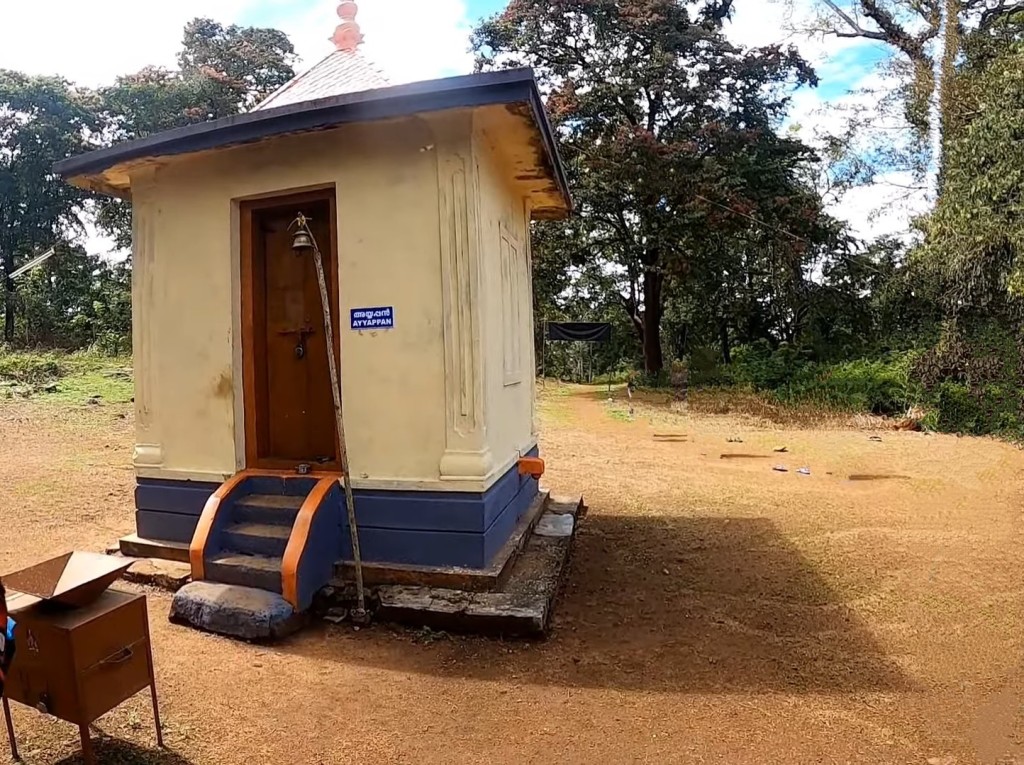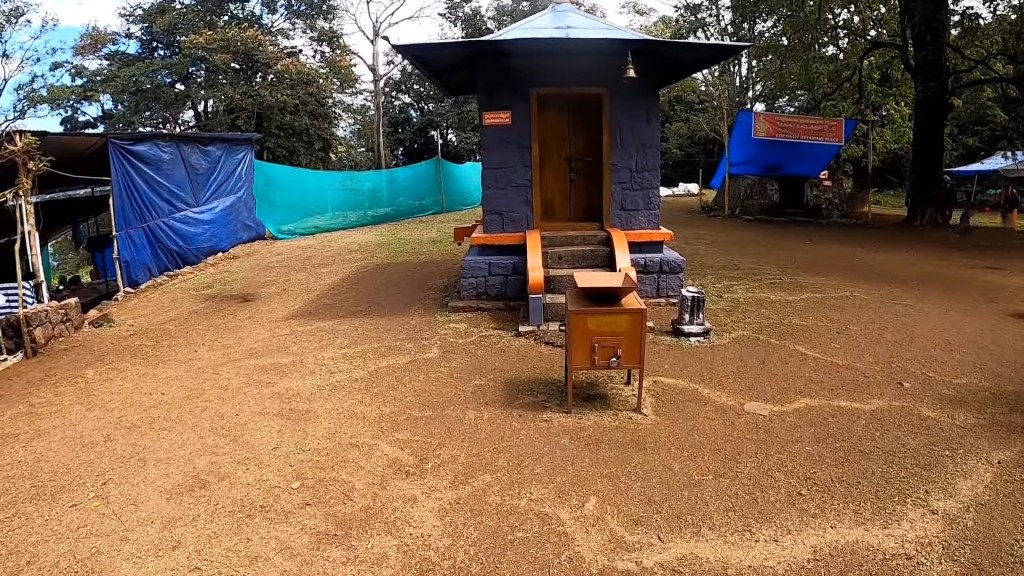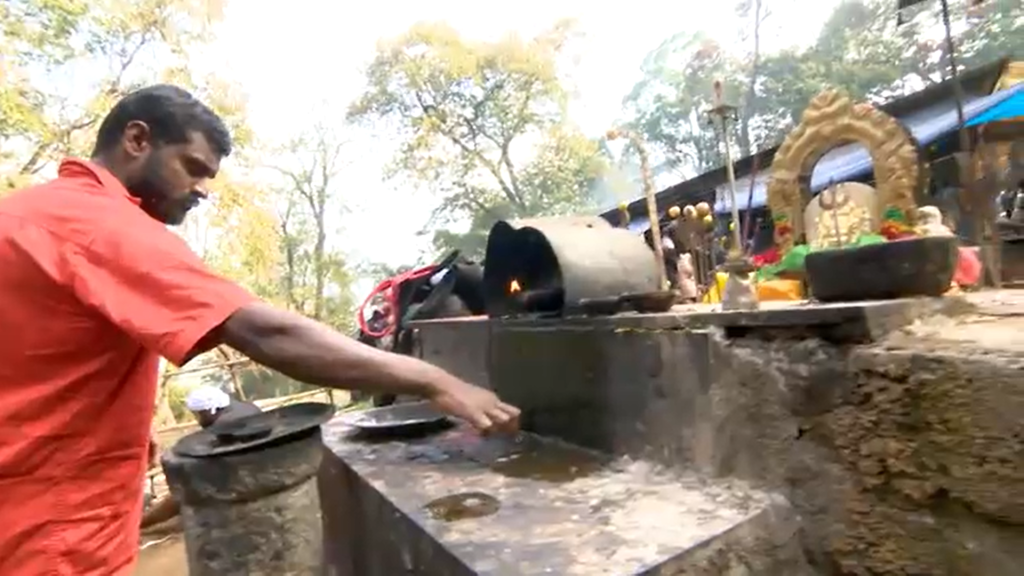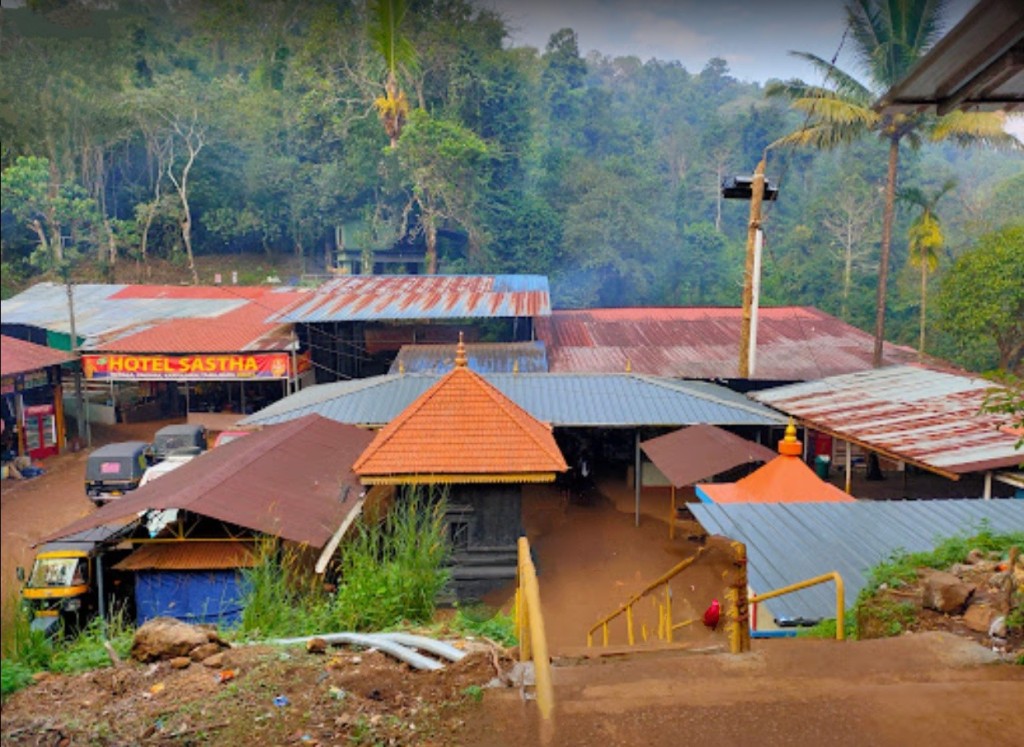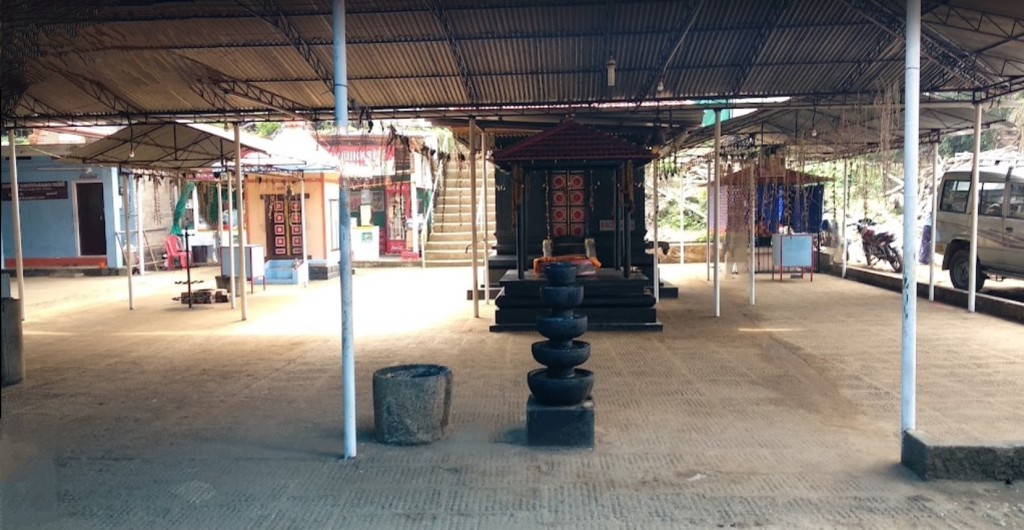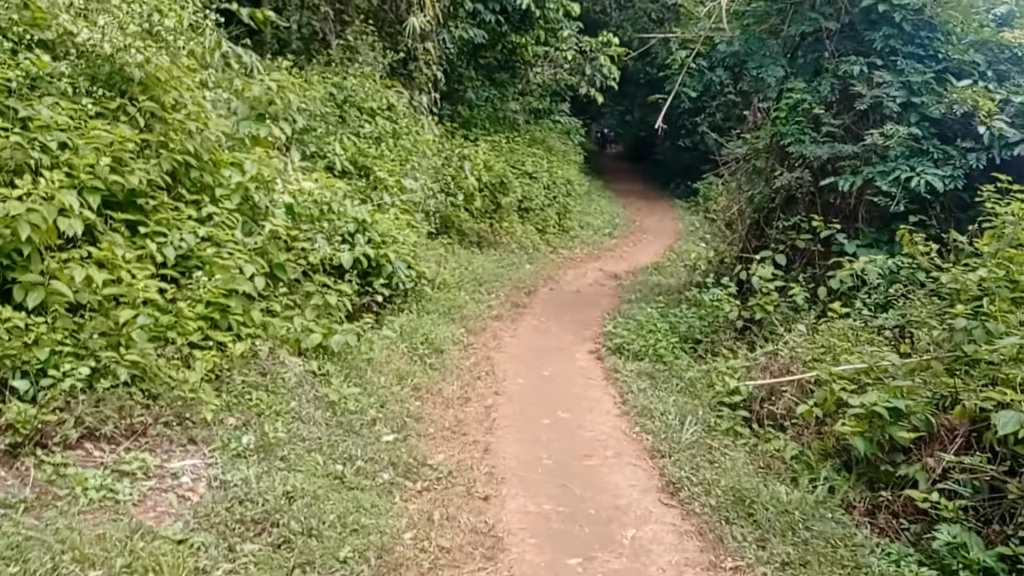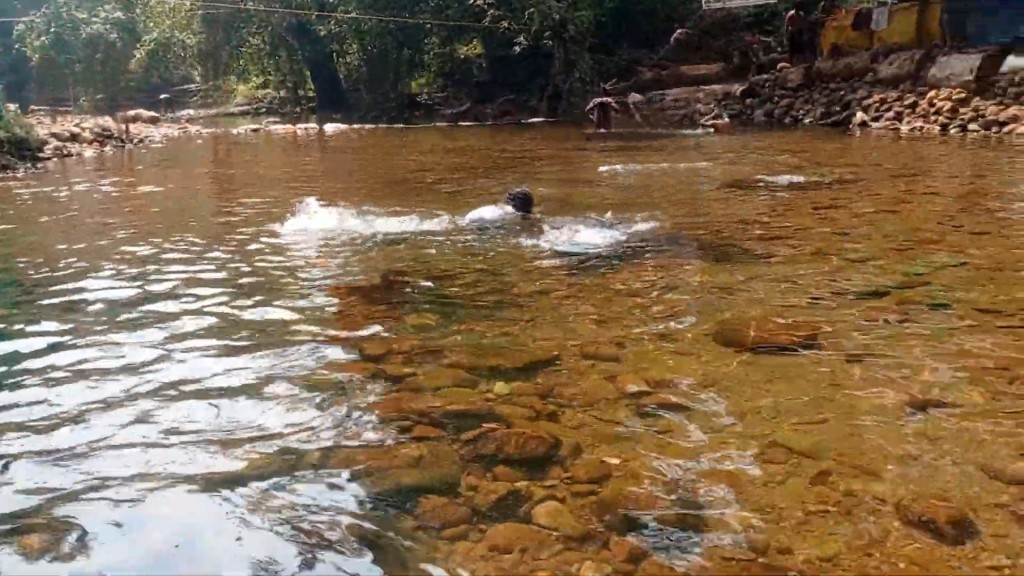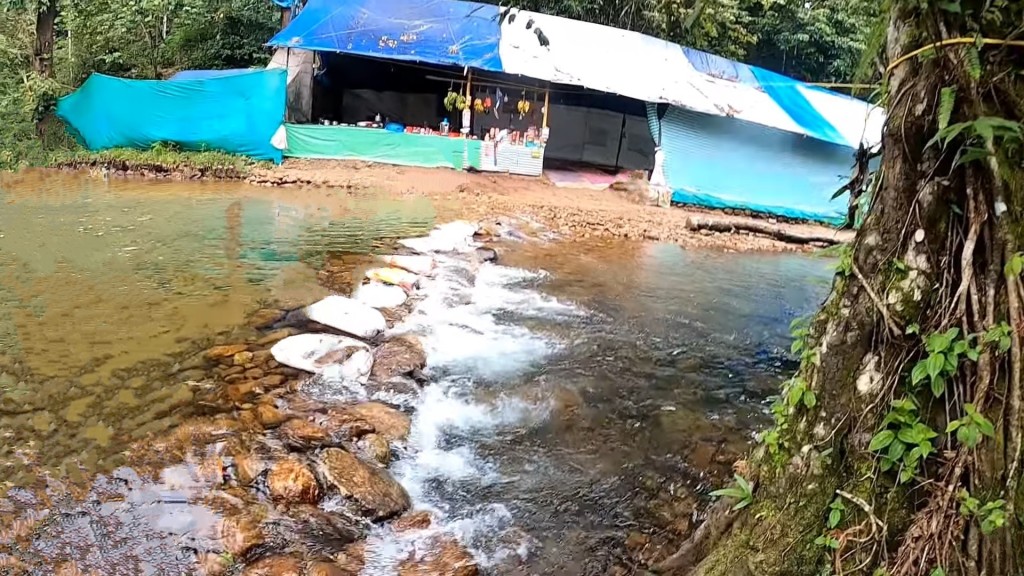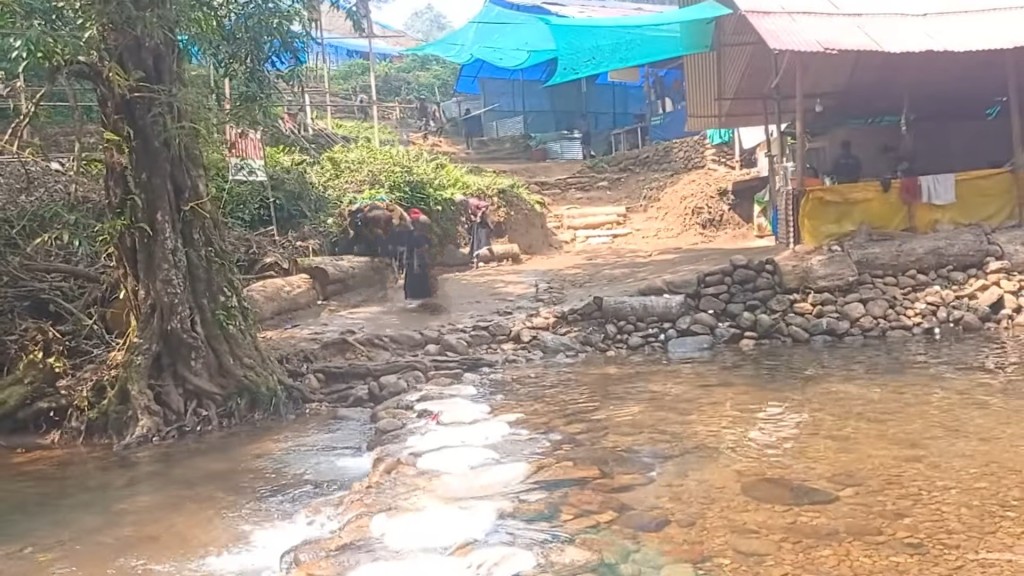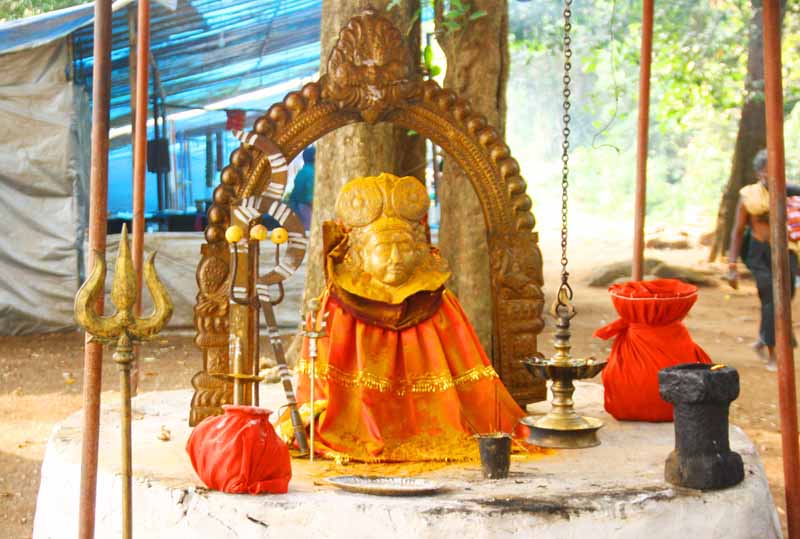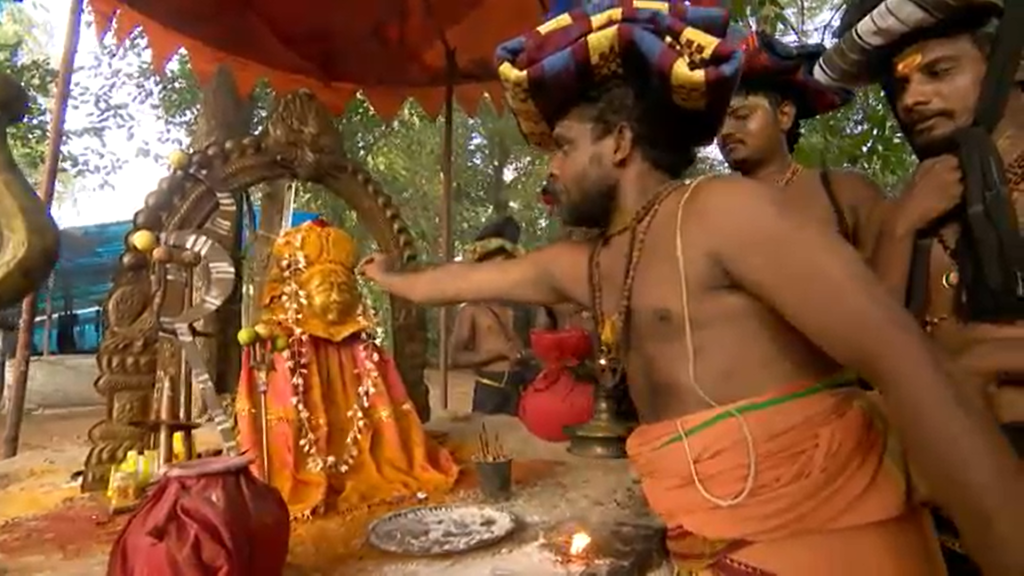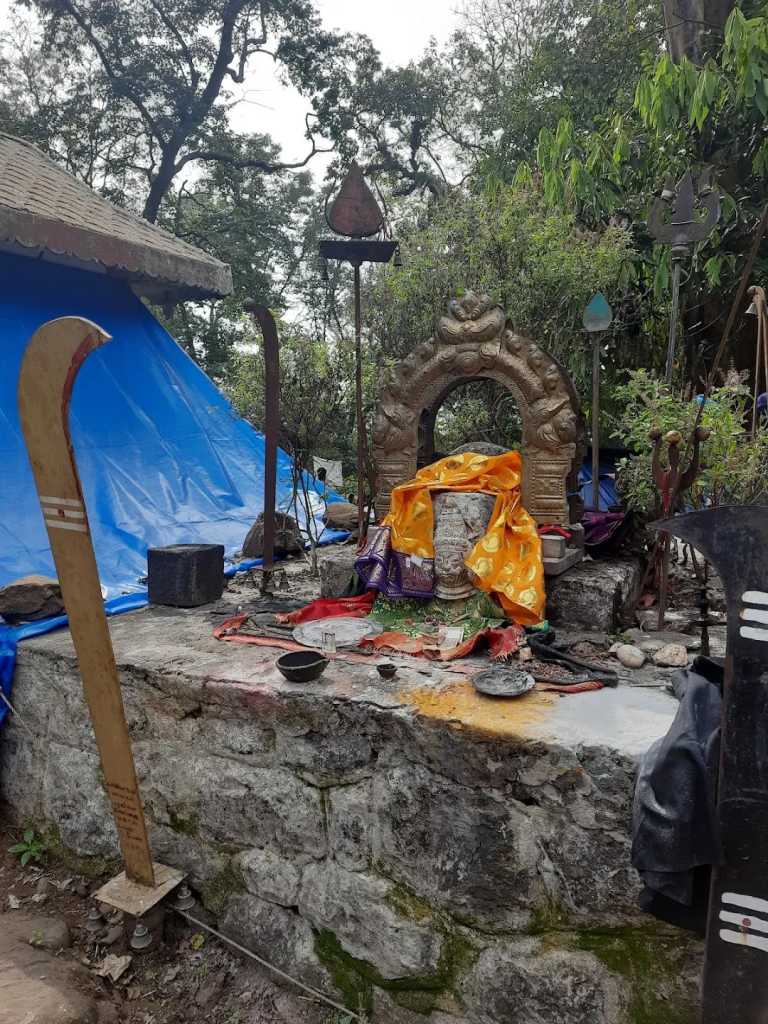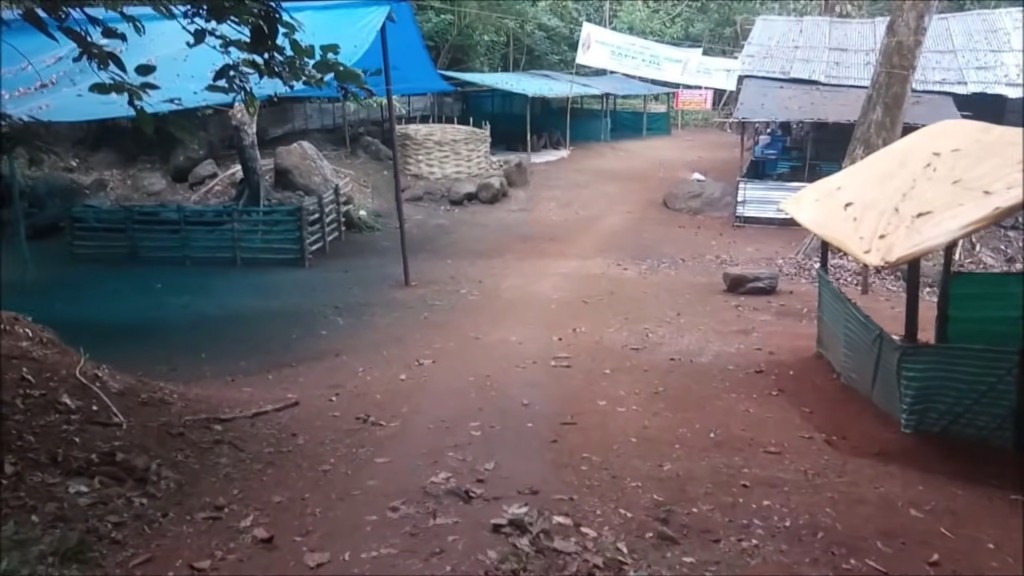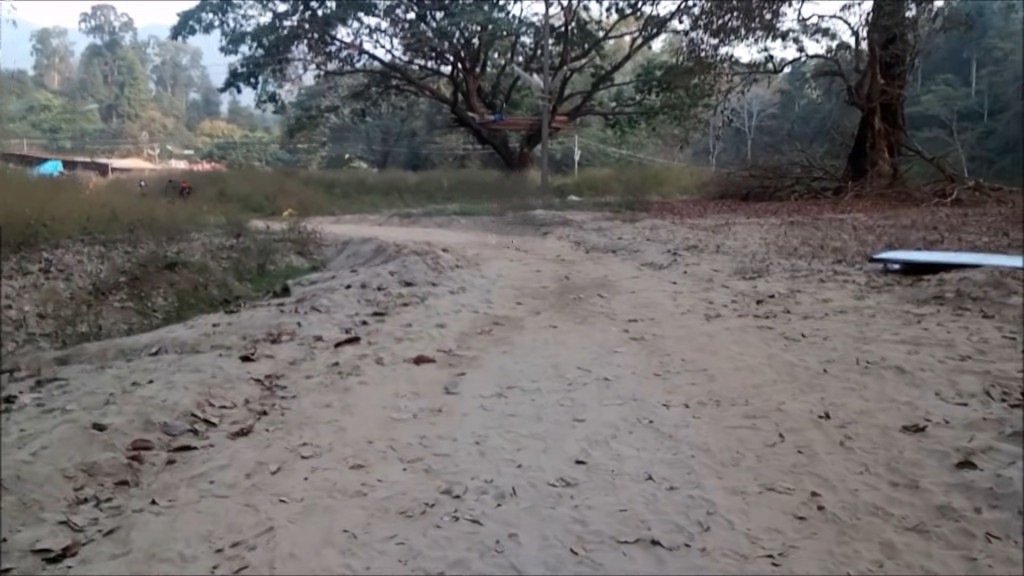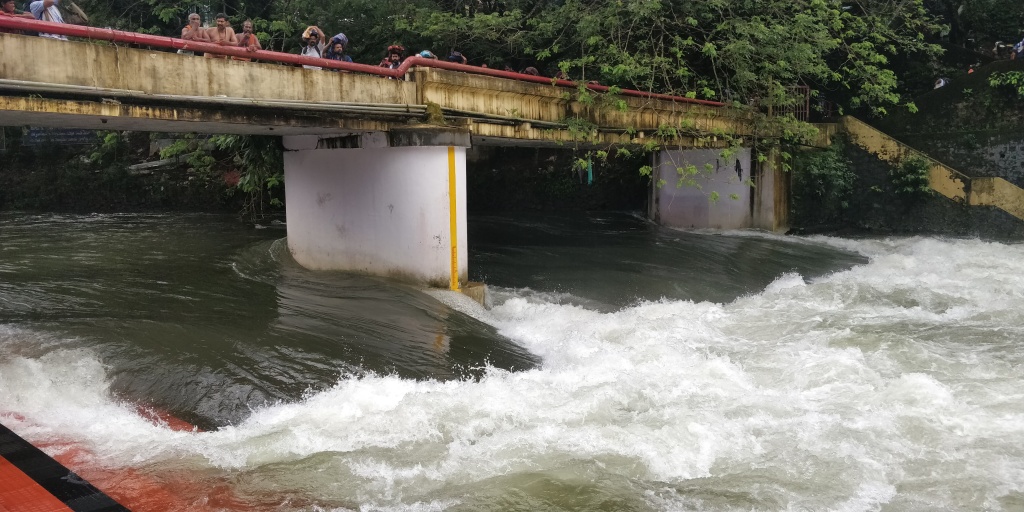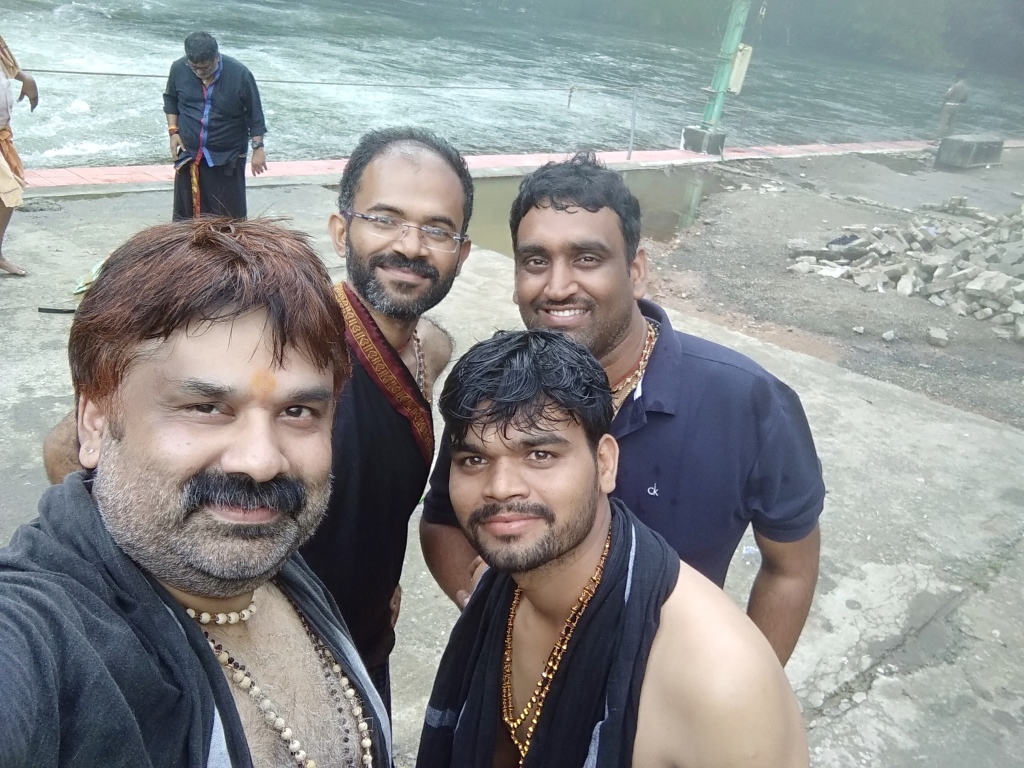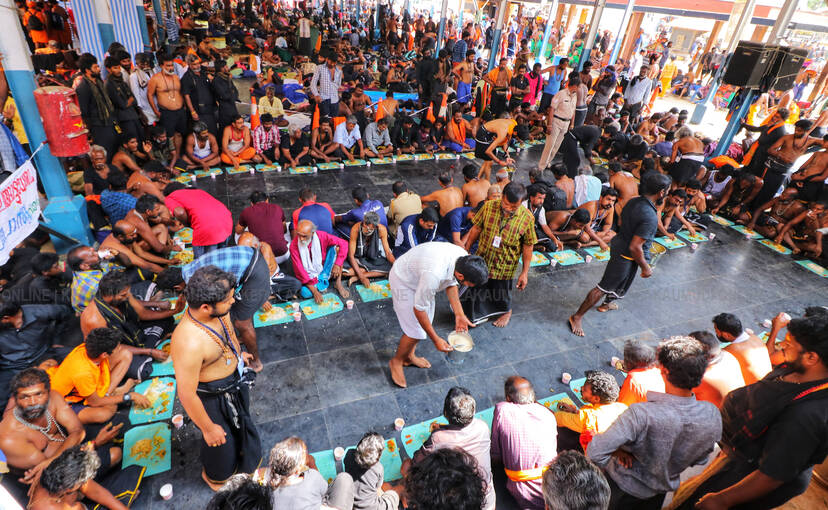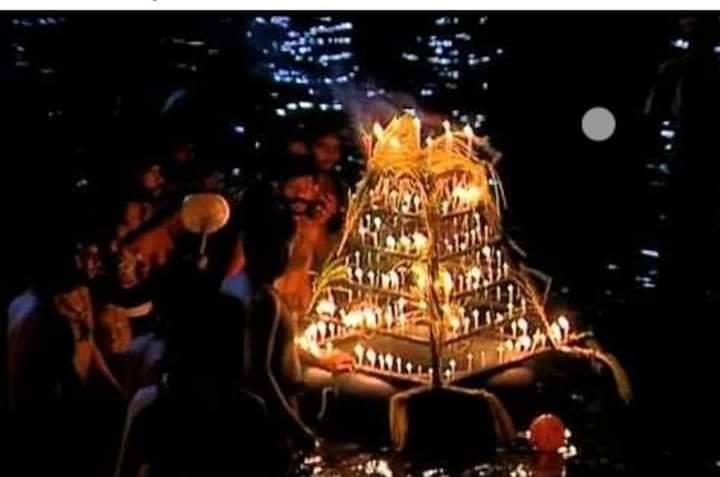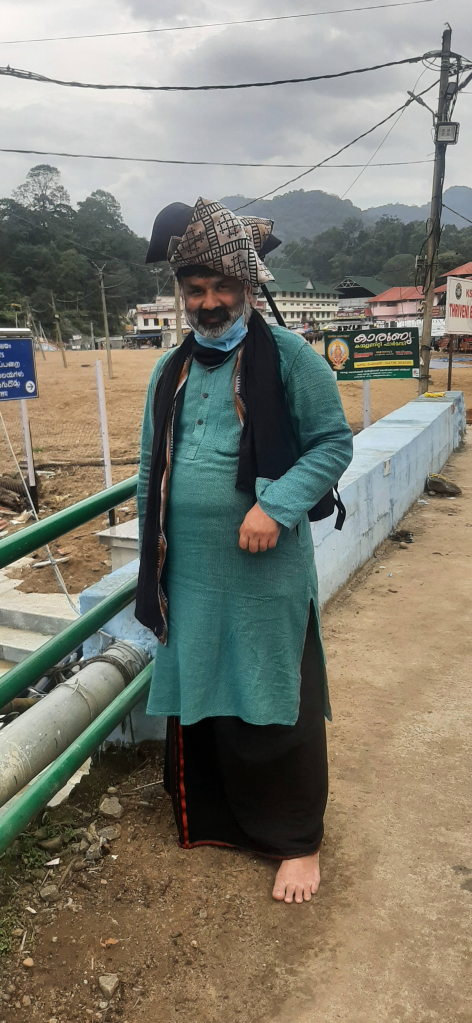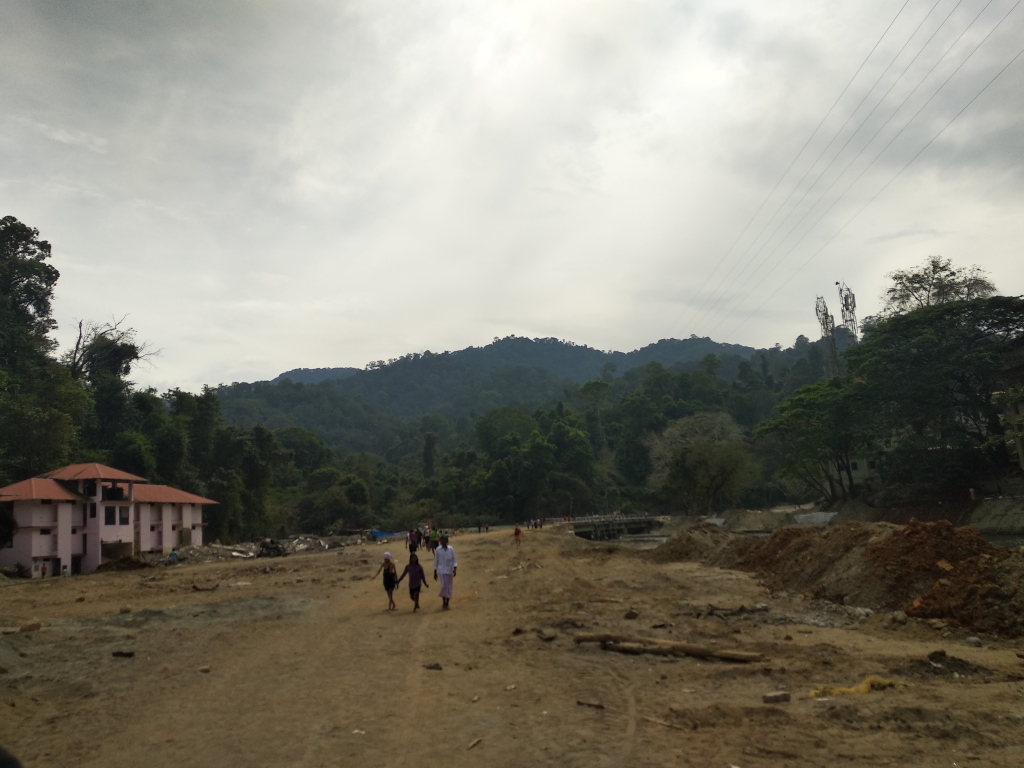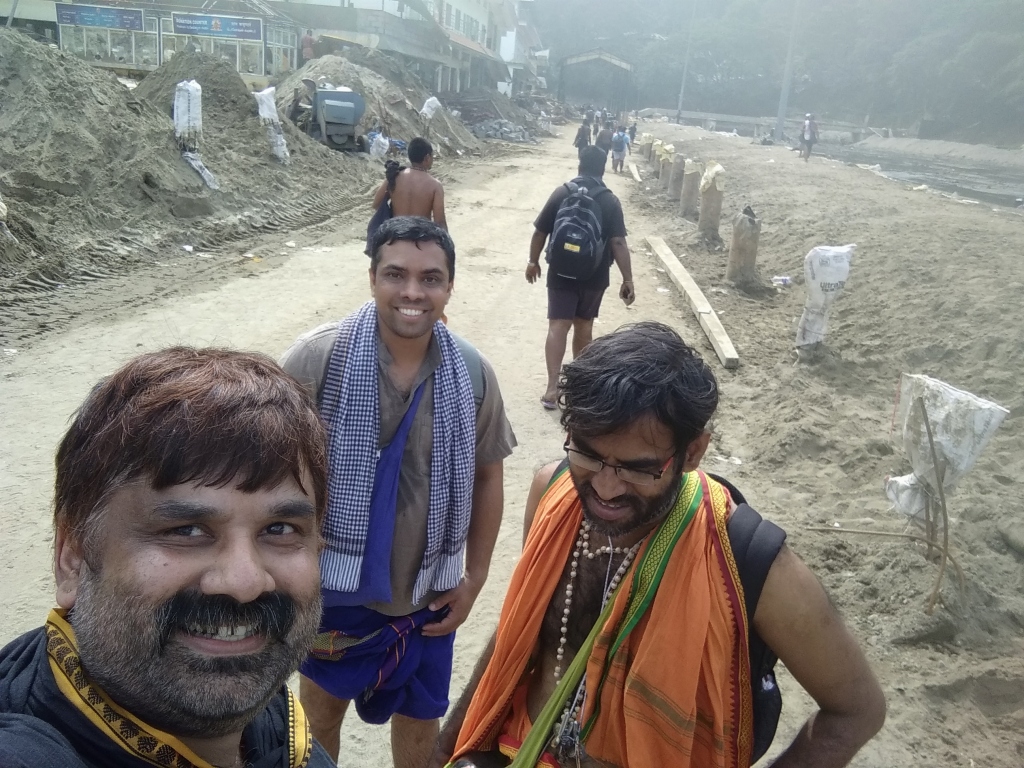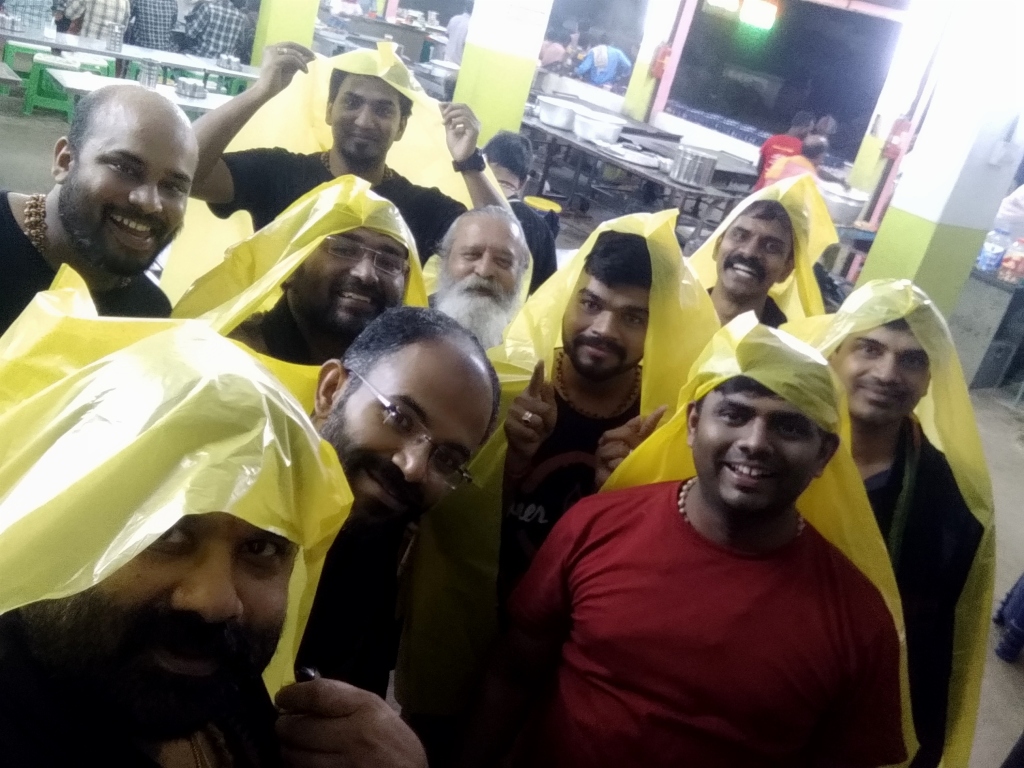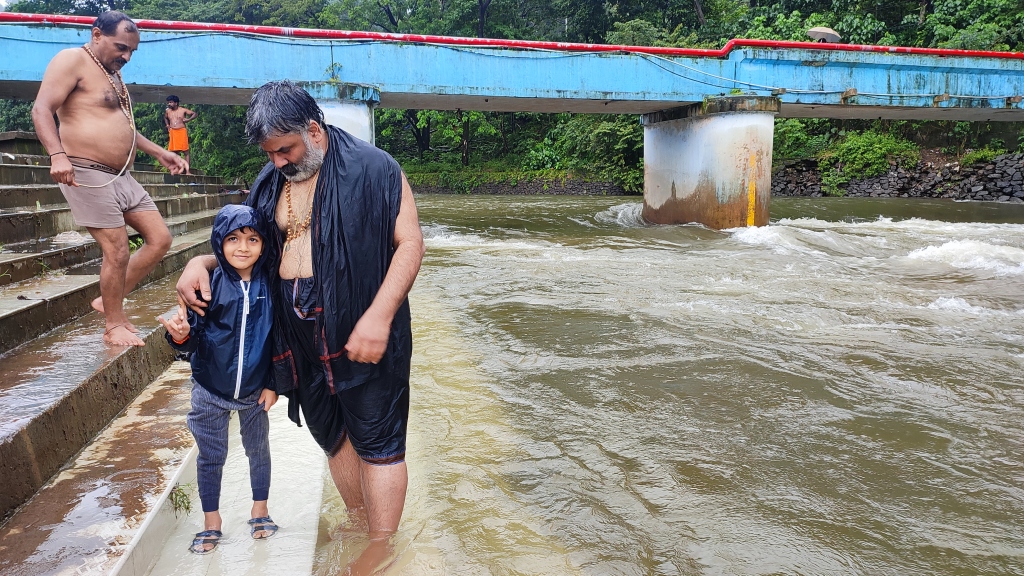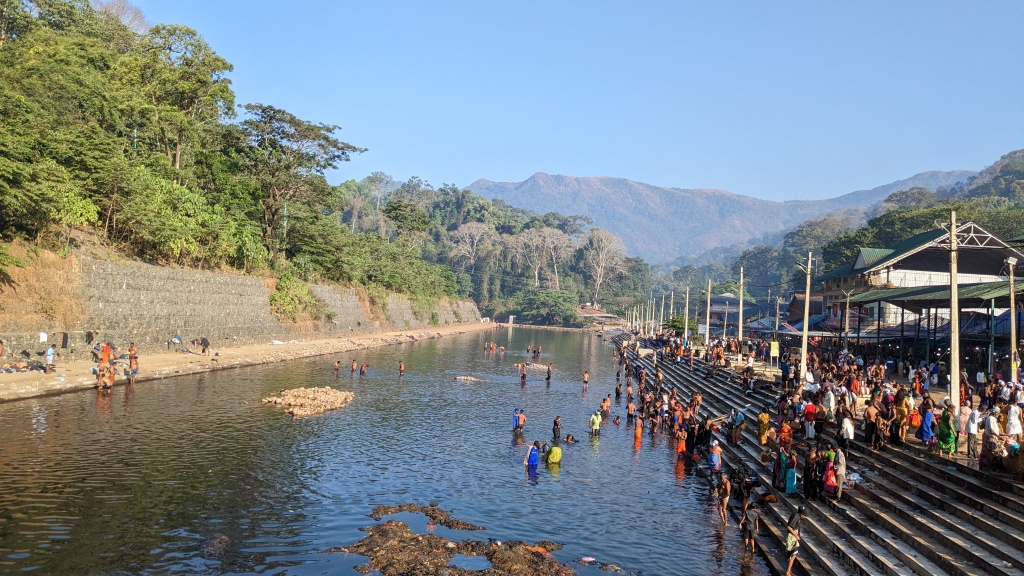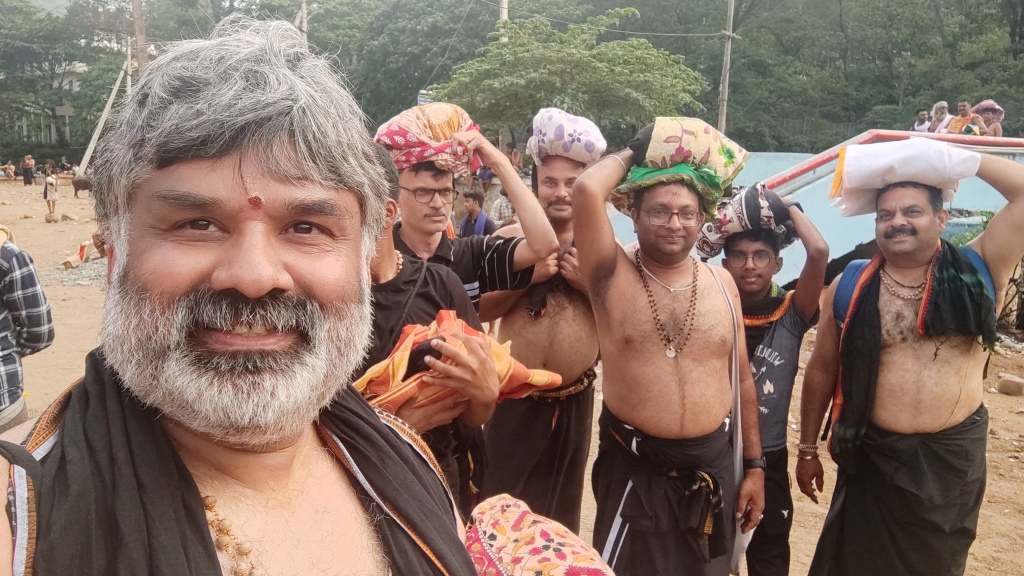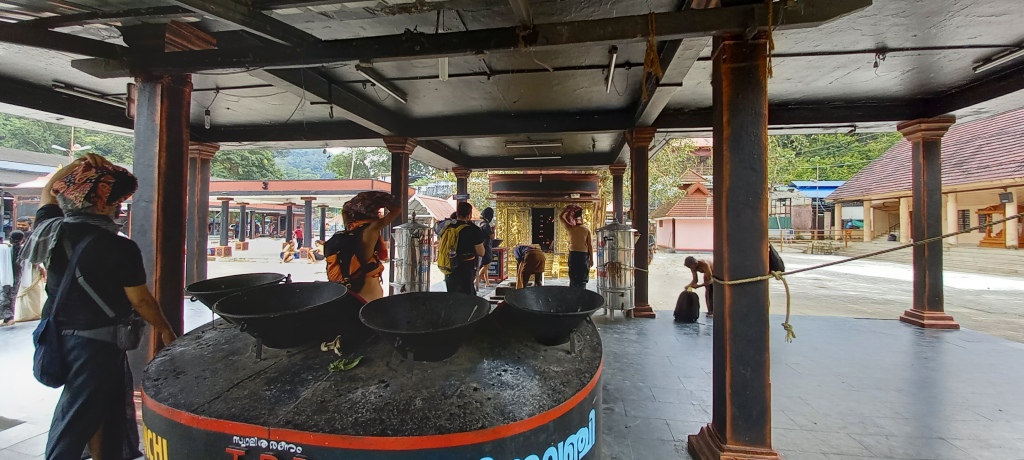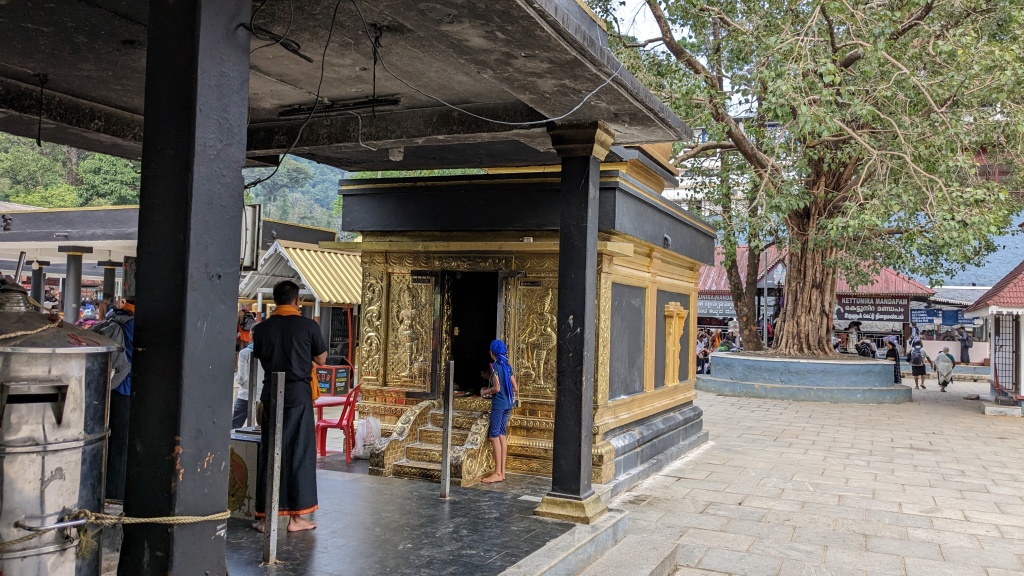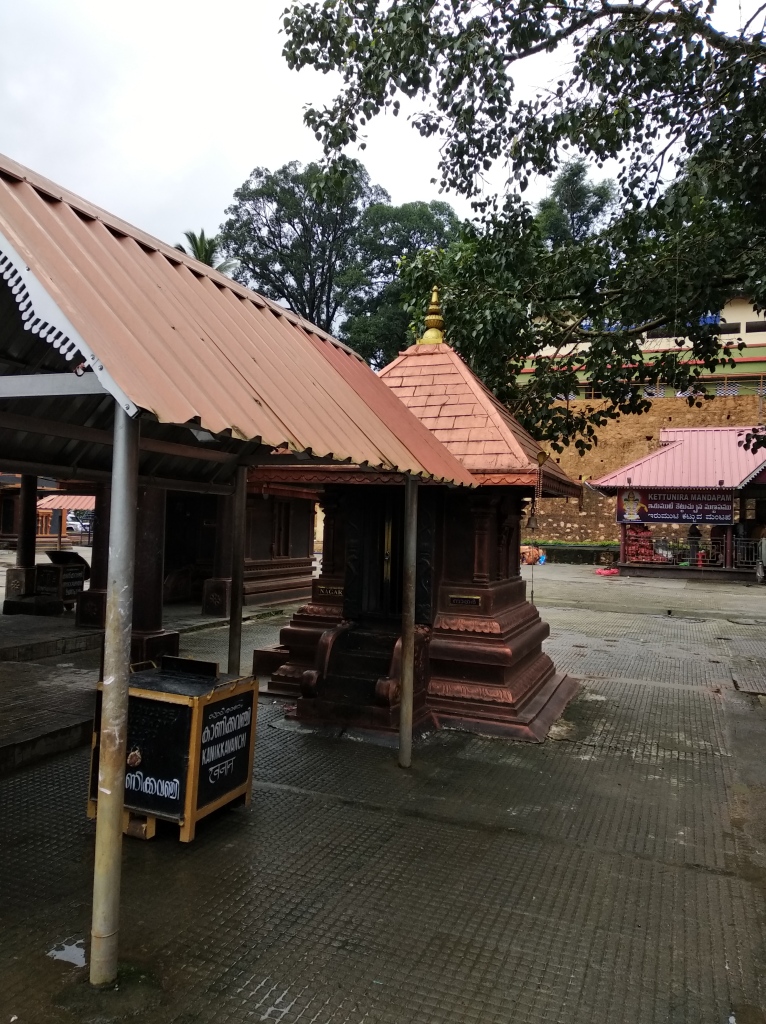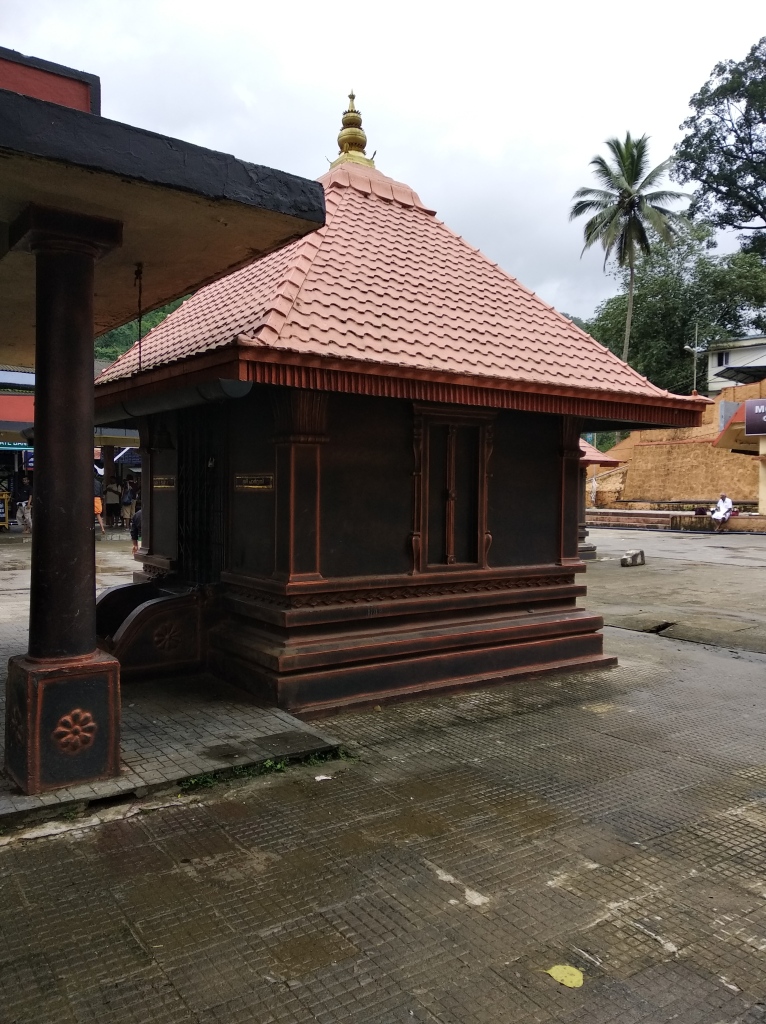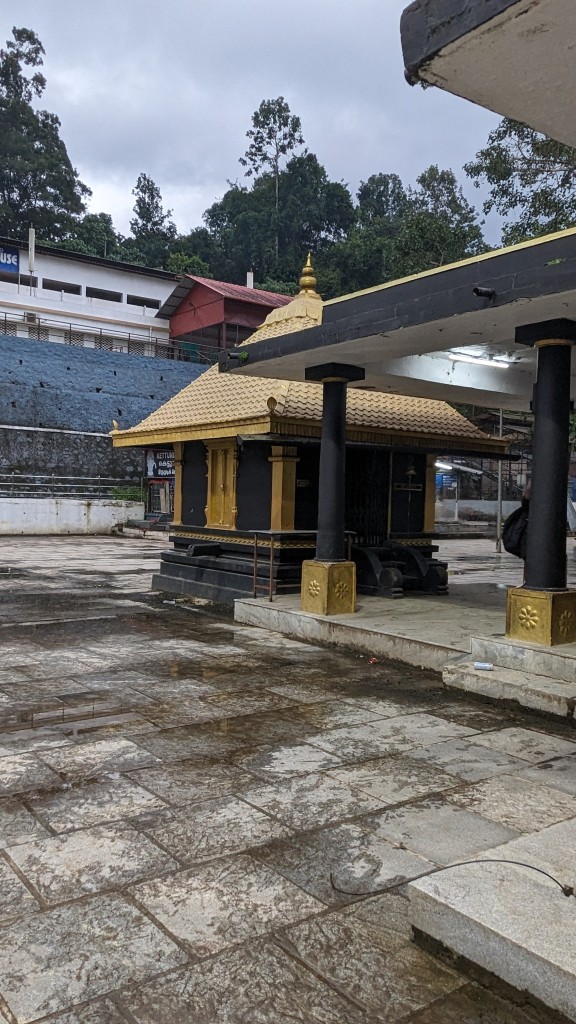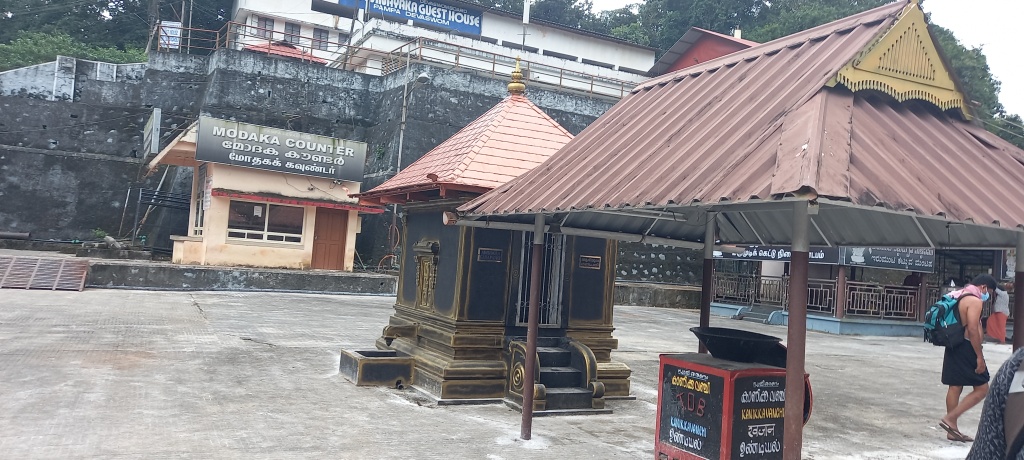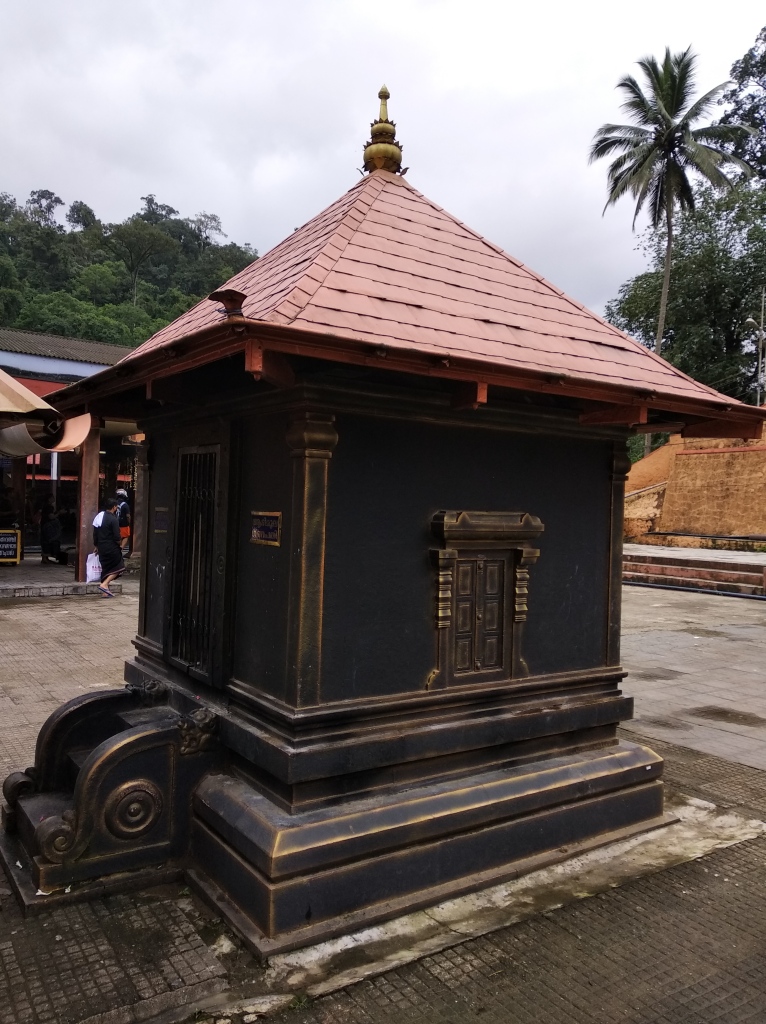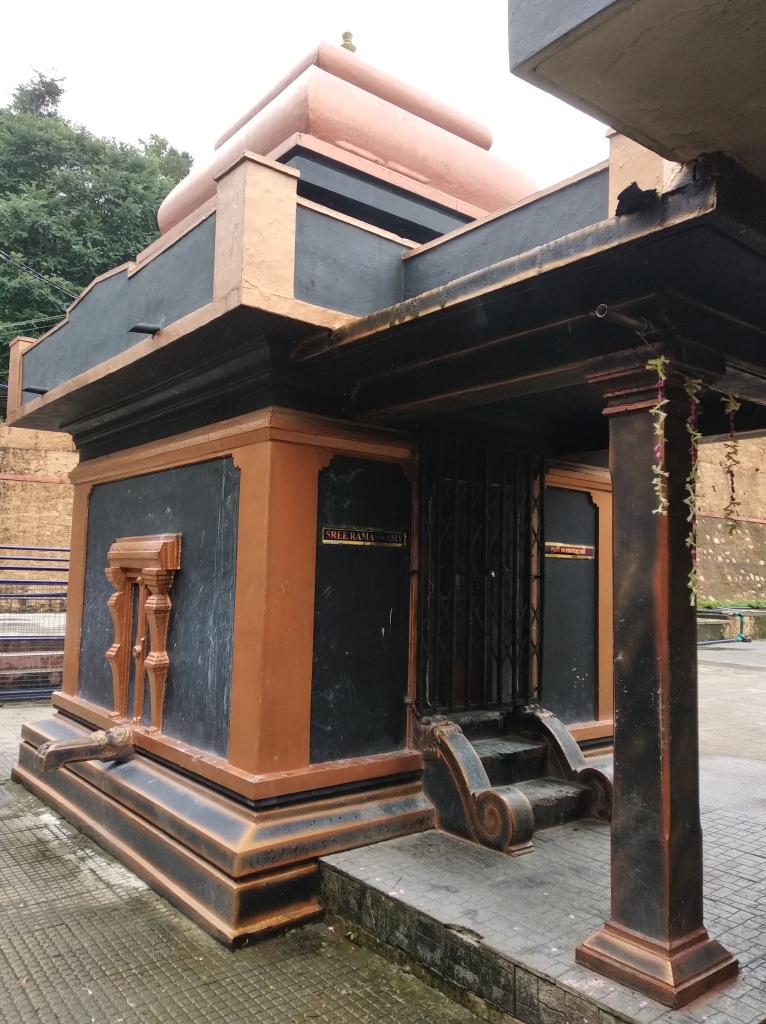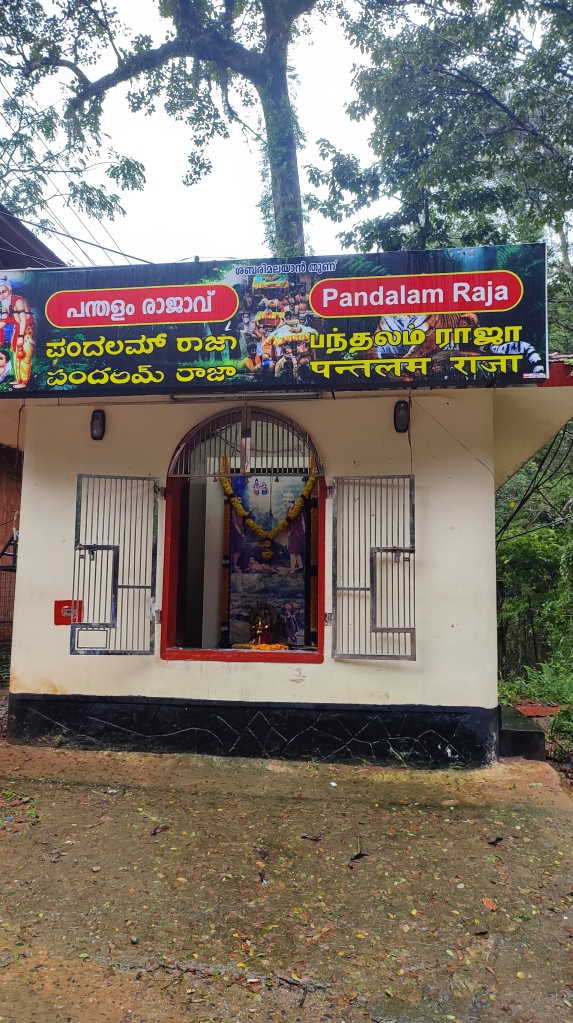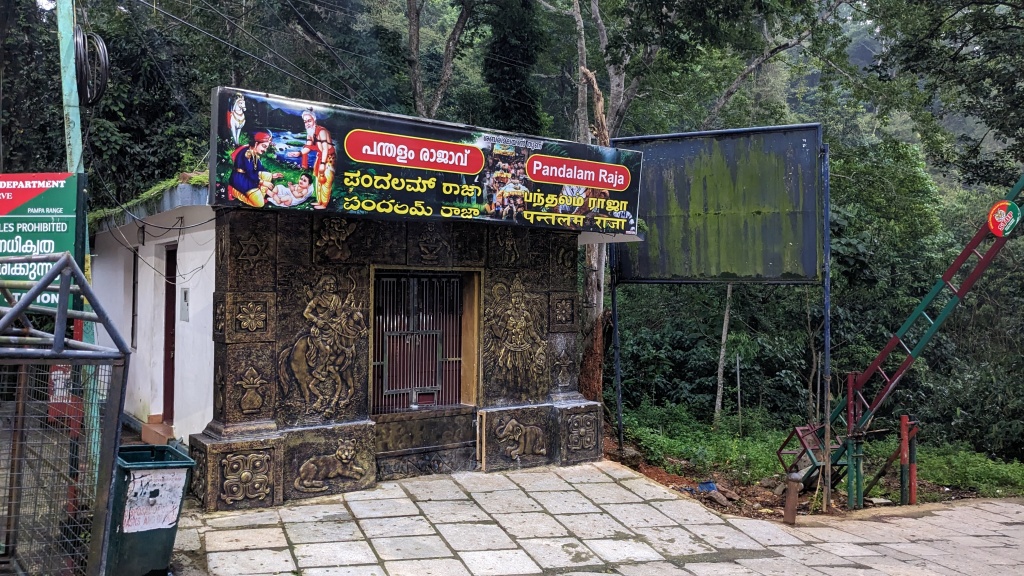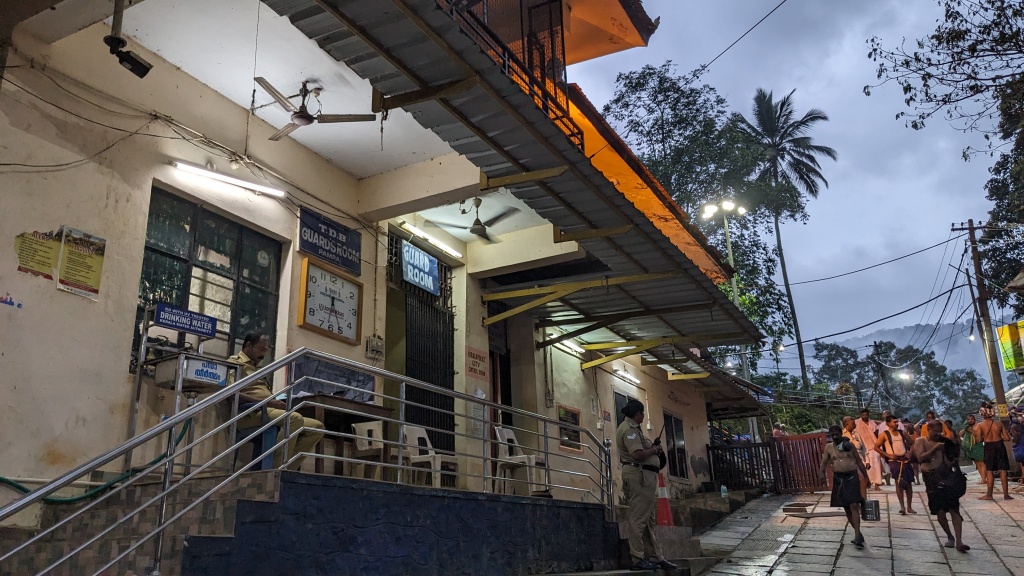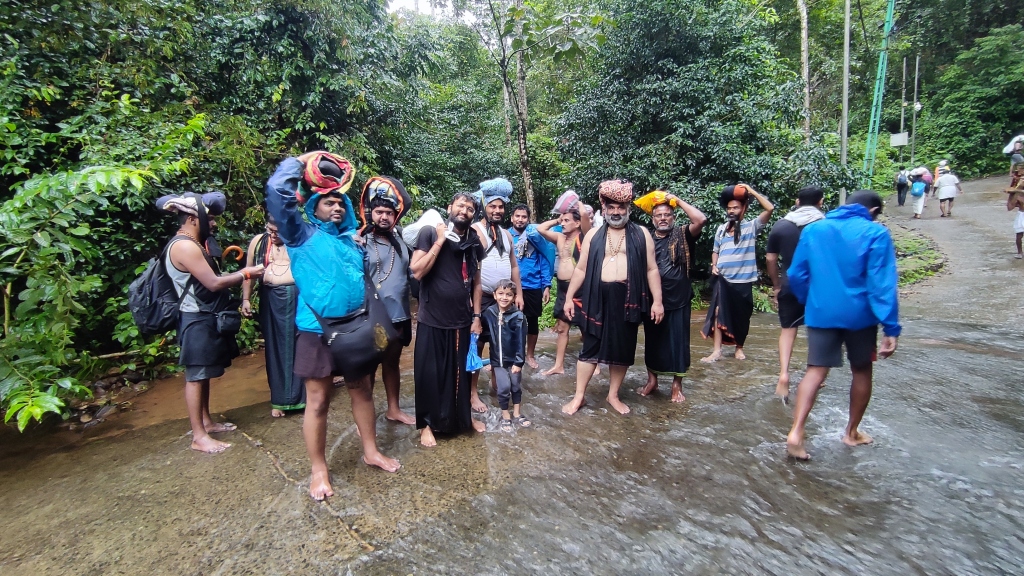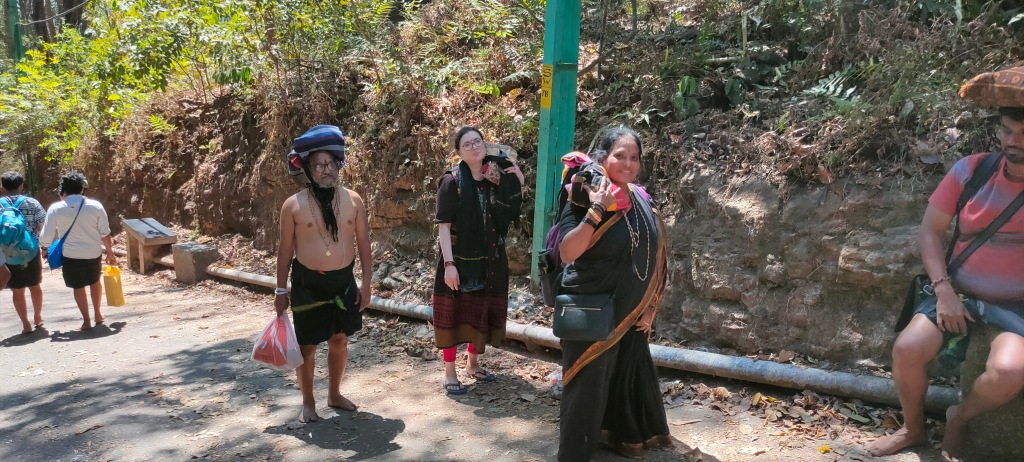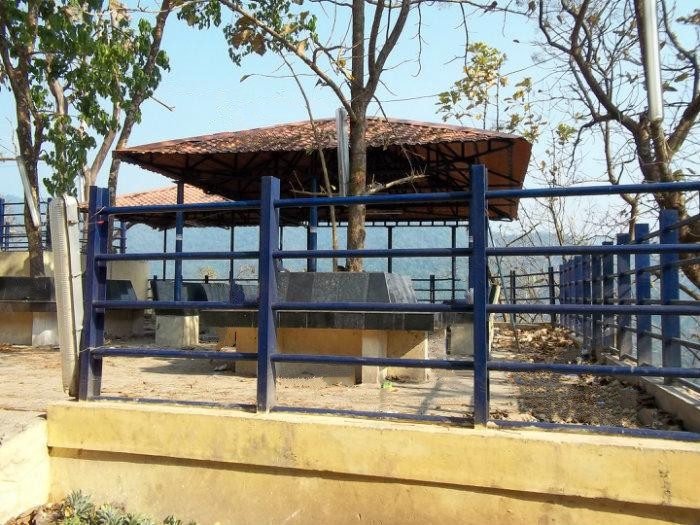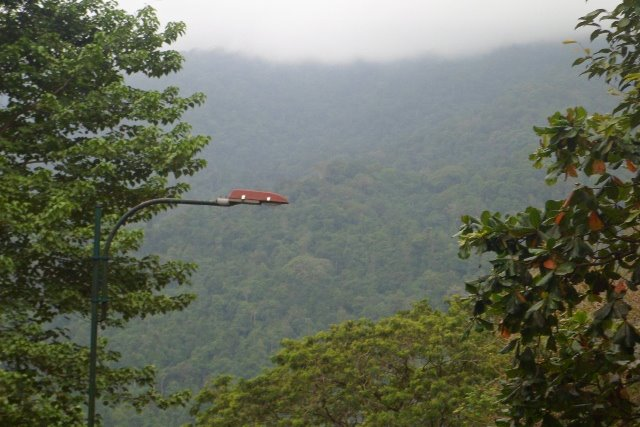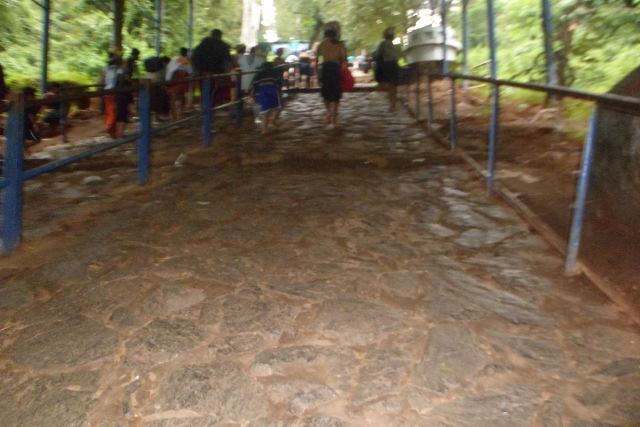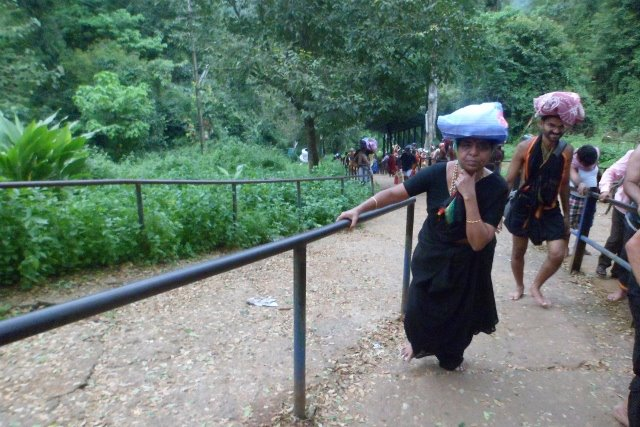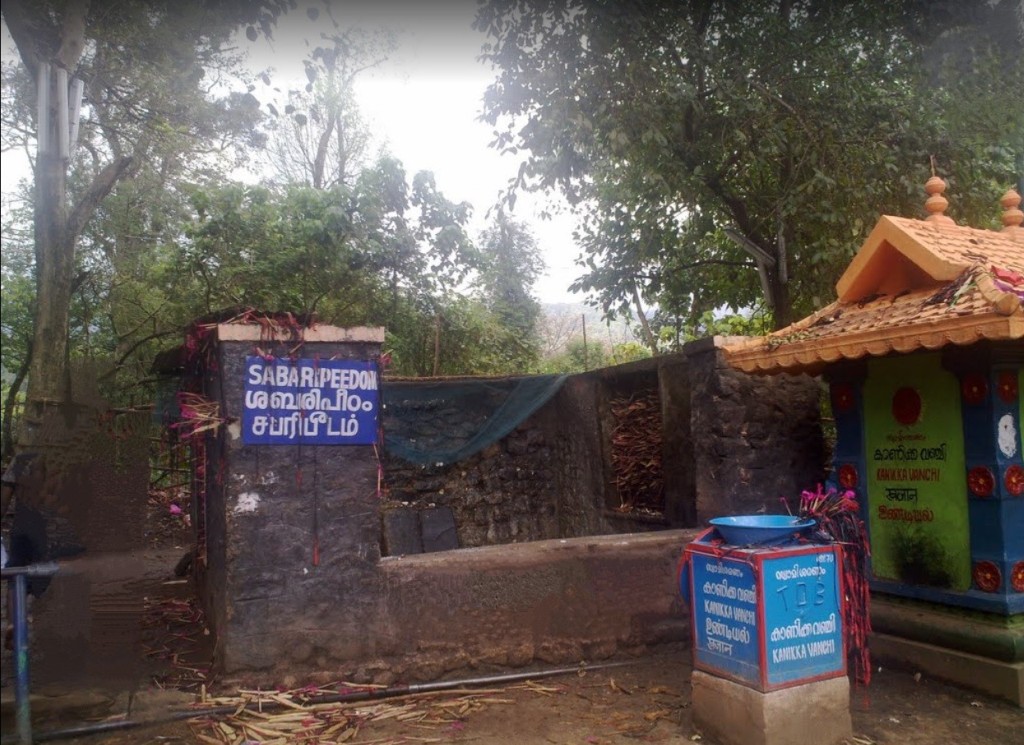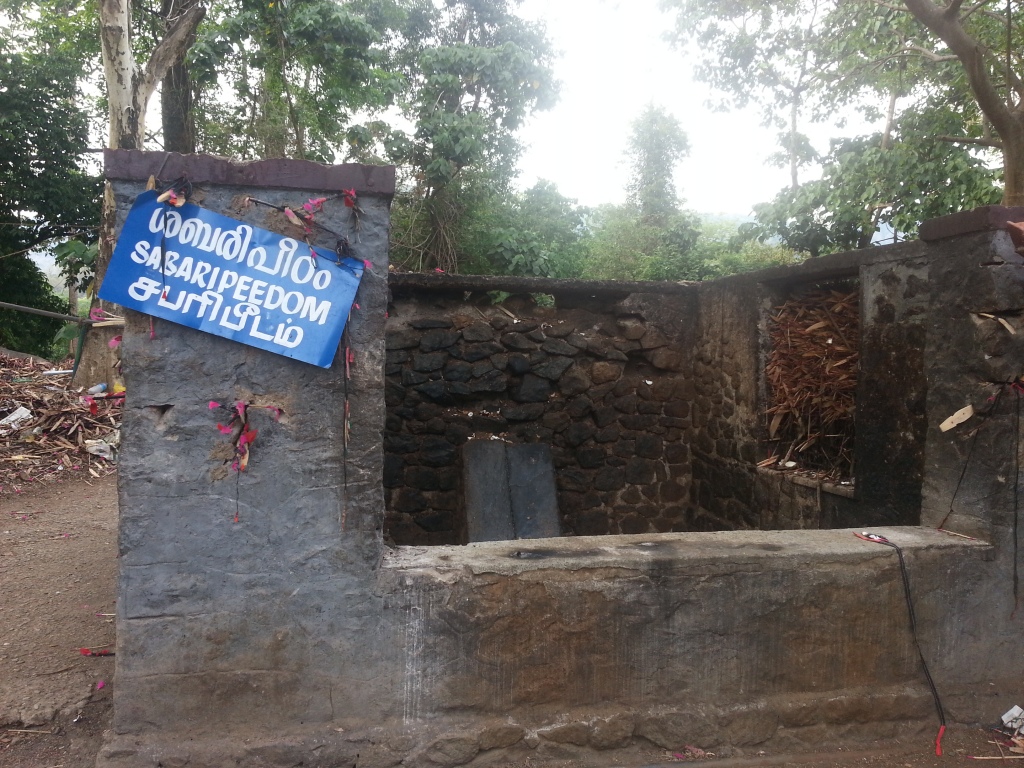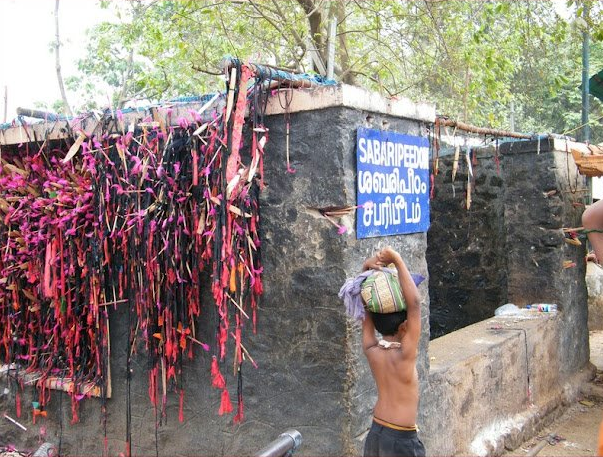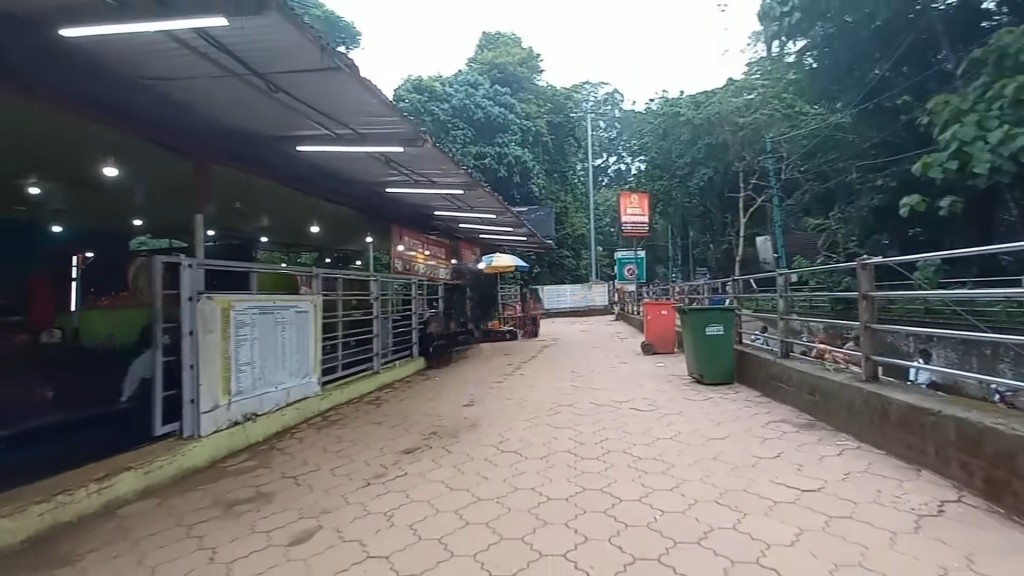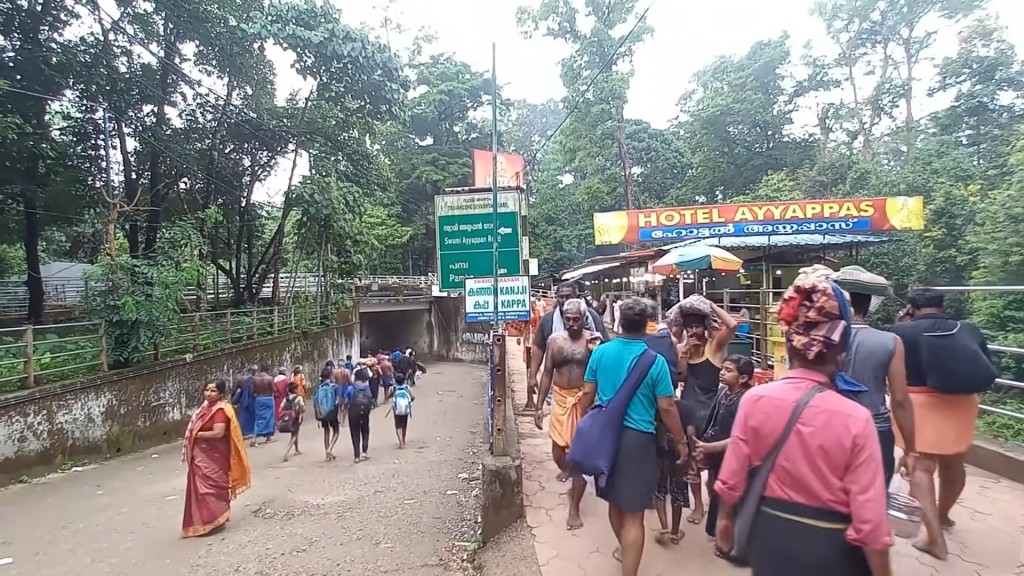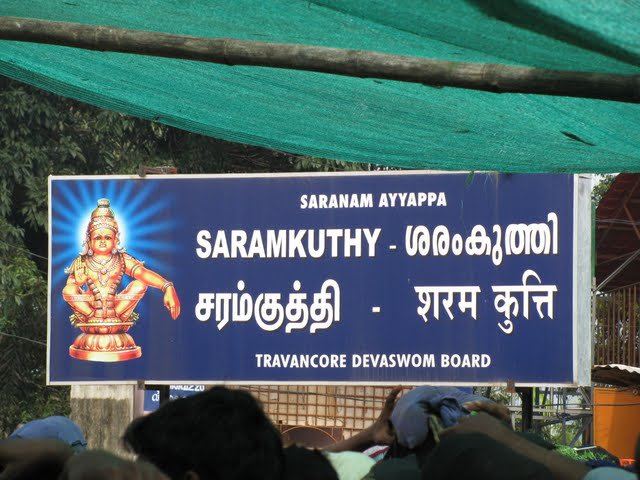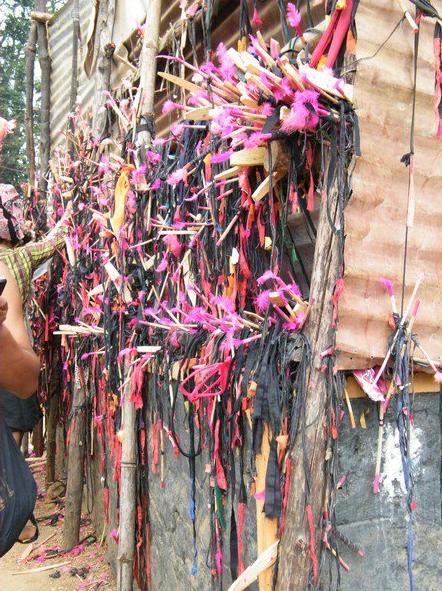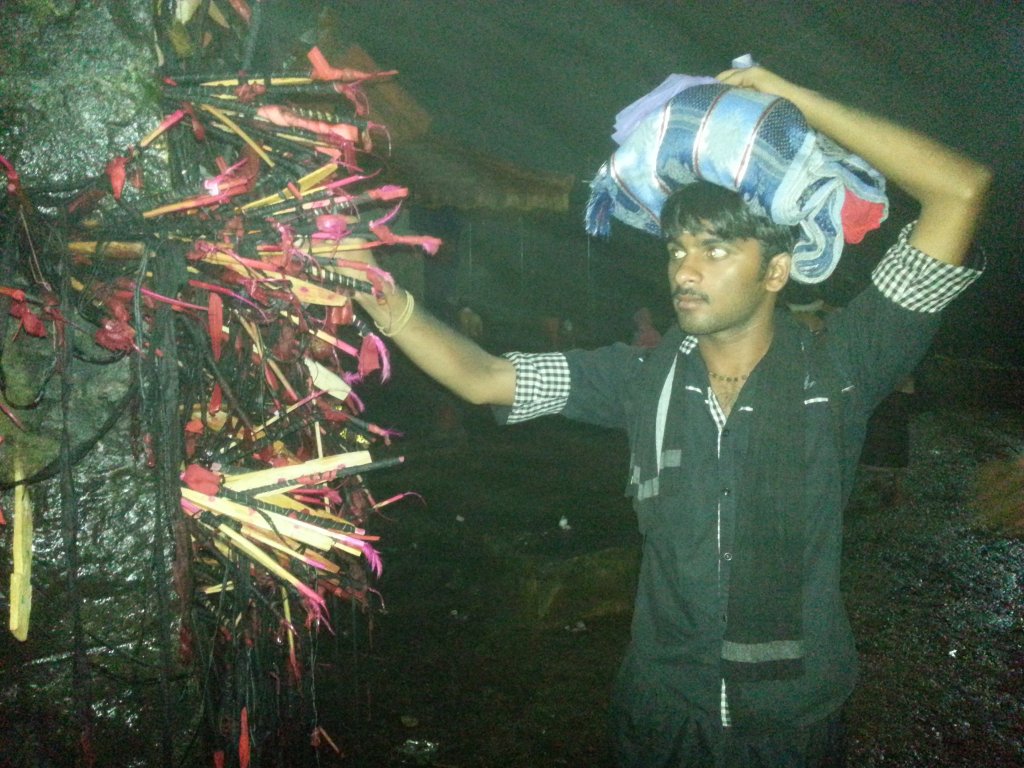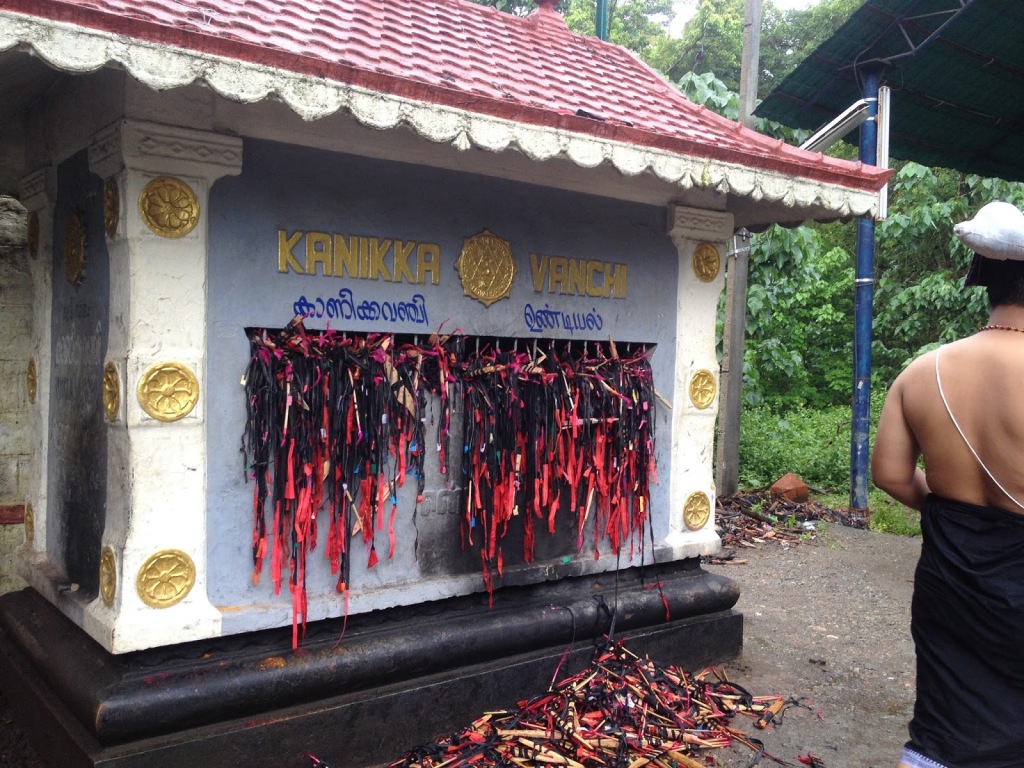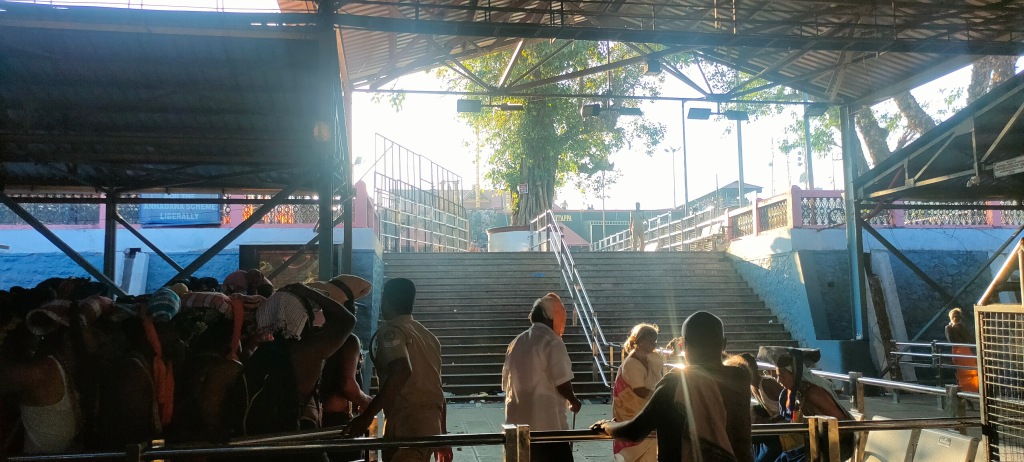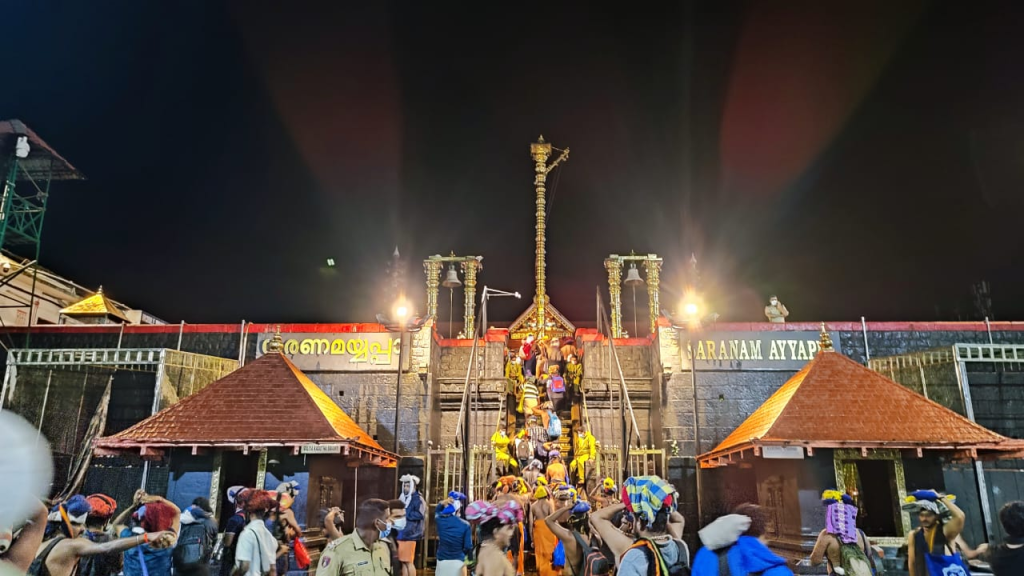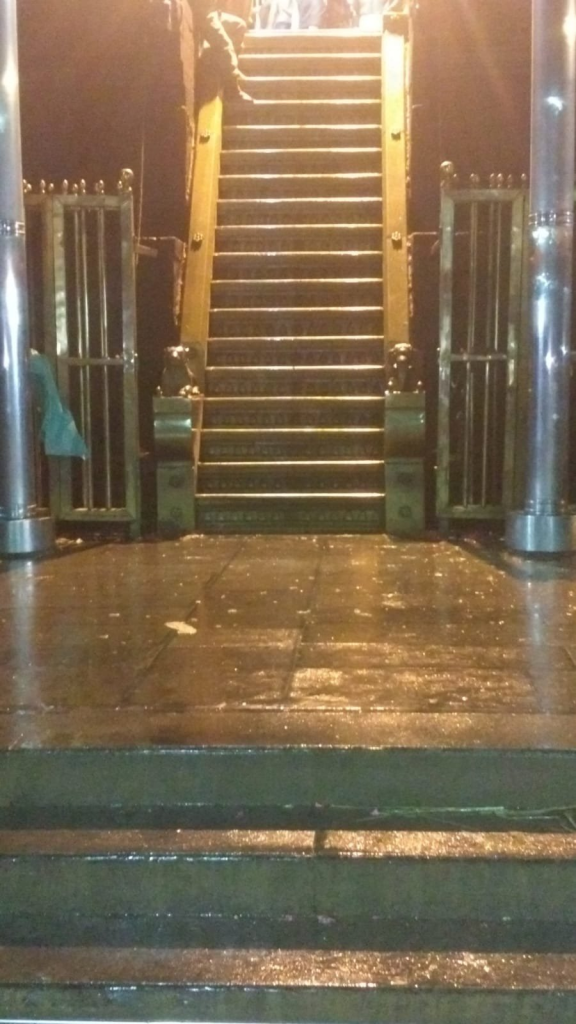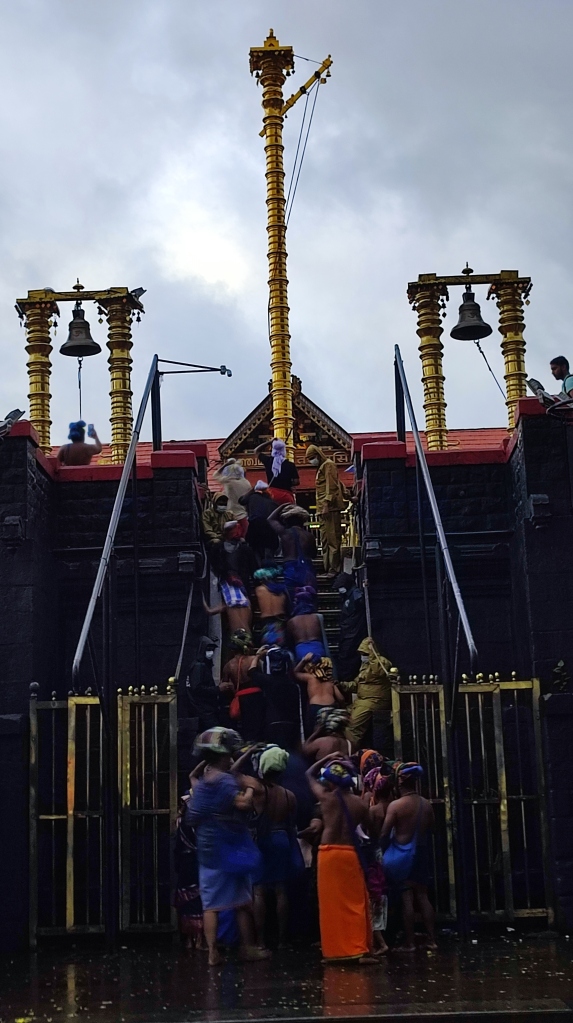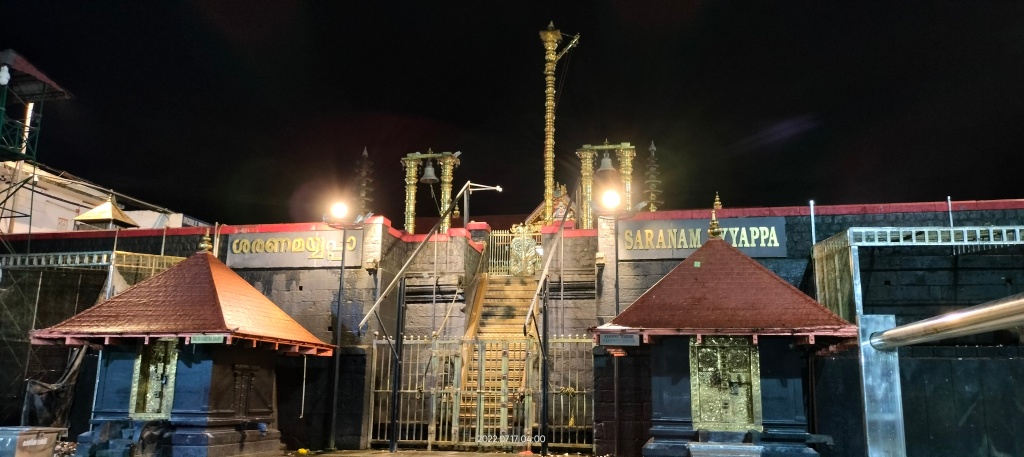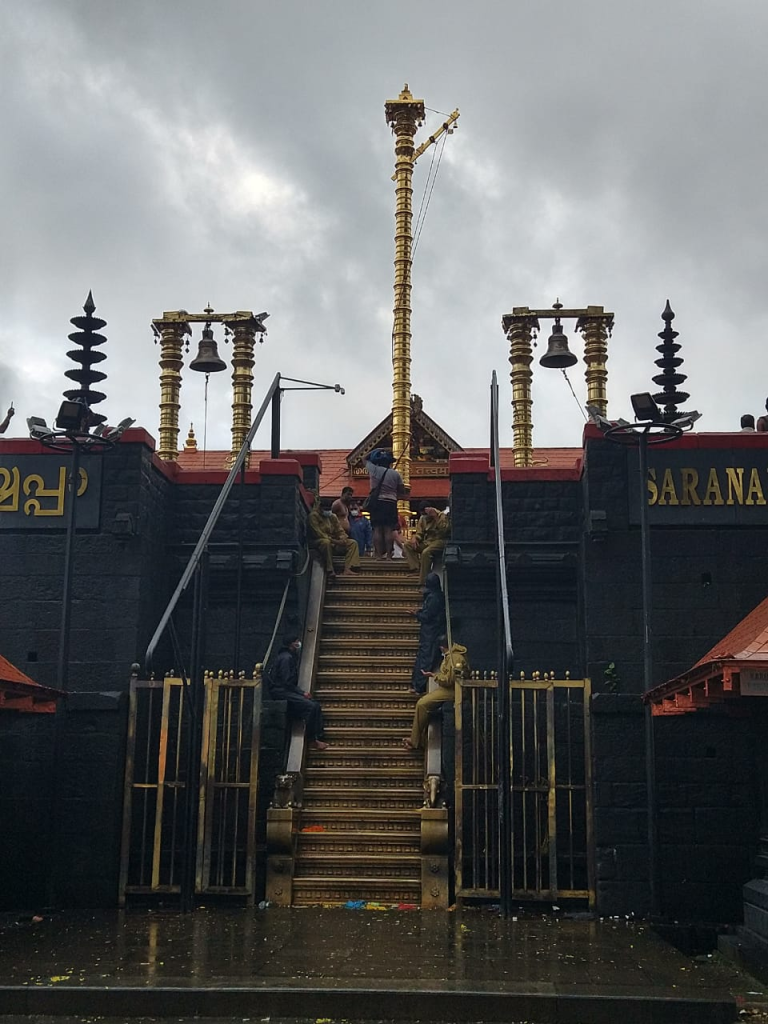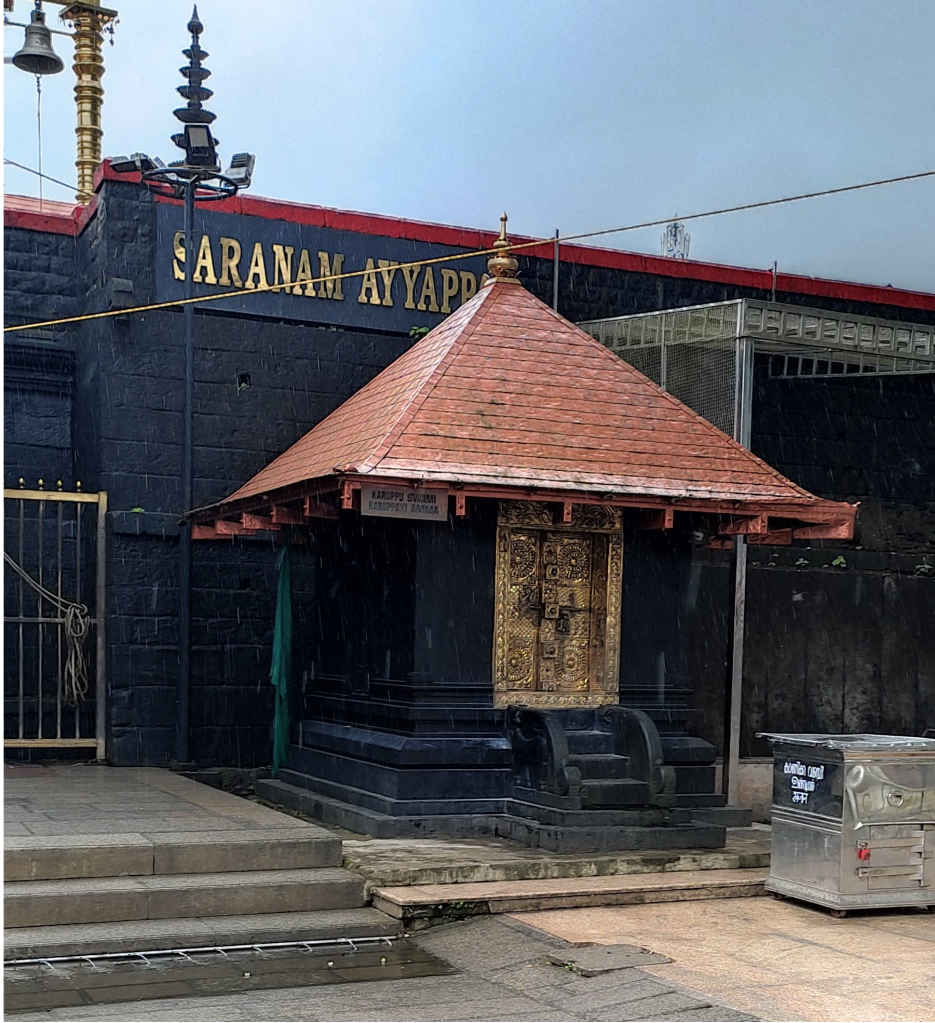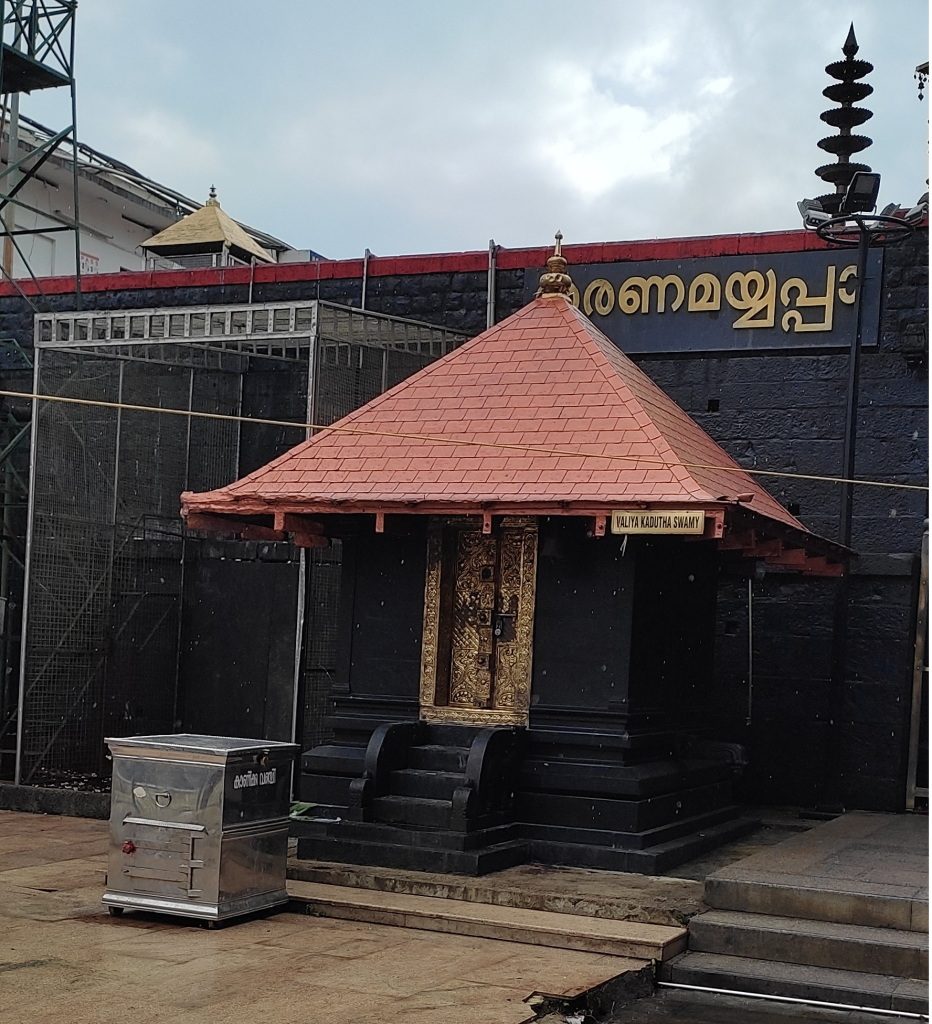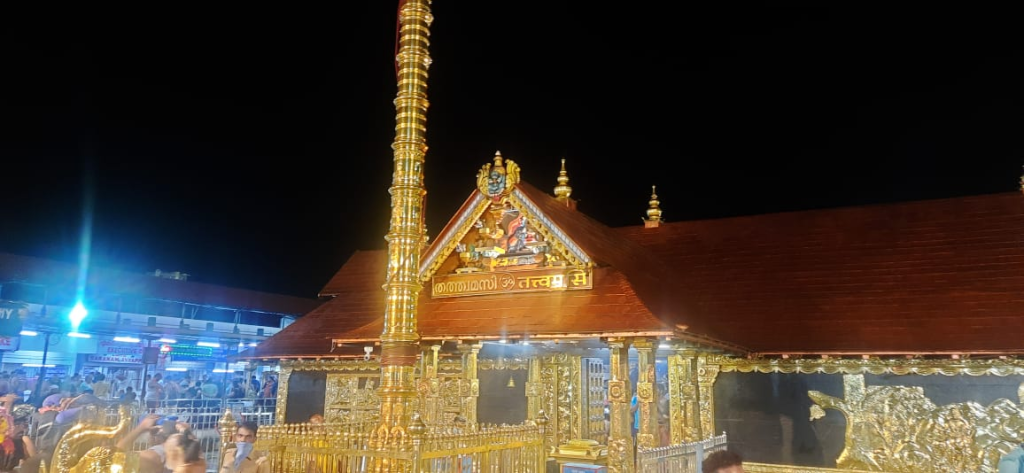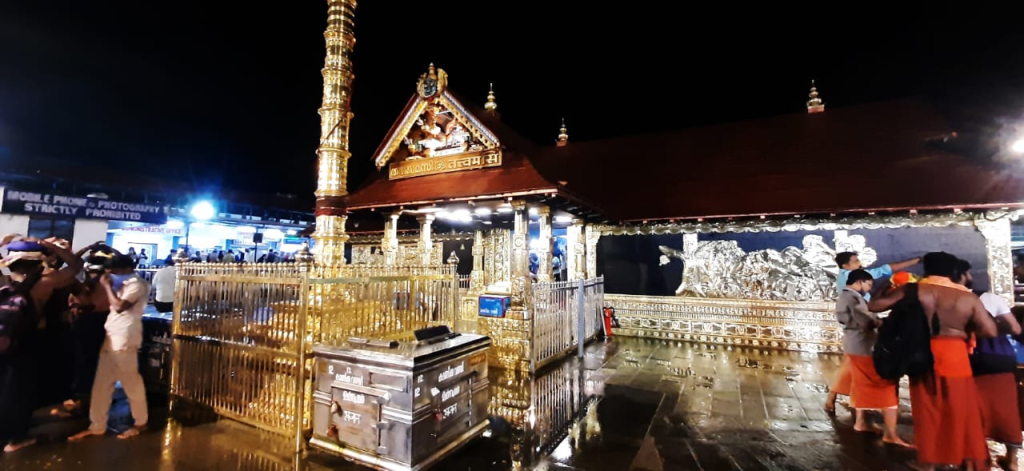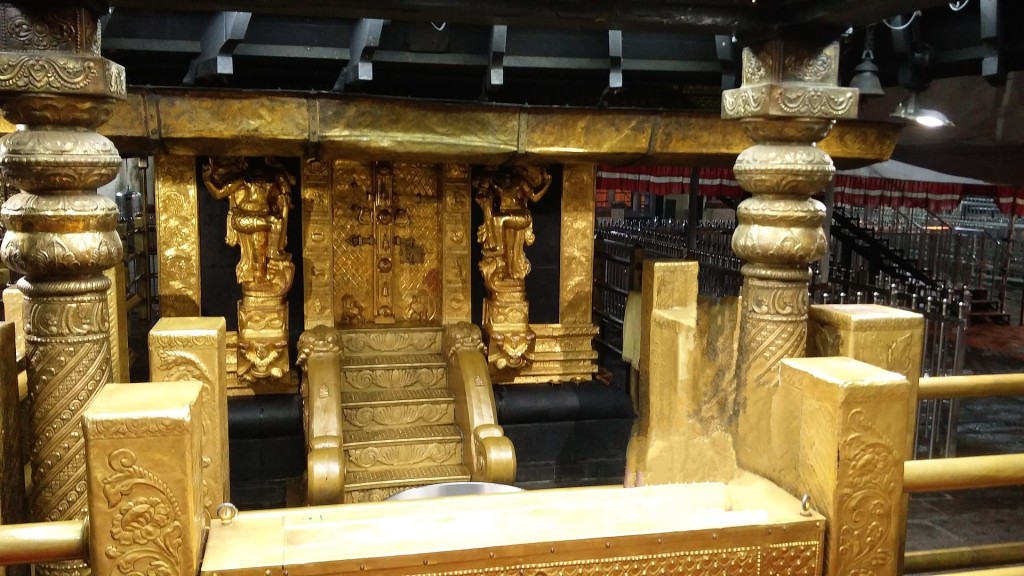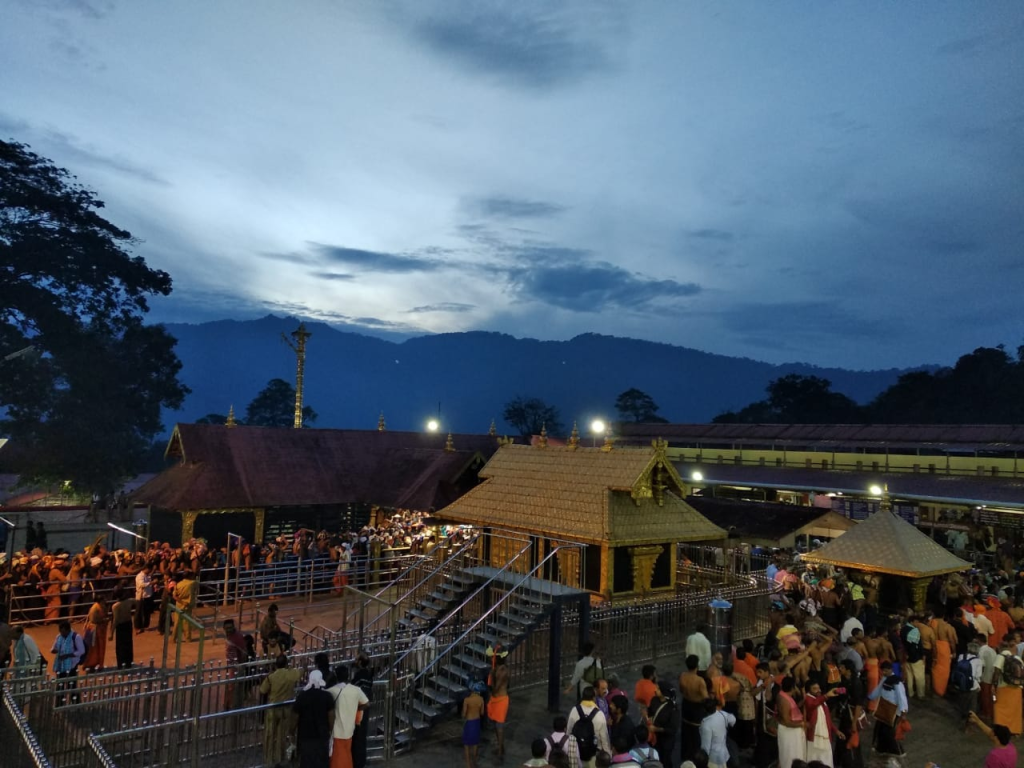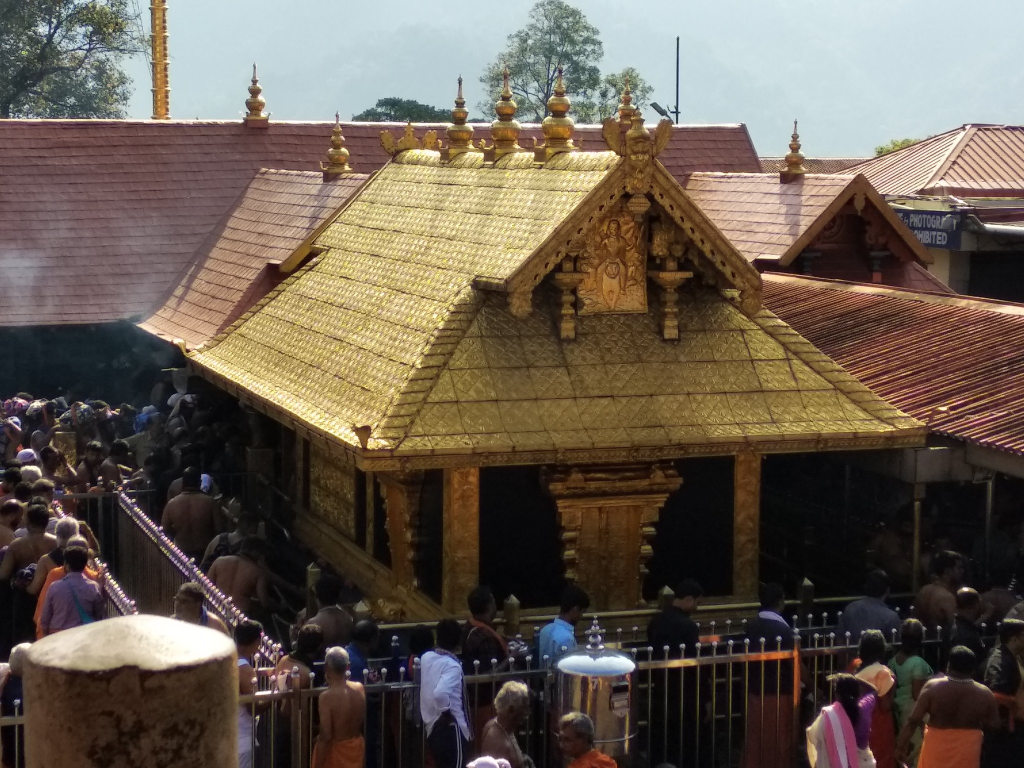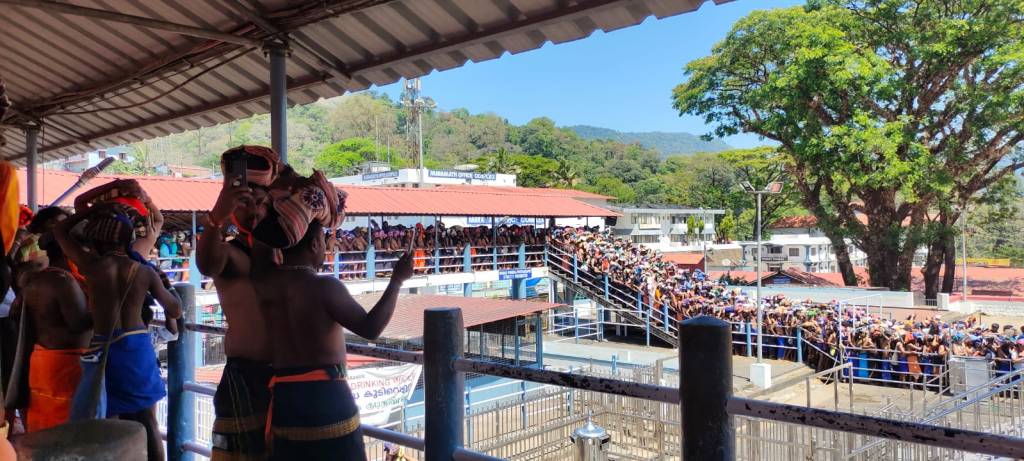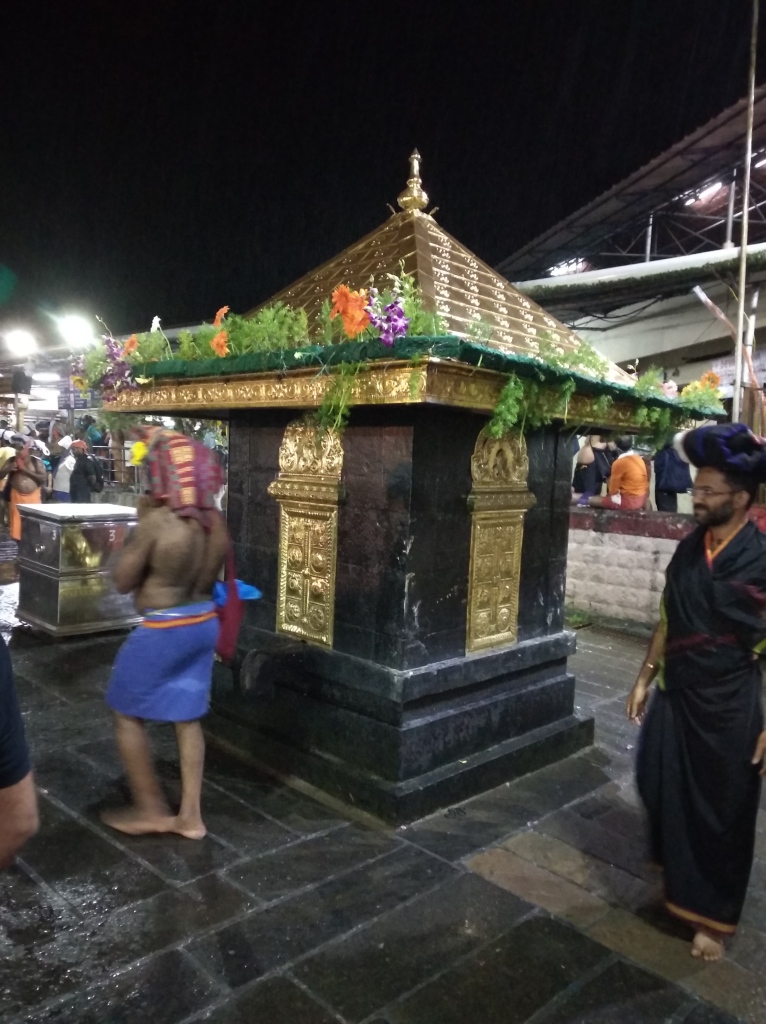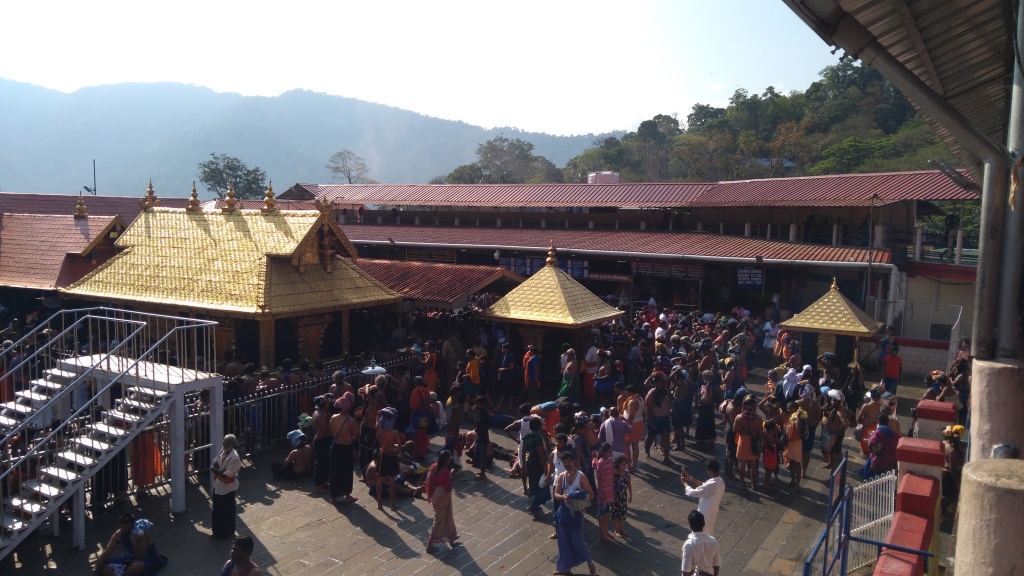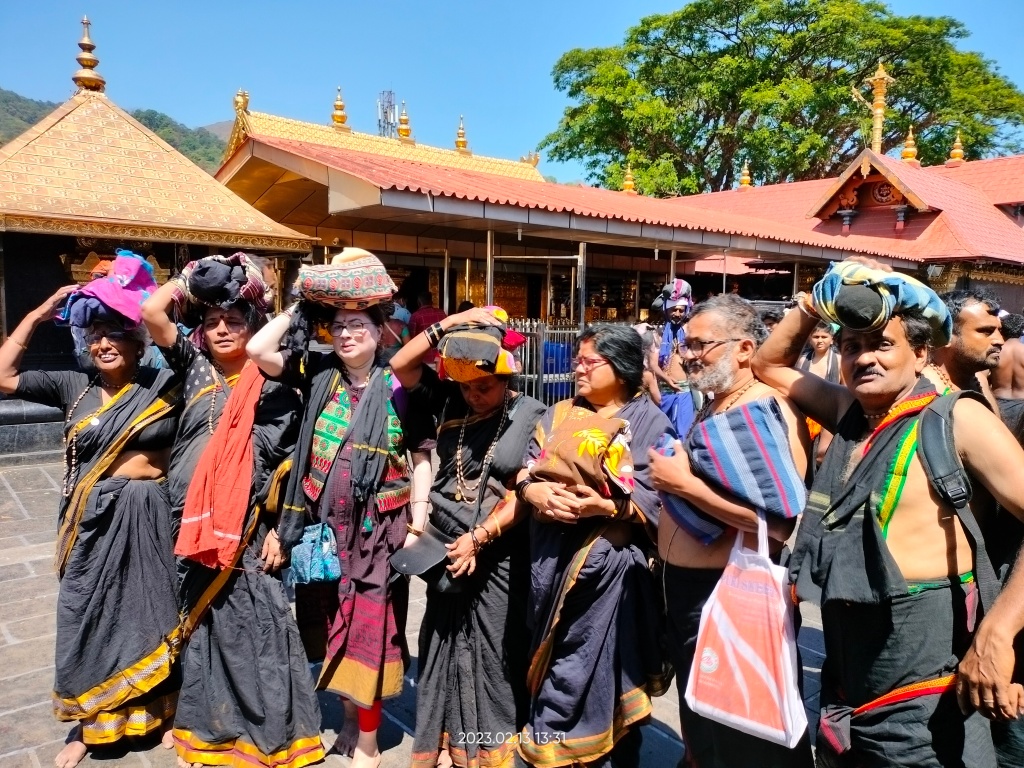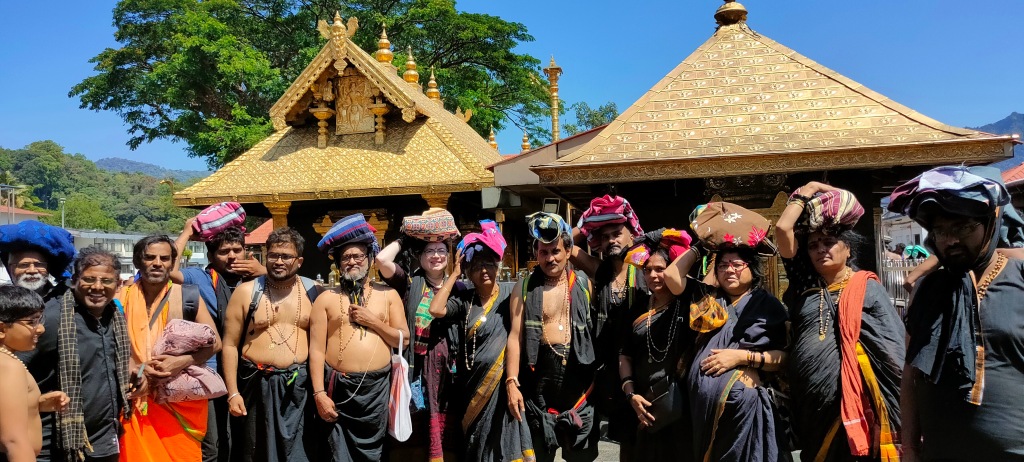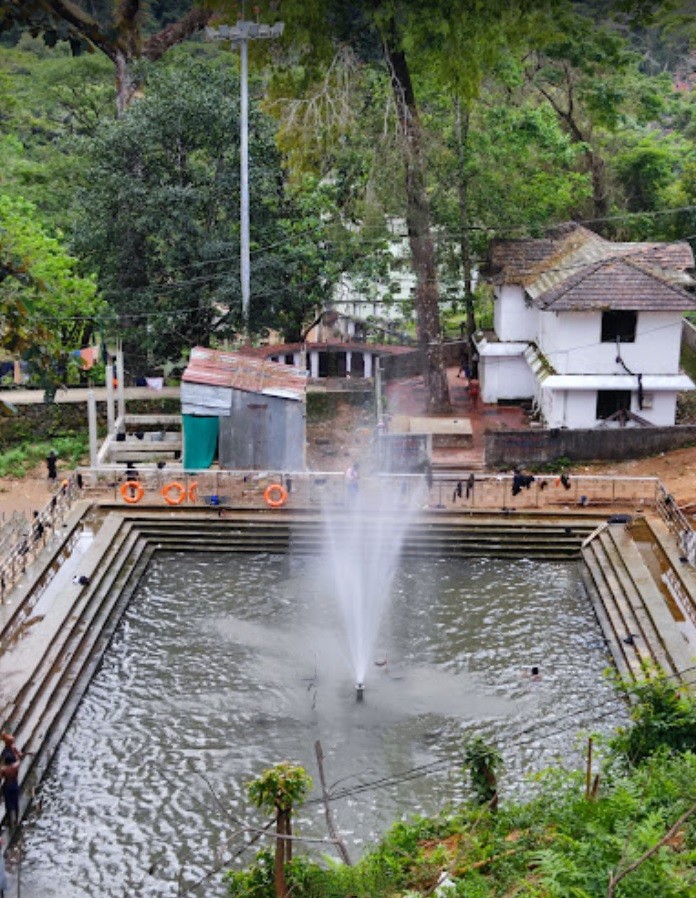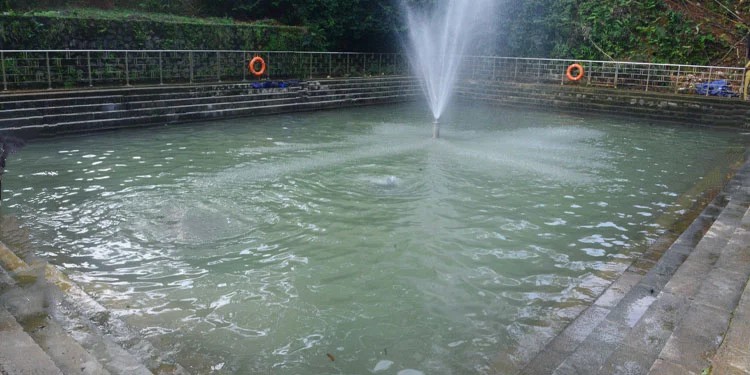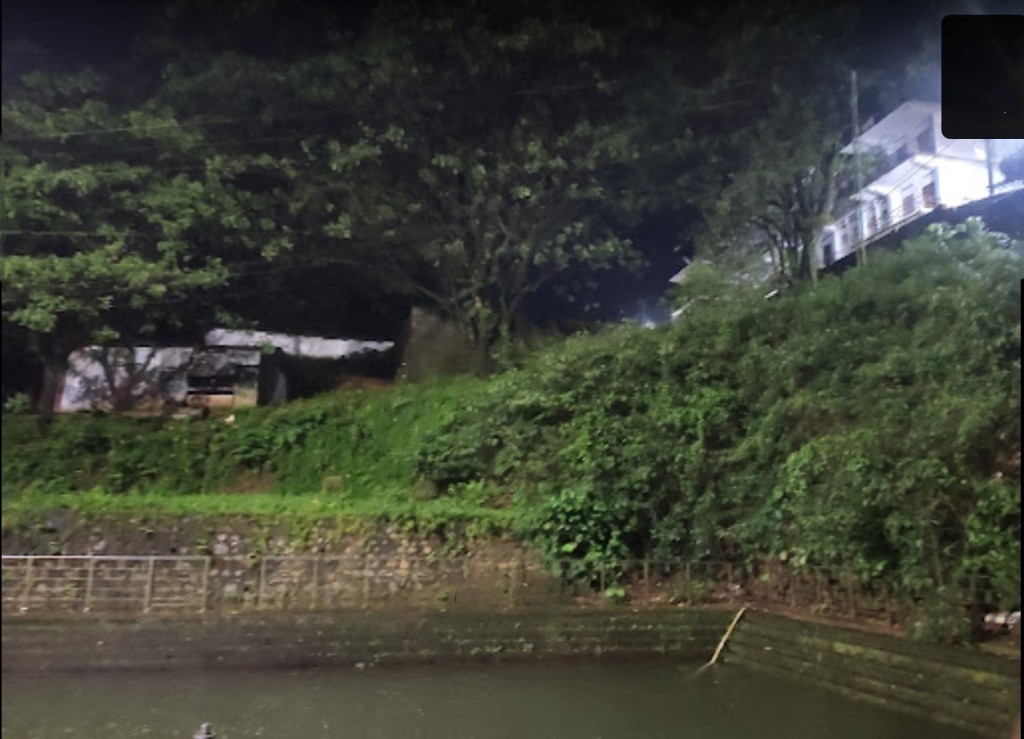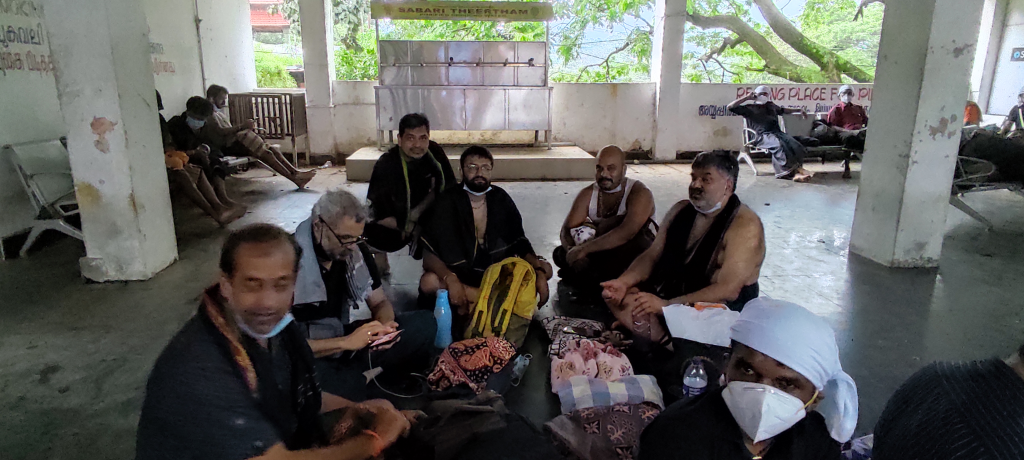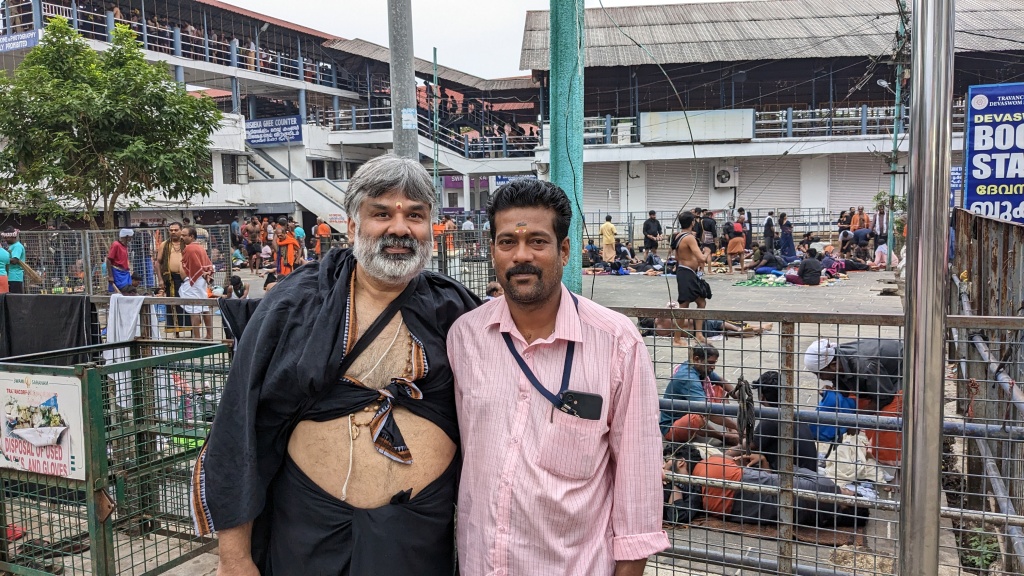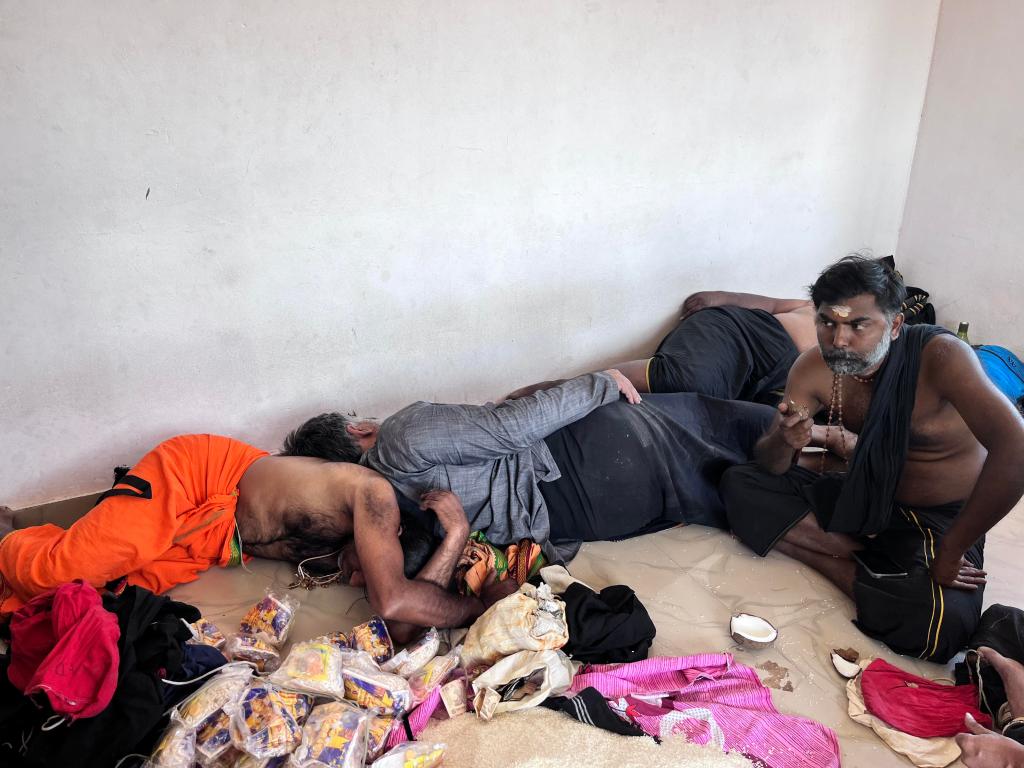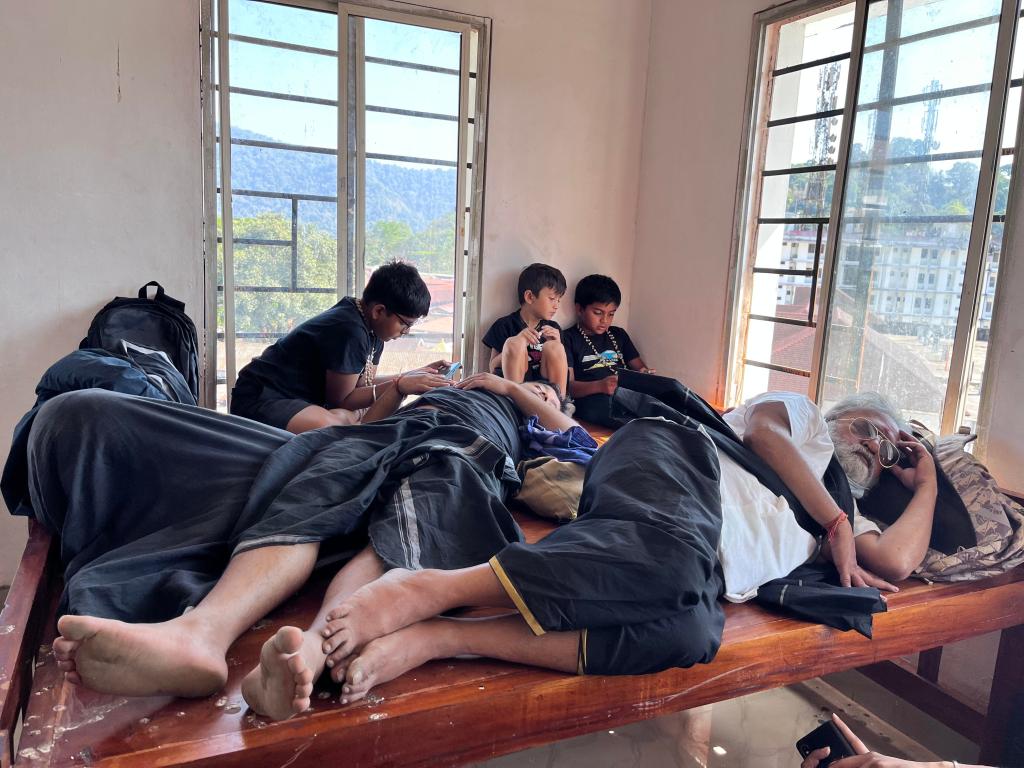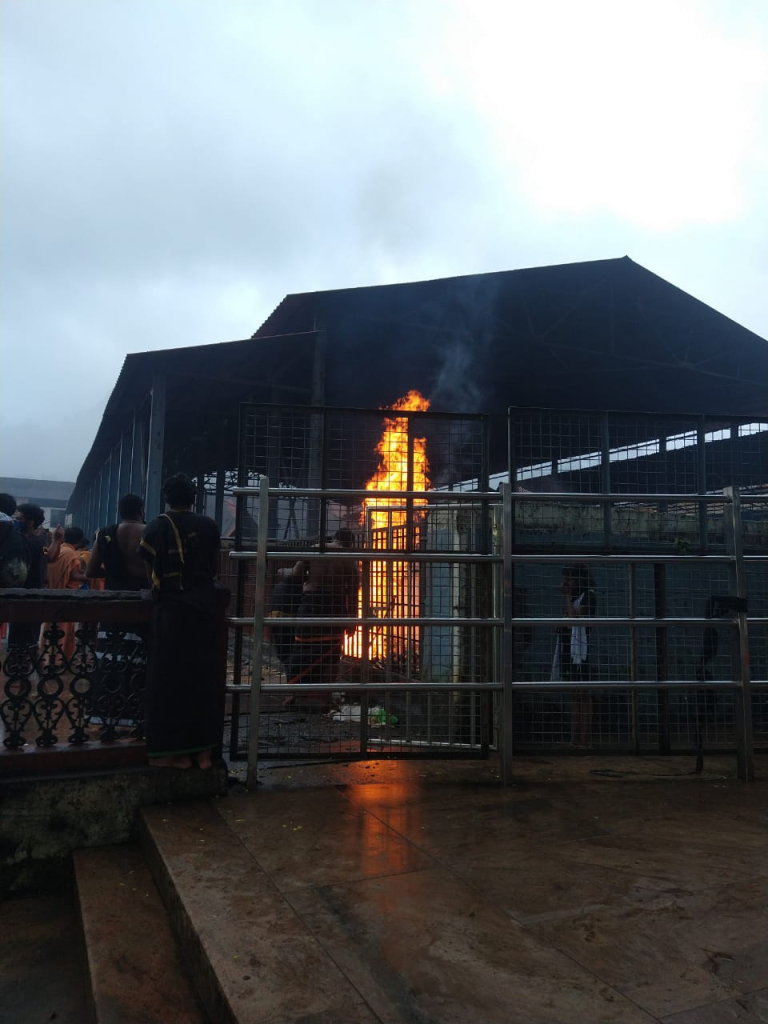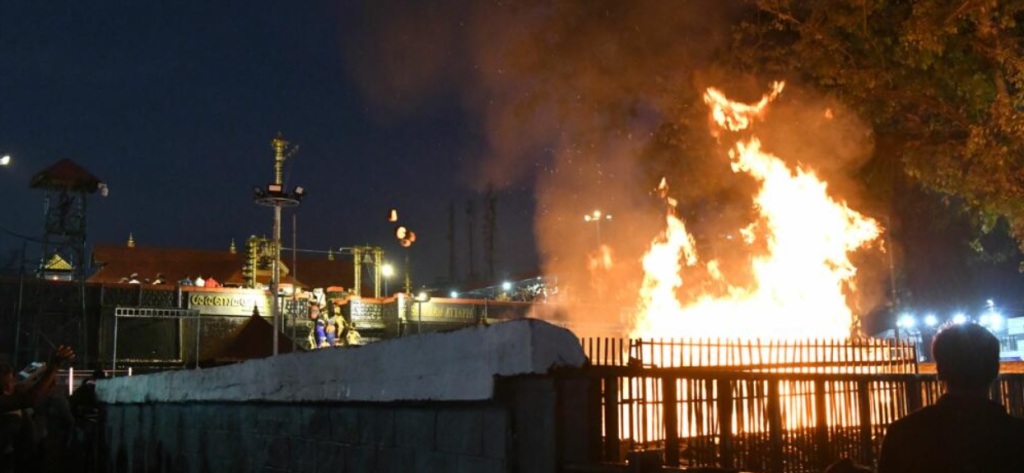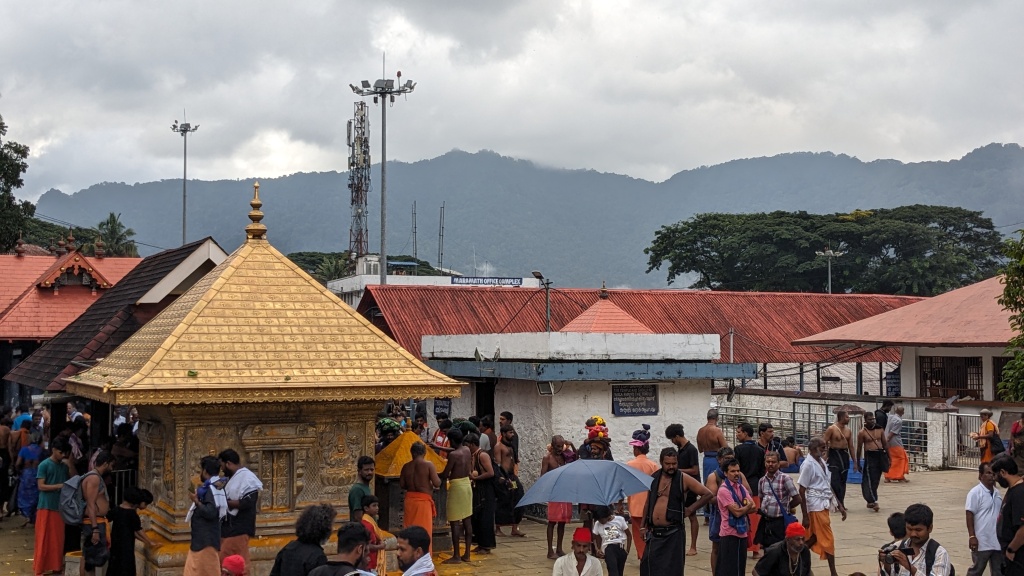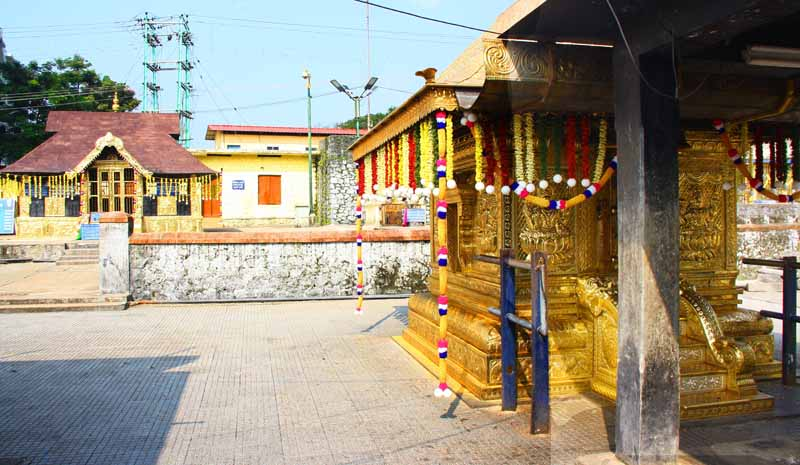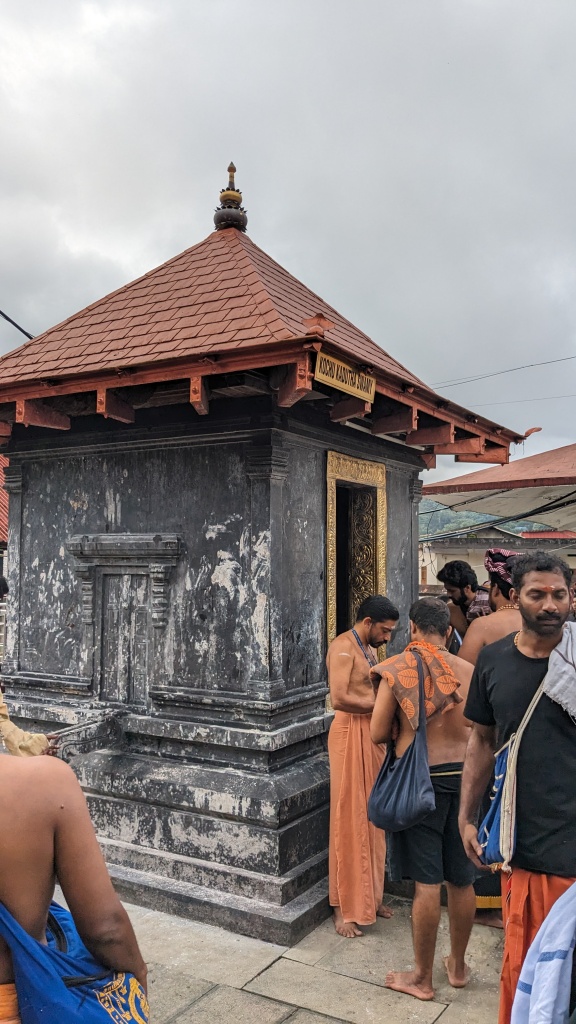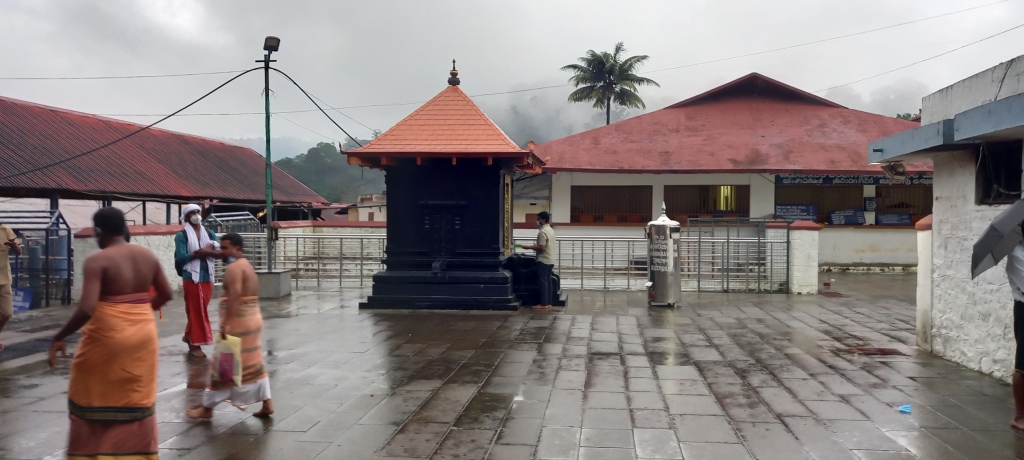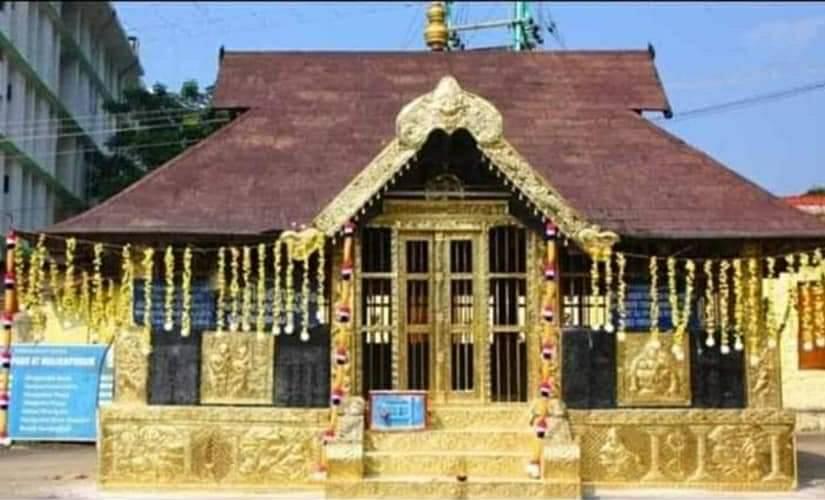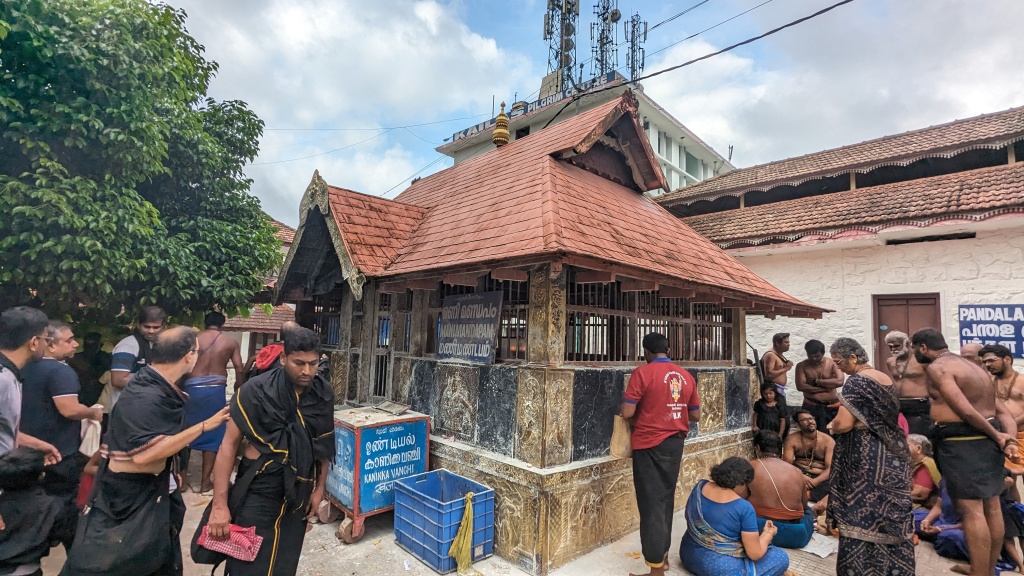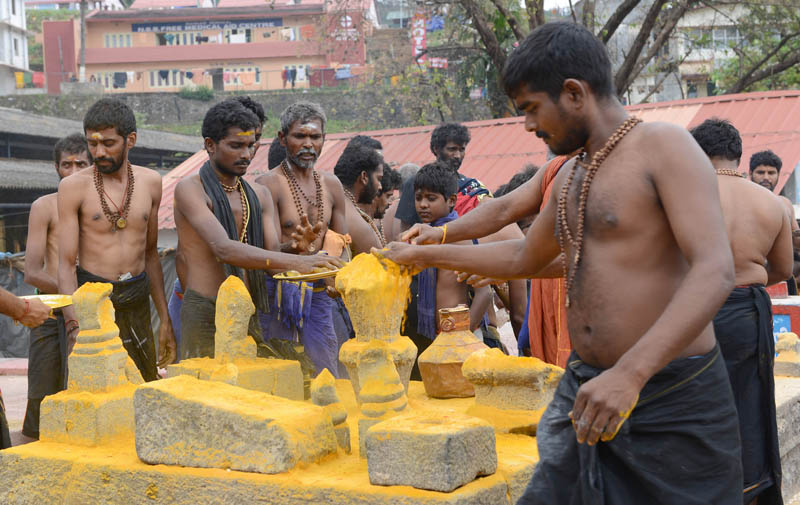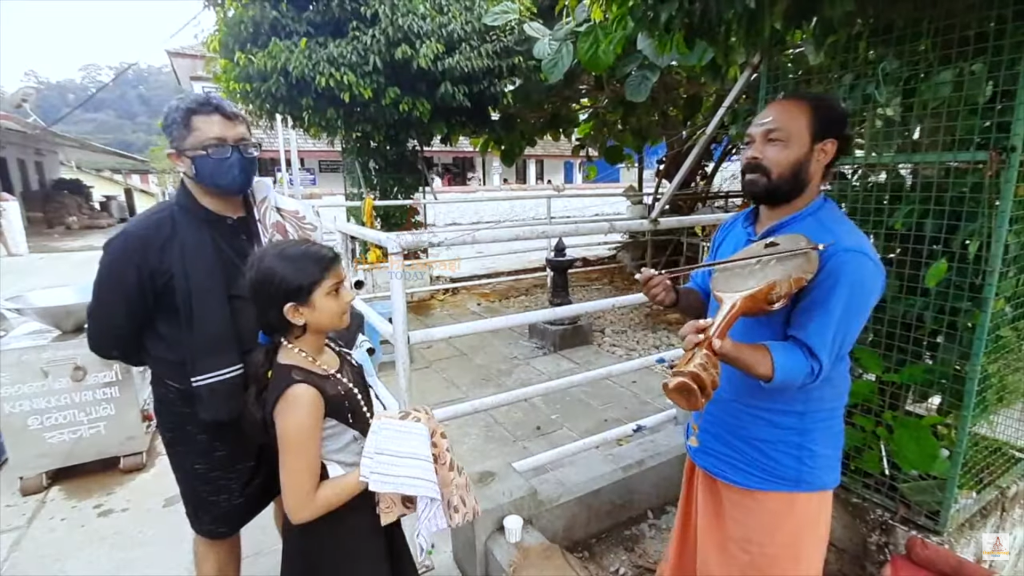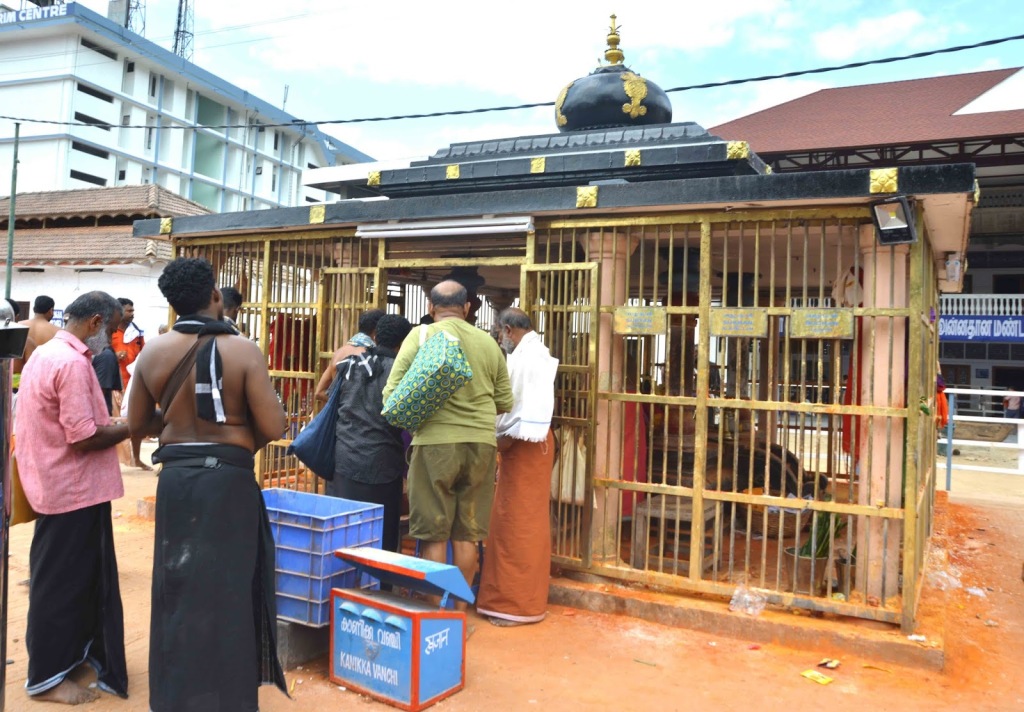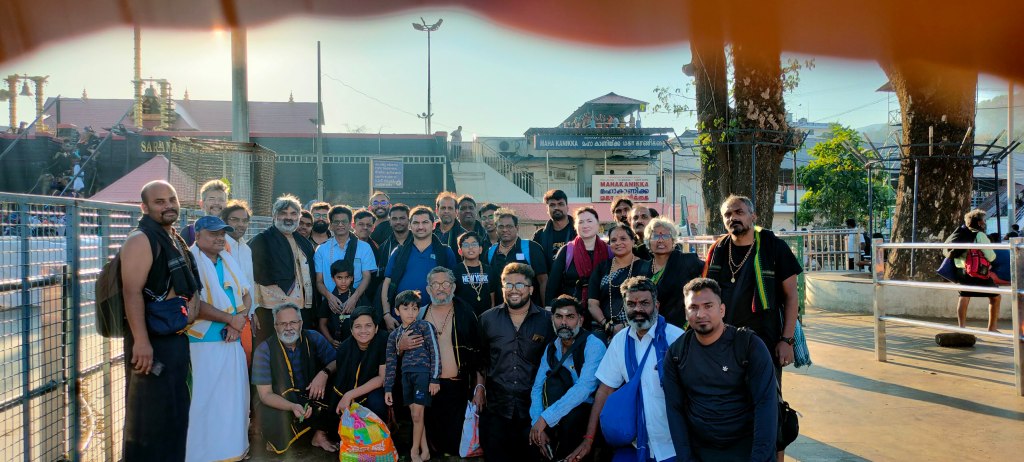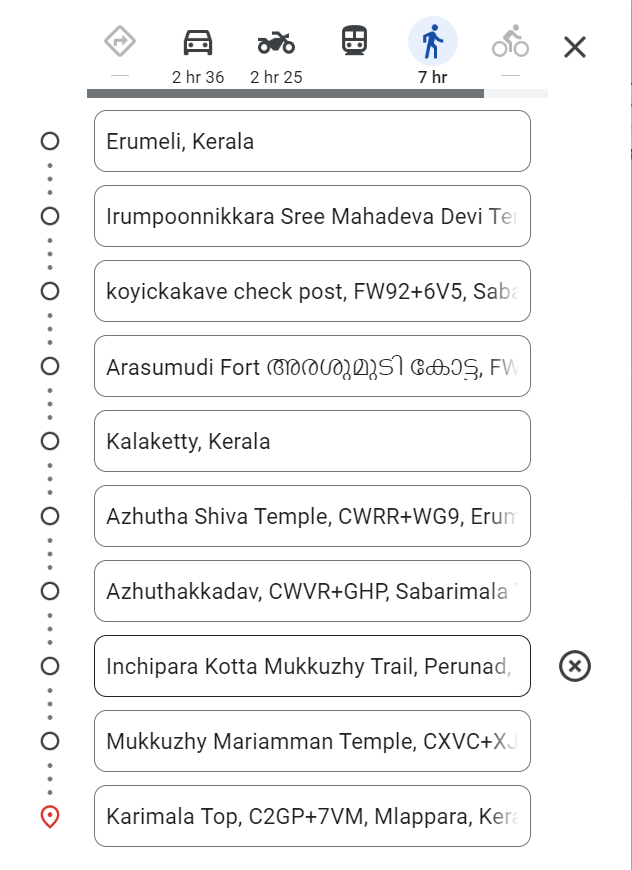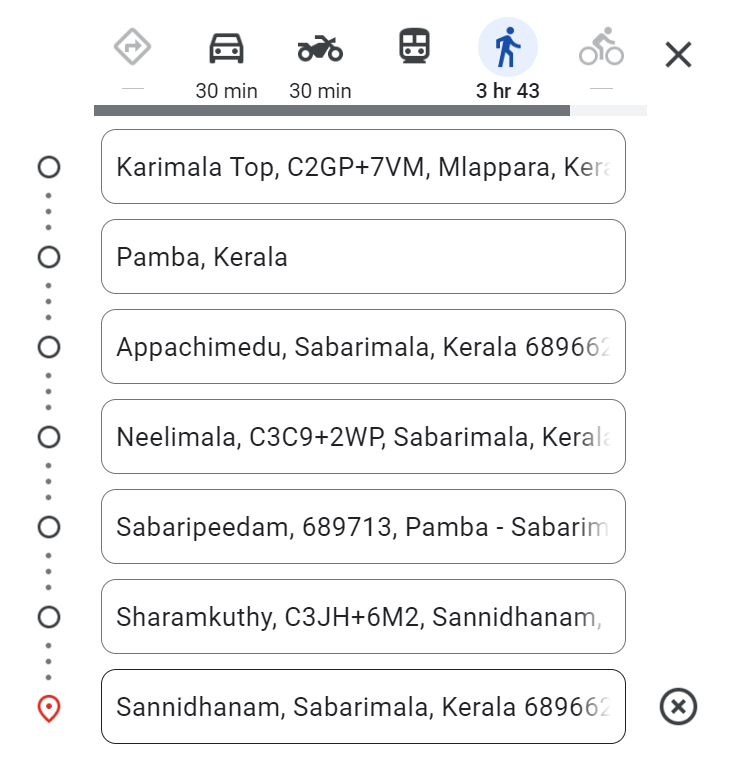This is the 3rd part of the series. This has details of the Yatra on the traditional route, the stops and significance of the places enroute
You can read the 1st part – Sabarimala Pilgrimage – Maladharana (click on the link below) which marks the beginning of Vrata for Sabarimala
You can read the 2nd part – Sabarimala Pilgrimage– Kettunira or Palli Kattu (click on the link below) which is the processes and rituals before embarking on the Yatra to Sabarimala
After wearing Mala and observing Vrata for a minimum of 41 days, with Irumudi Kettu Pilgrims begin their yatra from their homes to Sabarimala. It is also a practice by many Bhakta Sanghas to visit many temples enroute. But this article will stick to the Traditional Trekking Path of the Yatra from Erumeli.
Why is it called the Traditional route?
This path is called as traditional one (though it is just one of the three most used paths) as it is believed that Swami Ayyappan took this route on His slay Mahishi and liberate the world from her tyranny.
Devaswom, Akhila Bharata Ayyappa Seva Sangham and many other Sanghas operates Thavalams for Viri (resting) and serving Free medicated drinking water and also has Annadanam (Free Food) served to Pilgrims at various spots enroute the entire Traditional Trekking Path right from Erumeli upto Sannidhanam. There are also Devaswom approved Food and Refreshment stalls along the way.
Erumeli – Where it all Begins
The yatra begins in Erumeli, the first stop during the Pilgrimage. Ayyappas, Manikantas and Malikappuram stop over in Erumeli on the banks of River Manimala to perform the ritualistic dance called Petta Thullal. It is celebration of the Victory of Divine over Evil, slaying of Mahishi by Manikanta. The place gets it’s name from ErumaKolli (Eruma – Buffalo or Mahishi Kolli – Killed). It literally means the place where Buffalo (Mahishi) was killed. Devotees paint themselves in various colors and dress up as Tribals and dance, called Petta Thullal, to the rhythmic chant of Ayyappa Thinthaka Thom – Swami Thinthaka Thom. This Satvic dance is also a sign of Egolessness on part of the devotee with no care for their appearance (painting themselves all over the body), nor to “perform” a classical dance. It is just an act of letting go. They carry fake arms like wooden spear, dagger, swords etc and the first time pilgrim (called Kanni Swamis) would carry an Arrow made of wood (Sharam) which is retained after the petta thullal until it is placed in Sharamkutti Aal (a kilometer before Sannidhanam). This is explained later in this article.
Bhaktas after getting ready for the Petta Thullal proceed to Petta Shri Dharmashasta Temple (called Kochambalam – Small Temple) where they offer worship to Deity, which is Swami Ayyappan in Pettayil Dharma Shasta form.
After offering their prayers and seeking the blessings, bhaktas begin their Petta Thullal ritual to the chanting of Sharana Ghoshams and Ayyapa Thinthaka Thom-Swami Thinthaka Thom from Petta Shri Dharma Shastha Temple (Kochambalam = Small Temple) towards the Erumeli Shri Dharma Shastha Temple.
The Erumeli Shri Dharma Shasta Temple is about 600 meters away and the Bhaktas dancing to the chants on the entire route arrive at this temple
Petta Thullal during Makaravilakku and Traditions in Erumeli-Sabarimala
It is a long held and important tradition of two Yogams (Teams) one from Ambalapuzha (representing Ayyappa’s Mother, Bhagwan Vishnu as Mohini and hence represents Vaishnava Traditions) and another from Alangadu representing Ayyappa’s Father, Bhagwan Shiva as and represents Shaiva Traditions), to perform the petta thullal prior (End of Dhanur Masa) and reach Sannidhanam by Makarvilakku Festival (on 1st of Makara month). Both the teams are formally welcomed with complete honor by the Temple authorities since these two places are closely linked to Ayyappa Purana. They have been officially conferred the status by Pandalam Royal family through a decree by the Pandalam Raja. Though these two places are not part of the traditional trekking path, have written about the importance of these two yogams and privilges afforded to them in the Sabarimala scheme of things, in another article – Sabarimala Pilgrimage – Erumeli Petta Thullal by Alangadu and Ambalapuzha Yogam (Click on this link to read more about these two Yogams as it is worth knowing the significance of Petta Thullal Ritual. Ambalapuzha Yogam performs the Petta Thullal first, followed by Alangadu Yogam. Both the teams would then rest overnight in Erumeli Shree Dharma Shasta Temple (called Valiyambalam – Big Temple) and then proceed towards Pamba on the traditional trekking route (this article is more about this)
You can read more about Alangadu and Ambalapuzha Petta Thullal ritual, Sabarimala Pilgrimage – Erumeli Petta Thullal by Alangadu and Ambalapuzha Yogam (click on the link below)
Perur Thodu
Setting off from Erumeli, we first come across Perur Thodu, (Perur River_. In the earlier days about, this was the last place of human inhabitation and border of the thick and dangerous Forest, what is known known as Poongavanam. When this author did the traditional trek last, it was true to its name, Ayyappa’s Poongavanam – lush green vegetation and lot of flowering shrubs, a treat for our eyes.
This is also the place where Swami Ayyappa rested before embarking on His journey. The resting places enroute are called Thavalams. Earlier a forest foot-track this route today is an asphalted road from Erumeli and almost a Plain. Beyond Perur Thodu begins the arduous ascending Trek towards Kalaketti
It is an essential practice by Kanni Swamis to offer Ari Podi (Rice Powder) to fishes in Perur Thodu. And also to give alms to unfortunate.
Irumboonikkara
Then next stop before the Kalaketti is Irumboonikkara where there are two temples. One for Bhagwan Shiva and Murgan (Karthikeya/Subramanya) and another for Shree Bala Bhadra. This place has decent facilities and also refreshment stalls. Irumboonikara (Irumbu=Iron; Ooni = Lean/Dig; Kara = Place) is the place where Swami Ayyappa and His troops kept their arms like Sword, Spear, Bows and Arrows (made of Iron) aside to take rest.
Apart from these places of worship and it being a resting place after about 3kms of uphill trek, there is no other puranic significance to Irumboonikkara to my knowledge.
After Irumboonikkara, we cross the Koyikakavu Forest Check post where the guards take your details and issue passes to continue the Pilgrimage through the Traditional Trekking path.
Arashumudi Fort (actually Arasumudi)
The actual location is Talaparamala and popularly known as Arasumudi Kota (Arasu = King; Mudi = Peak; Kotta = Fort). It was ruled by Tribal Kings who were known for their fairness and justice. However the forest Marauder Udayavan defeats the king and annexes it to his Karimala reign. Ayyappa during this journey for sojourn to kill Mahishi defeats Udayavan’s battalion and restores the Kingdom to Tribals. He and His troops also rest here for a while before they continue their march.
It has small temples for Swami Ayyappa & Subramanya Swami. Another popular stopover just for the energy these small temples bring to you.
Kalaketti or Kalaketty
It was a welcome break after the difficult trek (atleast we thought we were past the most arduous part) is lovely forest shrine Kalaketty which is 6 kilometres after Perur Thodu. Kalaketty (Kala = Bull; Ketti = Tied) means the place where bull was tied. Mahishi had a boon that she could only be slain by someone who was not more than 12 year Old and someone who is offspring of Bhagwan Shiva and Bhagwan Vishnu. Consdering the impossibility of this, 12 year old subduing her prowess and strength and Biologically (Offspring of Shiva and Vishnu) she became very notorious. She had usurped Devaloka and occupied Indra’s throne. Bhagwan Shiva was enomoured by sight of Mohini (Avatara of Bhagwan Vishnu) and their union resulted in birth of Manikanta, name while Ayyappa was born. Avatara Lakshya of Swami Ayyappa was slowly but surely being achieved. Bhagwan Shiva had come on the bull and tied it to a banyan tree when His son, Ayyappa – then a small 10 year boy, Manikanta, was fighting the battle with Buffalo Demoness, Mahishi.
The Pilgrims offer their worship to Shiva, Parvati & Ganapati & seek their blessing before proceeding further towards the more arduous Azhutha Medu Trek. As a ritual, pilgrims lighten camphor and break coconuts here.
Azhutha River & Azhutha Medu
We then descend slightly towards Azhutha River (Azhutha Kadavu). Azutha is a tributary of Holy Pamba. Kalaketti to Azhutha is almost a plain and hence not so arduous compared to what awaits us from here on.
After Holy dip in Azhutha, (in the earlier days, we had to cross the river on foot) we cross the bridge to proceed towards Azhutha Medu. During the dip, Bhaktas pick up the first stone/pebble from the river they lay their hands on and carry it with them for dropping it on Kallidum Kunnu (Explained later).
Pilgrims then offer their prayers to Bhagwan Shiva in Azhutha and pray for His blessings for the arduous trek ahead
The most strenuous part of the Traditional trekking path is this stretch upto Karimala Top. As the popular Veeramani Song goes “Karimala Ettram Katinam Katinam” – the lines truly is representive of this. Pilgrims are not allowed during the off-season (monthy puja days) to take this route and also to trek between 4pm (evening) until 7am in the morning, since this forest is inhabited by wild animals and there are known cases of fatalities due to wild animal attacks.
Kallidam Kunnu
After resting adequately in Azhutha base thavalams, Pilgrims proceed on Azhutha Medu, the uphill ascent when even a non-believer would plead for grace of Swami Ayyappa to help one climb successfully. About 2km from the base camp (as indicated by the signage above, we arrive at Kallidam Kunnu (which literally means a hill where stones are dropped/placed). The stone/pebble picked up during the dip in Azhutha River is dropped here on Kallidam Kunnu)
After Manikanta subdues and kills Mahishi the she-buffalo at Kalaketti, He flings the deadbody up in the air, which lands in the spot which is currently Kallidam Kunnu. He then gets everyone in the troop to cover it up with stones from Azhutha river so that Mahishi, the evil becomes invisible even in the dead form. With millions of Pilgrims dropping the stones here to cover Mahishi it has now become a small mountain (Kunnu)
Dropping of stones here is to ensure that evil never raised its hood again and also signifies shdedding of one’s rock-solid ego. Ego is not so easily subdued and keeps growing again and again. Hence more and more stones are dropped on it to subdue it.
There is another legend that the forest marauder Udayavan, a symbol of nuisance and destroying. Humans and animals plead with Ayyappa for help which the ever-benevolant Ayyappa agrees to. In the meanwhile Udayavan hears about exploits of child Manikanta and develops a fear that sooner or later he will reach there. He begins to erect lot of obstacles and also built fort around Karimala, his base including a moat to deny route for the marching army. It is believed that wooden logs (roots of trees), stones etc. was dropped by the troops led by Karuppa Swamy and Kadutha Swamy (the tribal chieftains) and also his Bhoota Ganas over these obstacles, so that the troops can march on to Inchiparakotta, which was the next stop.
Inchirparakotta & Udumparakotta
Pilgrims then come to Inchippara Kota (Inji = Ginger, Para = hillock, Kota = Fort, which means Ginger shaped fort on the Hillock). Very close by is the Udumparakotta (Udumbu = Iguana, Para = Hillock, Kota = Fort, which means Fort on the Iguana shaped Hillock; Another meaning Udumpara = Fig), which is not in the circuit anymore (since only some remnants exist and it is almost forest now). Inchipara Kota was ruled by Udumpara Villan, a brave and valiant tribal warrior. However his army was no match for Udayavan’s and hence was defeated and annexed by Udayavan and thereafter ruled by his trusted lietuanant Pudussery Mundan.
A fiece battle take place between Ayyappa’s forces led by Karuppa Swami, a Tribal Chieftain, along with the Alangadu, Ambalapuzha and Pandalam Troops and Udayavan’s troops led by Pudussery Mundan. Finally Udayavan’s army was defeated resoundingly and the tribal regime was restored. Pudussery Mundan flees from the battles for his life into the forest. It was also a moment of reckoning for Udumpara Villan, who gets totally transformed into Divine being. He was then elevated to the state of a Demi-God and it is customary for Pilgrims to offer their prayers and seek his blessings.
We were met by a friendly Thirumeni (Priest) who was very helpful and also spent time explaining the legend behind not only this place but also many other places on the traditional trekking path. When we asked if the ascents and difficult part of the trek is over, he just gave us a nice smile and said, Swami Sharanam!
We descend from Inchippara Kotta, a slippery descent to reach Karimala Thodu (Karimala River), which is flanked by Azhutha Medu on side and Karimala Mountain on the other.
Mukkuzhi
The next big thavalam is in Mukkuzhi. Not so arduous trek as it is mostly a descent from Inchippara. Though no evidence is found, it is believed that Ayyappa and His troops rested here too. There are temples for Bhagavathi and Ayyappa Temples (this is clearly a recent temple)
Friendly guards also warn us about wild animals, especially elephants and other forest animals and not to provoke them in any manner. They also inform Pilgrims that Mukkuzhi has a motorable access and for those finidng it medically or physically tough to abort the trek and take the road to Pampa (Regular bus service from Kuzhimavu to Mudakayam). Guards tell us that it is very rare that Bhaktas do this.
NOTE: We can avoid ascents (Azhutha, Kallidam Kunnu & Inchippara Kotta route) and directly reach Mukkuzhi, by taking a different route from Kalaketti. For total experience please avoid this option and take the traditional route. Ayyappa walked this main path and every inch of the route adds to your spiritual elevation.
Kariyilam Thodu
After resting in Mukkuzhi Pilgrims then proceed downhill, a slippery slope towards Pudussery Kanam (Kanam = Forest). The stream flowing here is called the Kariyilam (Kari = Black, Ila = Leaves, Thodu = River) It is believed that the dry black leaves rendered it a color black (these days it is a very clear stream as can be seen in the pictures below)
Pudussery Mundan who had escaped from Inchirparakotta was hiding in Pudussery and challenges Kochukadutha during the march towards Karimala fort. After a fierce battle, Kochukadutha beheads Pudussery Mundan (A separate article for Legend of Kochukadutha will be written soon). In honor of his valor and fight for Dharma, He gets a special place in the Sabarimala legend. He also stays along with Swami Ayyappa near Manimantapam and is an essential upadevata to be worshipped. An injured Kochukadutha bathes in the Kariyilam thodu to relieve himself of pain and becomes fresh for marching on. This is exactly the effect it has on the Bhaktas doing this traditional path trek. A dip here amazingly freshens you up and also works as a recharge for our Journey on Karimala. This is also source of water for wild animals inhabiting this forest (Elephants, Tigers, Bears are quite common here), reason why authorities don’t allow Pilgrims beyond Azhutha Medu after 4pm (by the time Pilgrims reach here, it would late evening making it dangerous.
Karimala
After Kariyilam Thodu, Bhaktas continue for about 3kms arrive at foot of Karimala (Kari = Elephants, Mala = Mountain), called Karimala Nada (Nada = Entrance). Pilgrims pick a dry leaf and offer it here to Ganapathi, before proceeding further on the ascent. This is called Ila Ittu Vandanam (Offering respect with Offering Leaves). Karimala is most dense part of the forest and the most difficult stretch to trek. Karimala is also the Forest Department’s official grooming area for elephants.
This arduous trek of about 5km involves 7 peaks, and in each step of these 7 we tend to think we have arrived and done with, only to encounter another ascent which could be even worse. Swami Sharanam is something that we get reminded at each step we put forward. We also realise that we need Nature to help us explore Nature and we can never conquer it. It also has a corollary to a Jignasu’s (Seeker) quest for knowledge. More one knows, more they realise there an even more unknowns – a great leveller to those who think they have ARRIVED. Hitherto, including Azhuthamedu it involved a single stage of ascent but Karimala ascent is in 7 arduous and steep stages. We know realised the meaning behind the smile of Thirumeni in Inchirpparakotta and why he just replied Swami Sharanam when we asked if the arduous part of the trek is over
Karimala was the base of the forest Marauder Udayavan who had conquered and destroyed places of worship in and around the Mountains. He also had conquered Sabarimala Shri Dharma Shasta Temple and denied access to pilgrims. Swami Ayyappa and His troops aim included liberation of this temple. Udayavan banked on all the obstacles he had placed along the route for ensure his supremacy. However Ayyappa and troop surmounted this by placing stones and wood from the trees to reach Karimala kota. It was here that Udayavan was killed by Kochukadutha, liberating the forest and all temples and tribes from the evil marauder foever. One of the legend says that Kochukadutha was seriously injured and got maimed (losing both his legs) and had to be carried to Sabarimala on this march.
After trekking all the 7 stages of the Karimala range, we reach Karimala top where there are temples for Karimala Bhagavathi (Vana Durga), Karimalanaathan and Kochu Kadutha Swami.
Pilgrims, however strong, rest here for a while before proceeding towards the Karimala descent and Valiyanavattam. Decent arrangements for Viri (rest) is available here. Atop Karimala, there is a Nazhikinar (well) that is actually a fresh water spring. It is believed that when Ayyappa’s troops reached here and after defeating Udayavan, they were tired and desperately needed water. Villali Veeran Swami Ayyappa then shoots an arrow at this spot and miraculously a fresh water spring emerged which is perennial source of water in the well here.
It is customary to perform Azhi Puja (sort of a yagna kunda, resembling a campfire) in Karimala, to ward of wild animals and also for the cold weather. This is also an expression of gratefulness for all the warriors who fought with Swami Ayyappa and freeing the path from marauders to proceed to Sabarimala.
Experiencing it is believing. Each and everyone who has had the water from this spring well say that all the tiredness after trekking the 7-stage Karimala mountains vanished in a jiffy immediately after drinking the same. This is perfect example of how devotion, and medicinal effects of various unadulterated elements of forests, work on humans.
A dip in Azhutha and Kariyilam Thodu is believed to be curative and relieves Bhaktas of many diseases. Bathing in Kariyilam Thodu especially known to relieve Bhaktas of Rheumatism, skin ailments, breathing disorders among other diseases. The entire stretch in the Traditional Trekking path is laced with pure and powerful medicinal herbs and walking through these environs & breathing in air here itself has a permament curative effect.
Pilgrims then proceed for Karimala descent towards Pampa and Vazhukkum Para (Vazhukkum = Slippery; Para = Rock) is equally treacherous. Trust and bank on Swami Ayyappa to take you across safely, just as He did during the entire Pilgrimage.
Valiyanavattam & Cheriyanavattam
Pilgrims reach the next plain and arrive at Valiyanavattam. The sight of Pampa is refreshing and a point to note here. The current banks of Pampa where devotees bathe and proceed toards Neelimala and Sabaarimala is a recent development. Originally the Pampa used to flow via Valiyanavattam (which used to be the base camp) and Cheiryanavattam. With exponential growth in the number of Pilgrims year after year, Pampa was diverted to the current flow path to facilitate large number of Pilgrims to rest and also to have their holy bath and other Punya Nadi rituals (like Tharpana).
This brings us to the end of the Sabarimala Traditional Trekking Path. Hereon the paths merge (the Chalakayam route) and becomes common until Sannidhanam in Sabarimala.
Pampa Nadi (Pampa River)
This is the holy river associated with Swami Ayyappa and Sabarimala intricately. This sacred river is the longest river in Kerala and has 18 tributaries and ulimately merges into Arabian sea.
It was on the banks of Holy Pampa that Pandalam King Raja Rajashekara on his hunting expedition, found a Baby with a bell around it’s neck. Though childless he was in a dilemma whether to take the baby home or not. Maharshi Agastya advises him that it is indeed a Divine gift and take it to the Palace without any hesitation and gave it the name, Manikanta (Mani = Bell; Kanta =Neck). Sage Agastya arrived there and cleared his doubts by telling him that the child is a boon from the Gods and advised him to accept him.
Pampa is as sacred as Ganga and considered as Dakshina Ganga. and as we approach the banks , we find a Triveni – Confluence of 3 rivers – Kakki (Yamuna), Njunungar (Invisible Saraswati joining it from beneath) and then flows as Pampa (Ganga).
Rituals in Pampa
Pitrubali Tharpana is offered on the banks of the Holy Pampa. This is done by the Pilgrima to liberate the soul of a departed person in the family from the shackles of this wordly life and to help the soul achieve eternal peace.
Pampa Sadhya: Pilgrim groups prepare feast with the provisions taken from their Irumudi. Thousand of pilgrims are fed at Pampa during this ritual called Pampa Sadhya
Pampa Vilakku: Pilgrims believe that Lord Ayyappan will be present at the banks of Pampa during sunset and they decorate their viri sheds/cottages with lights and candles. Small floats decorated with lights are set on sail in the Pampa River
Arattu Maholsavam: The Siveli vigraham (Utsava Murti) is ceremoniously brought in royal procession from Sannidhanam to Pampa. At the Aarattu (Frolicking in Water) Kadavu at Pampa, the idol is given an abhishekam and a bath by immersion in River Pampa by the head priest. Enroute Pampa and back, the procession is enthusiastically elcomed at many points including the Ganapati temple at Pampa where special poojas are conducted. Araattu signifies the end of the temple festival or Utsavam.
Temples in Pampa
Neelimala
After offering our prayers in all the temples and then taking blessings from Pandalam Raja on the banks of Pampa, we proceed towards the 4 staged trek of Neelimala towards Sannidhanam.
Apachi Medu
Apachi Medu is almost atop the Neelimala Hill, about 2ks from Pampa. For those with an eye for Natural Scenic beauty and Mountains, it is a visual treat. Neelimala plunges into a scenic ravine and mesmerising valley view on both sides of the trekking path.
The valley on the left is called Appachikuzhi and one on the right is Ippachikuzhi. Pilgrims offer Ari Unda (Rice ball) by flinging it into the Appachikuzhi. This is believed to be done to please Kaduvaran, another warrior disciple of Swami Ayyappa who holds Spirits in check and prevents troubling Pilgrims. It is also to pacify the spirits (Bhoota Ganas). In the earlier times, it also served to distract wild animals so that they don’t come on to trekking path endangering Pilgrims.
The trek from Apachimedu to Sabaripeetham is considered most difficult in the entire journey. Signages and Volunteers advise Pilgrims to rest adequately and complete this stretch. Though the path has been surfaced in recent times, it is still arduous trek on this stretch
Sabaripeetham
This is the place where Shri Rama’s ardent devotee, an elderly woman Shabari got Moksha from the curse of her husband that turned her into a hunter. She meditated for years together and was waiting for Shri Rama to appear and redeem her from the curse. During the wait she used to pluck Berries and taste each one of them. If it were good, she put it in her basket to give it to Rama. She never bothered that it is considered “discarded fruit” the moment one tastes it (After consumption by us it is never offered to God as it is considered ashaucha-unclean). Her devotion was such, she wanted Rama to get the best. Shri Rama was pleased with her devotion and restores her into her original form. Sabarimala also gets the name after this great devotee of Shri Rama, Shabari.
Marakkoottam
Marakkoottam is the point where both the routes – “Swami Ayyappan Road” and Appachimedu route from Pampa merge. It is also the point where the onward routes diverge, one directly towards Sannidhanam on Chandranan Road) and another to Sannidhanam via Sharamkuthi Aal.
Marakkoottam technically marks the end of all ascent (if one is taking the Sharamkuthi route you still have to manage a minor ascent) and it is plain or downhill to Sannidhanam. We can hear fireworks (Vedi Vazhipadu) and songs being played in Sannidhanam after walking a small distance from Marakkoottam, bringing a lot of relief, eagerness and joy.
Saramkuthi Aal (Banyan Tree where Arrow is Pierced)
All the weapons that were part of Petta Thullal accessories, epecially the Sharam (please check the section on Erumeli) are left here. This is also replication of what troops led by Swami Ayyappa did after liberation of the Shri Dharma Shasta temple. They discarded all their weapons here. Kanni Swamis who carried a Sharam (arrow) during Petta Thullal, leave it here to mark their presence as Kanni Swami. During the Sabarimala Utsavam, annual 10-day festival held during Malayalam month of Meenam (March/April), Swami Ayyappa will be brought in a ceremonial procession to Saramkuthi as a part of Pallivetta (Royal Hunting) and then proceed to Pampa for Aaraattu.
Sannidhanam
And FINALLY! We are THERE! Close to culmination the purpose of this Tapas beginning with Maladharana. Sannidhanam is a mini township with some basic facilities for Pilgrims in queue waiting for Darshan, restaurants, resting booths and so on.
Pathinettam Padi (Holy 18 Steps)
Only Bhaktas who have undertaken and Vrata and performed the Kettunira and with Irumudi is allowed to go up the Holy Pathinettam Padi. However, those without Irumudi can have Darshan from the back entry. Please do it the traditional way, by being in Vrata and coming with Irumudi and then going up the 18 Steps. The spiritual transformation of every Pilgrim is complete only when you have Darshana after going up the 18 Steps.
Significance of Pathinettam Padi
While there are many interpretations, this article discusses the popular significance as explained by his 1st Guruswamy (Author’s Father). The 1st 5 steps signified Panchendriyas (5 Human sense) – Sight, Hearing, Taste, Smell and Touch. A Bhakta has to transcend the distractions through these 5 senses to progress in their spiritual pursuits. Ashtaragas or 8 emotions are associated with the next 8 steps. 8 emotions that are obstacles to a Sadhak in achiveing their spiritual goals are – Kama (Lust or Sensual pleasure), Krodha (Anger), Lobha (Greed), Moha (Excessive Desire or Attachment), Madha (Arrogance or Excessive Ego, or sense of “I/Me/Myself”), Maatsarya (Envy or Jealousy), Asooya (Malice), Ahankara or Darpa (Excessive Pride). The next 3 steps signifies the Trigunas (3 Tendencies or Qualities of Energies) – Sattva, Rajas and Tamas. The last two represents Vidya (Knowledge) and Avidya (Ignorance).
The other association is to 18 hills in the Sabarimala Circuit, associated with Swami Ayyappa. Each step representing each hill – Ponnambalamedu, Gaudanmala, Nagamala, Sundaramala, Karimala, Mathangamala, Mayiladummala, Sreepadamala, Thevarmala, Nilakkalmala, Thalapparamala, Chittambalamala, Ghalkimala, Puthusserymala, Kalakettymala, Inchipparamala, Sabarimala and Neelimala.
Do we need any further explanation as to why it is so important and beneficial to go on a pilgrimage after vrata and with Irumudi kettu which allows you to go up the Pathinettam Padi for Darshana of Swami Ayyappa?
Karuppu Swami and Karuppai Amma
On the right side of Pathinettam Padi (as we face), we can find Upadevalaya for Karuppu Swami and Karuppai Amma. This couple, along with Valiya Kadutha Swami (See next section) are considered the Dwarapalakas of the Shrine. They ensure that the temple is not defiled by anyone and protect the Shrine.
Karuppu Swami was one of the Tribal Chieftain from the forest on the Traditional trekking paths who lef one of the troops of Swami Ayyappa during His march for liberation of Shri Dharma Shasta Temple. After the mission was accomplished, he pleaded with Swami Ayyappa to let him remain there and continue to safeguard the precincts to which He agrees.
Valiya Kadutha Swami
On the left side of Pathinettam Padi (as we face), we can find Upadevalaya for Valiya Kadutha Swami. Pandalam Kingdom was protected by 6 Kalaris established by the King (since it was prone to frequent attaks from enemies. (Thalapara Kalari; Injipara Kalari; Pulikkotu Kalari; Kandanmedu Kalari; Pashupara Kalari and Melepara Kalari). All these Kalaris were headed individually by very skilled martial art experts who in turn worked under overall supervision and leadership of Valiya Kadutha Swami. (Valiya = Big or Chief). For his contributions to the Divine mission of Swami Ayyappa he was considered as a demi-god and given a position in Sannidhanam. Legend of Kochu Kadutha Swami (Explained later in this section) is closely associated to Valiya Kadutha Swami
Garbha Girha (Sanctum Sanctorum)
Not writing much about this since every Bhakta knows about the legend and also the very purpose of the Pilgimage is for the Punya Darshana of Kaliya Varada and Pratyaksha Deva Shri Dharma Shasta Swami Ayyappa. A separate article will be written on the rituals and procedures to be done after Darshanam and ingredients of Irumudi Kettu.
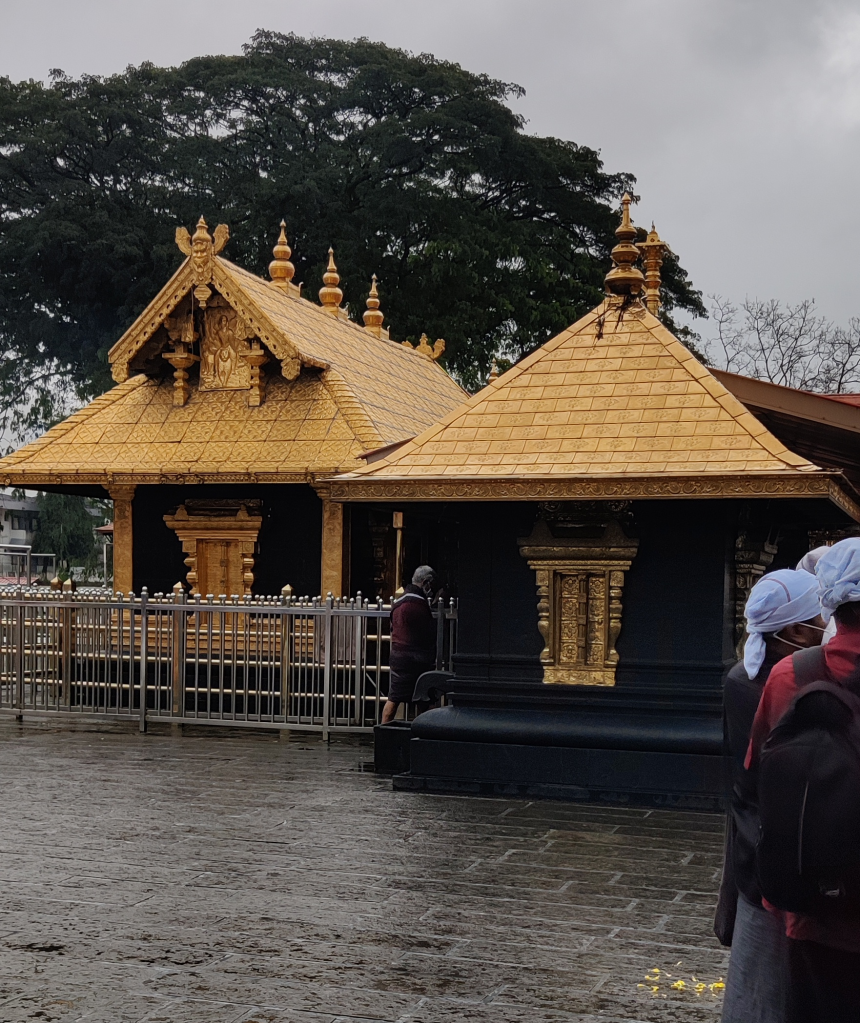
On the Right is Garbha Upadevalaya of Kannimoola Ganapati
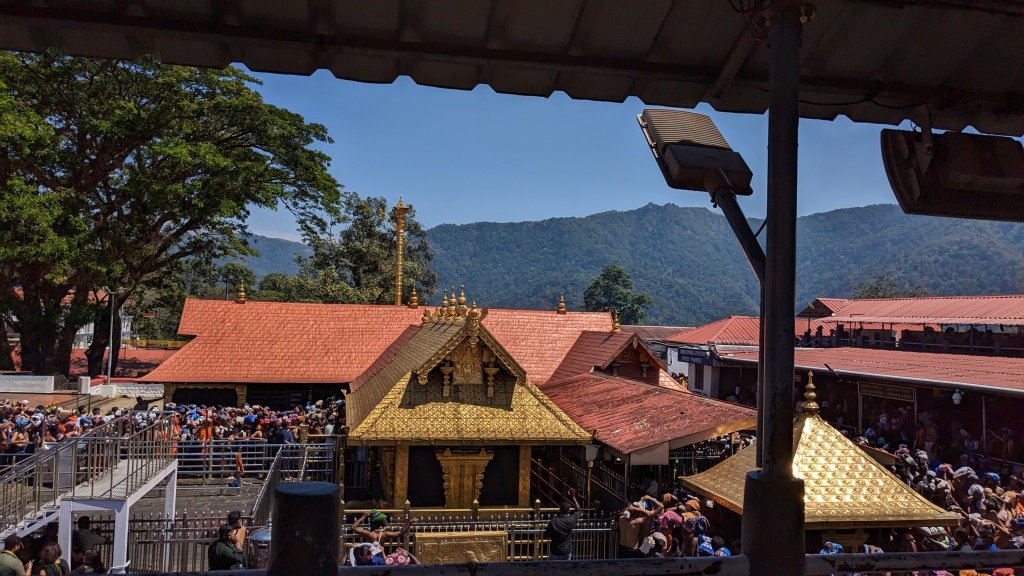
On the Right is Garbha Upadevalaya of Kannimoola Ganapati
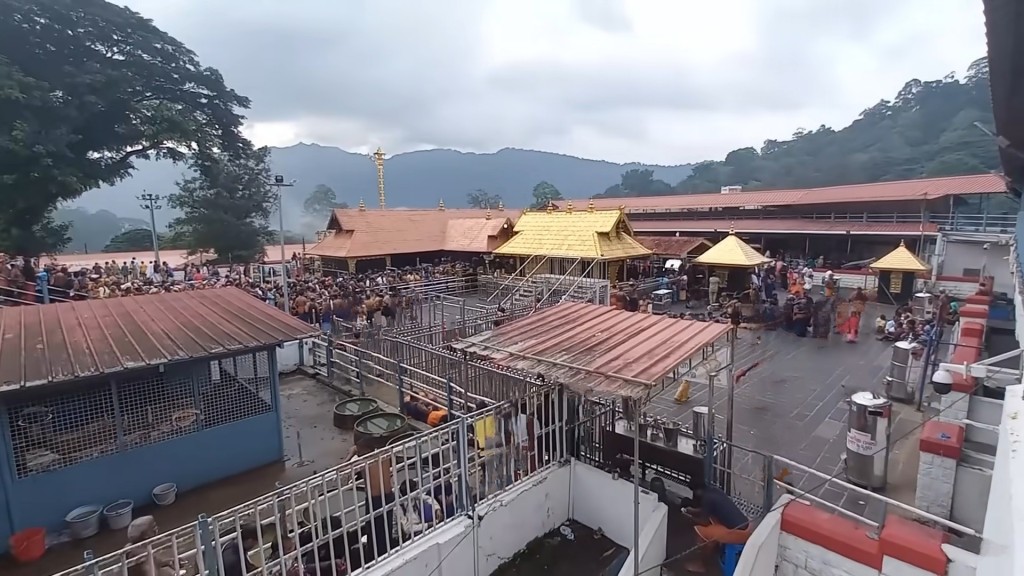
(From L-R) Swami Ayyappa Sree Kovil & Temples of Kannimoola Ganapati and Nagaraja
Bhasmakulam
Bhasmakulam (Bhasma – Sacred Ash; Kulam = Pond) is the temple Pond or Pushkarini of Sabarimala Shri Dharma Shasta Temple. After the dip in Pampa and arduous Neelimala and Apachimedu trek, Bhaktas smeared with Bhasma on their forehead and parts of the body, have a dip in this Temple pond. With lakhs of Pilgrims bathing here, it left Bhasma powder as well as aroma, a possible reason why it is called Bhasmakulam. Since it is not a flowing water, it is periodically cleaned and drained by the authorities.
Viri (Spread): After Darshana devotees find a place to spead their mat and keep the Irumudi for further actions on the ingredients. It is also time for tired Pilgrims to rest. Decent accomodation (not 5-start types) allocated by Devaswom exist and our team have the Viri generally in the room for the past few years now.
Irumudi is opened and Ingredients (Check my Article on Kettu Nira for details on what is in Irumudi) taken out for next actions with the ingredients.
Ghee filled cocunut (Mudra Thenga) is broken carefully and ghee emptied into a vessel. This would be taken to Sannidhanam for Abhisheka (Neyabhishekam for Swami Ayyappan). The ghee is used to give a ritualistic bath to the main Murti of Swami Ayyappa in the garbha griha and some ghee is collected back from the murti and given back to us as prasada. The Coconut is then offered in the Azhi to be consumed by Agni (Fire). This Azhi originally used to be a Homa Kundam right in front of the temple and perpetually aflame due to Ghee laced Coconut offered into it by Pilgrims. Due to ever increasing crowd Homa Kundam was moved down to base of Sannidhanam opposite Pathinettam Padi (in the current location, opposite Aravana and Appam Prasada Counters).
There are many legends associated with this much revered Devi whose shrine is located in the Malikapuram complex, about 100 meters North of Sannidhanam (on the left side of the Swami Ayyappa Murti). Not reproducing them here to avoid repitition of information
Malikapuram Temple Complex
You can also see Pilgrims rolling the coconut over during pradaskhina (circambulation of the Garbha Griha), instead of the usual procedure of breaking it temples. I am yet to see any scriptural validation to this process and what is the significance. If anyone is aware please let me know.
Manimantapam – The Moolasthana of Swamy Ayyappa
This is the location where Swami Ayyappa went into most Profound Yogic state – Jeeva Samadhi and merged with Shri Dharma Shasta. Since He emerges from this state for just a day on (Makara Vilakku Festival), there is no Puja performed for the rest of the year, in order not to disturb Him. Manimantapam is opened for 6 days in a year. In the past, Sabarimala was opened and Pilgrimage was performed only on these 6 days. Opening for Mandala season + Makara Vilakku season and then for first 5 days of every Malayalam month is a more recent phenomenon. A Kidavilakku (lamp that doesn’t get extinguished) continously is lit inside the Manimantapam. Manimantapam is considered the Moolasthanam (the Chaitanya or Consciousness of the Deity is based here). Kalamezhuthu (Kalam – Rangoli or Design with Organic Color Powder; Ezhuthu = Drawing) & Ezhunallath (Procession). Kalamezhuthu is design of Ayyappa in different postures & forms.
Would like to clarify a particular point mostly misunderstood and propagated on various medium (including websites, Television channels) during Makaravilakku festivities in Sabarimala. This is directly based on inputs from member of Shri Kunnakkattu Kurup family who hold hereditary rights to perform rituals in Manimantapam. Contrary to what is generally told and believed, Ezhunallath ritual from Malikappuram to Saramkuthi is of Swami Ayyappa from Manimantapam and not of Malikappurathamma.
As can be seen in the photographs below, they carry Thidambu (Thidambu = Replica of the Deity for Procession and Fesitivities) of Ayyappa, received from Pandalam Palace along with Thiruvabaranam. Ayyapa here is in an unique form – He has a Moustache and Eyes are Embedded Emerald). Thidamba is flanked by flags/insignia of Thalapparamala (Gold colored semi-spheres and other shapes cut and pasted on Red Fabric) and Udumparamala (Silver colored semi-spheres and other shapes cut and pasted on Black Fabric). Both these flags also are part of Thiruvabharana boxes. Other item is Nettipattam (Caprison) used on elephant’s trunk.

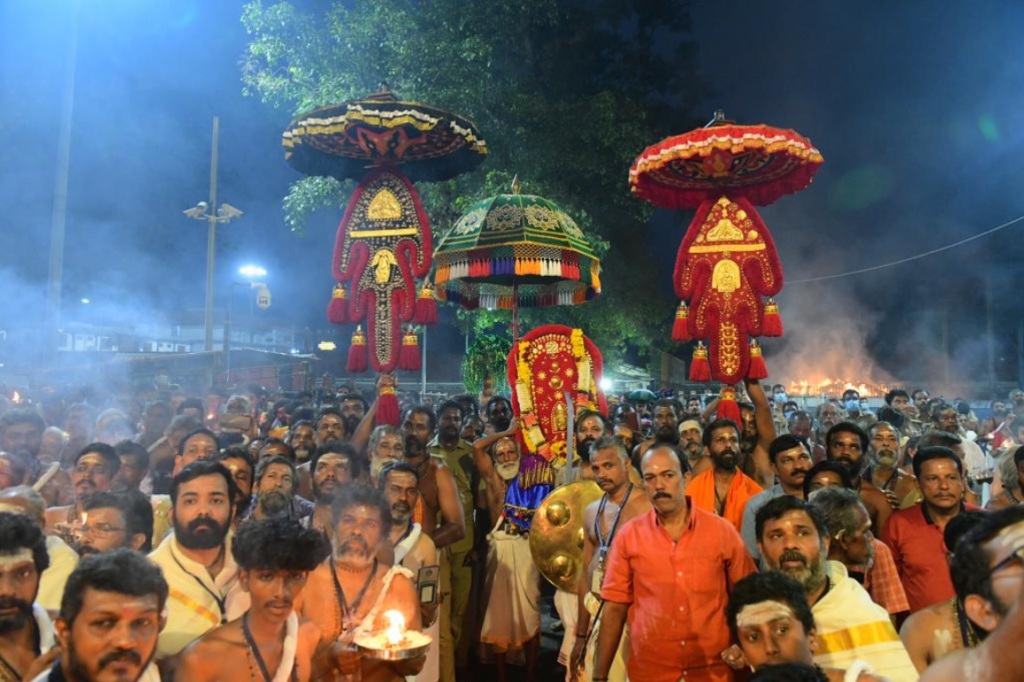
For 4 days after Makaravilakku Swami Ayyappa is taken from Manimantapam to Pathinettam Padi where they perform a ritual called Nilapadu Nilkkal (Ayyappa in imaginary Listening Stance) and receiving complimentary tribal songs called Vettavili (Story of Ayyappa and His Valor in Folk style). On the 5th day the procession proceeds from Pathinettam padi to Sharamkuthi with Theevetti (Ceremonial Torches), Sharanaghosham, ceremonial music – Pandi Melam, Panchavadyam etc. Nilapadu Nilkkal and Vettavili is performed in Saramkuthi and while returning without all these accompaniments (MISTAKENLY propagated firstly that ezhunallathu is for Malikappurathamma and secondly that all celebratory accompaniments are out of place because Malikapuratthamma is disappointed to find so many Sharams and hence presence of Kanni swamis that year, thereby her marriage to Ayyappa cannot happen)
Other temples in Malikapuram comple are that of Nagadevatas and Nagayakshi, Navagraha.
Parakotti Pattu (Para = Percussion Instrument seen in the pic; Kotti = Playing; Paattu = Song) is a ritual that has been practiced over the years at Sabarimala. This devotional percussion is done to keep away various Doshams including the ‘Sani Dosham’ and has a legend attached to it. During the time of Palazhi Madhanam, Sani’s curse befell on Lord Vishnu. To protect him, Lord Siva and Parvathi took the form of ‘Velan’ and ‘Vedathi’ and sang remedial songs. In my initial Pilgrimages as a child, we used to find this near Pathinettam Padi which is now moved to Malikappuram Complex.
Sarpa Paattu (Song of Serpent) is a tradition folk art of Kerala, sung to the accompaniment of the string instrument seen in the photograph by singers from Pulluvar commnity and is a form of serpent worship to ward off ill-effects of Sarpa Dosha
Some clicks of the author’s Various Pilgrimages
This brings us to the end of this Article and is dedicated to the lotus feet of Swami Ayyappa for the benefit of Bhaktas and I sincerely hope it is useful and help them prepare for this Pilgrimage better. This article was completed after the author completed his 61st Pilgrimage to Sabarimala, with His grace and blessings (all Pilgrimages with Irumudi and via Pathinettam Padi) . All credits to Swami Ayyappa for anything useful andgood here. If there are any erors, I take full responsibility and would only be glad to amend the same.
Wishing you a very Happy Pilgrimage, Blissful Darshan and a safe return . May Swami Ayyappa’s Blessings be shoered on you and your near ones in abundance
NOTE: This article may tend to put you off due to description of arduousness and severity of the trek. The purpose of detailed description is to mentally prepare one for this sacred mission of one’s life, and not to take the vrata and austerities casually. Single minded Devotion and Dedication to Swami Ayyappa is of utmost importance for a fulfilling Pilgrimage.
Google Map Directions
You can click on the image for Google Map Directions on the Sabarimala Traditional Trekking Path and the Stops/Temples enroute. It is in two parts. Erumeli to Karimala Top. Karimala Top to Shri Dharma Shasta Temple Sannidhanam
ACKNOWLEDGEMENT
The author is ever grateful to some known and unknown Bhaktas who shared their pictures for use in this article. The best part of the gesture was that they did not want to be credited for it here (true with all the 6 Bhaktas who shared their clicks). They said “This is for benefit of all Bhaktas and hence it is Swami Ayyappas gift to all of us. Everything and anything for Swami Ayyappa”
|Swami Sharanam|

